Pismolabs Technology P1811AC Pepwave / Peplink / Pismo Labs Wireless Product User Manual Part 2 rev
Pismo Labs Technology Limited Pepwave / Peplink / Pismo Labs Wireless Product Part 2 rev
Contents
- 1. User Manual Part 1 rev
- 2. User Manual Part 2 rev
- 3. User Manual Part 3 rev
- 4. User Manual Part 4 rev
User Manual Part 2 rev
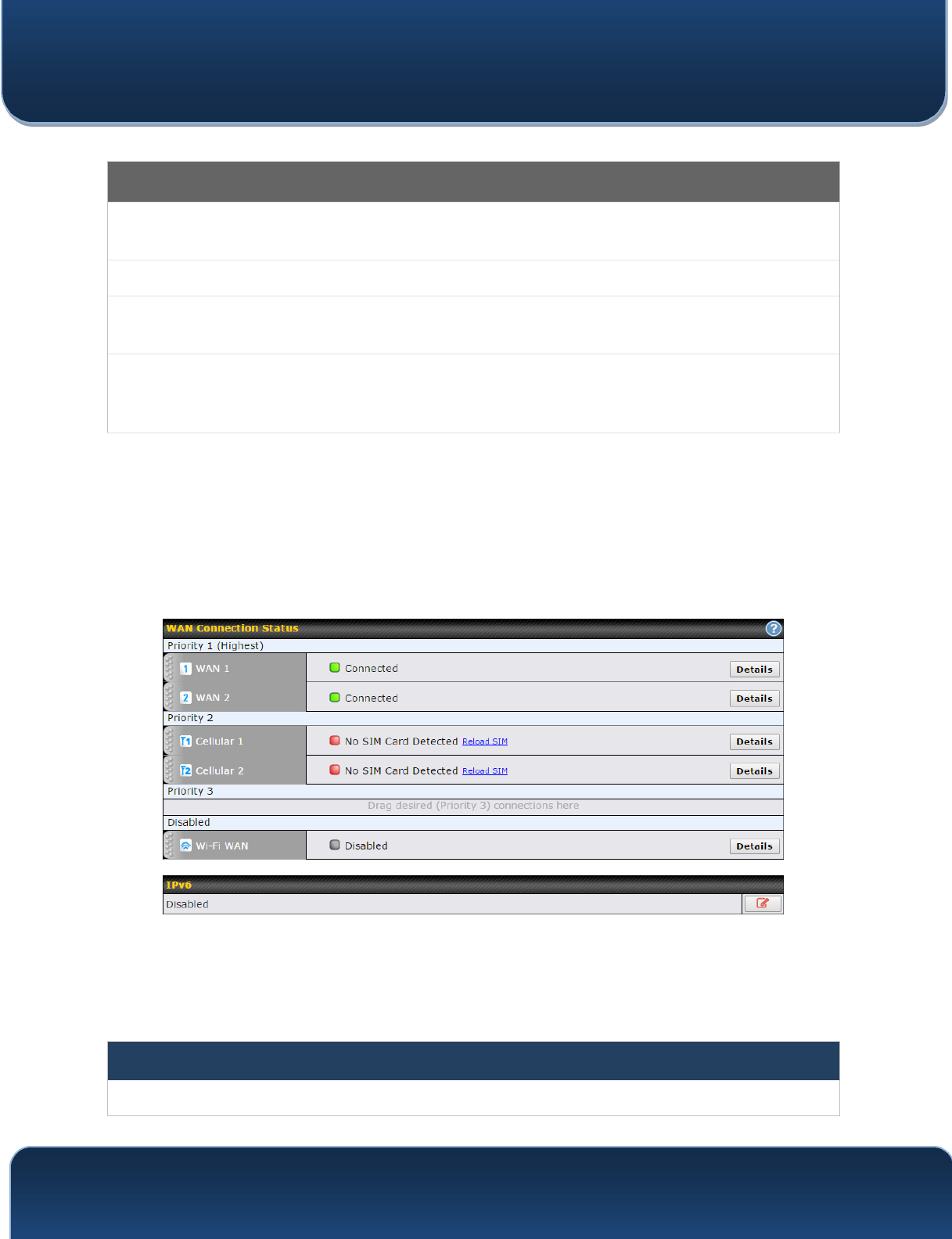
Pepwave MAX and Surf User Manual
http://www.pepwave.com 55 Copyright @ 2016 Pepwave
Portal Customization
Logo
Image
Click the Choose File button to select a logo to use for the built-in portal.
Message
If you have any additional messages for your users, enter them in this field.
Terms &
Conditions
If you would like to use your own set of terms and conditions, please enter them here. If
left empty, the built-in portal will display the default terms and conditions.
Custom
Landing
Page
Fill in this field to redirect clients to an external URL.
10 Configuring the WAN Interface(s)
WAN Interface settings are located at Network>WAN. To reorder WAN priority, drag on
the appropriate WAN by holding the left mouse button, move it to the desired priority
(the first one would be the highest priority, the second one would be lower priority, and
so on), and drop it by releasing the mouse button.
To disable a particular WAN connection, drag on the appropriate WAN by holding the
left mouse button, move it the Disabled row, and drop it by releasing the mouse button.
You can also set priorities on the Dashboard. Click the Details button in the
corresponding row to modify the connection setting.
Important Note
Connection details will be changed and become effective immediately after clicking the Save and Apply button.
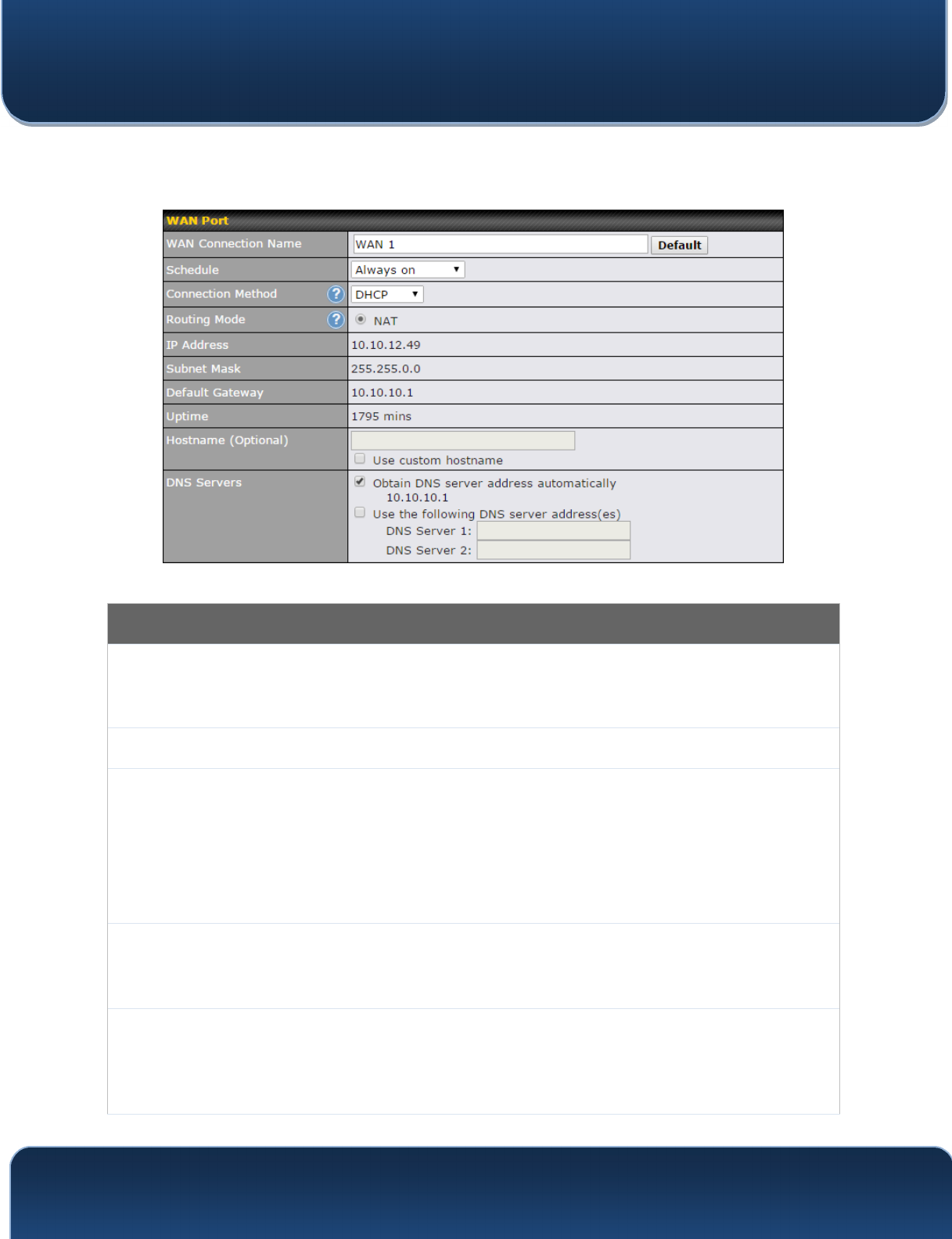
Pepwave MAX and Surf User Manual
http://www.pepwave.com 56 Copyright @ 2016 Pepwave
10.1 Ethernet WAN
From Network>WAN, choose a WAN connection and then click Details.
WAN Port (Section 1)
WAN
Connection
Name
Enter a name to represent this WAN connection.
Schedule
Click the drop-down menu to apply a time schedule to this interface
Connection
Method
There are three possible connection methods for Ethernet WAN:
• DHCP
• Static IP
• PPPoE
The connection method and details are determined by, and can be obtained from, the ISP.
See the following sections for details on each connection method.
Routing Mode
This field shows that NAT (network address translation) will be applied to the traffic routed
over this WAN connection. IP Forwarding is available when you click the link in the help
text.
IP
Address/Subnet
Mask/Default
Gateway
Enter the WAN IP address and subnet mask, as well as the IP address of the default
gateway, in these fields.
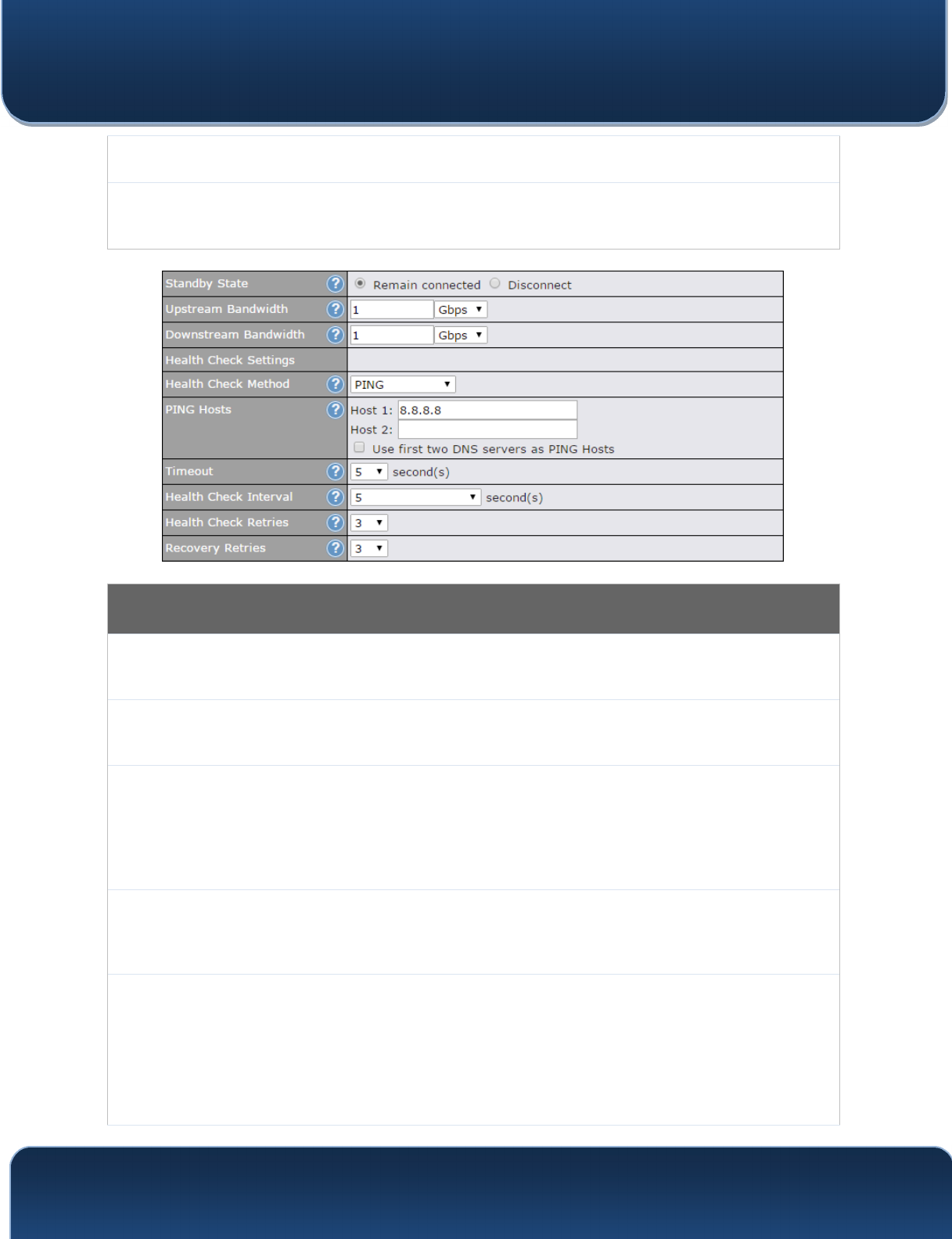
Pepwave MAX and Surf User Manual
http://www.pepwave.com 57 Copyright @ 2016 Pepwave
Hostname
Enter a hostname for this WAN port if needed.
DNS Servers
Select a DNS server for this port to use. This port can either be automatically selected or
manually designated.
WAN Port (Section 2)
Standby State
This setting specifies the standby state of the WAN connection. The available options are
Remain connected and Disconnect. The default state is Remain Connected.
Upstream
Bandwidth
This setting specifies the data bandwidth in the outbound direction from the LAN through the
WAN interface.
Downstream
Bandwidth
This setting specifies the data bandwidth in the inbound direction from the WAN interface to
the LAN. This value is referenced as the default weight value when using the algorithm
Least Used or the algorithm Persistence (Auto) in outbound policy with Managed by
Custom Rules chosen (see Section 15.2).
Health Check
Method
This setting specifies the health check method for the WAN connection. The value of method
can be configured as Disabled, Ping, DNS Lookup, or HTTP. The default method is
Disabled. See Section 10.4 for configuration details.
PING Hosts
These fields are for specifying the target DNS servers where DNS lookups will be sent to for
health check.
If the box Use first two DNS servers as Health Check DNS Servers is checked, the first two
DNS servers will be the DNS lookup targets for checking the connection healthiness. If the
box is not checked, the field Host 1 must be filled and the field Host 2 is optional.
The connection is considered to be up if DNS responses are received from any one of the
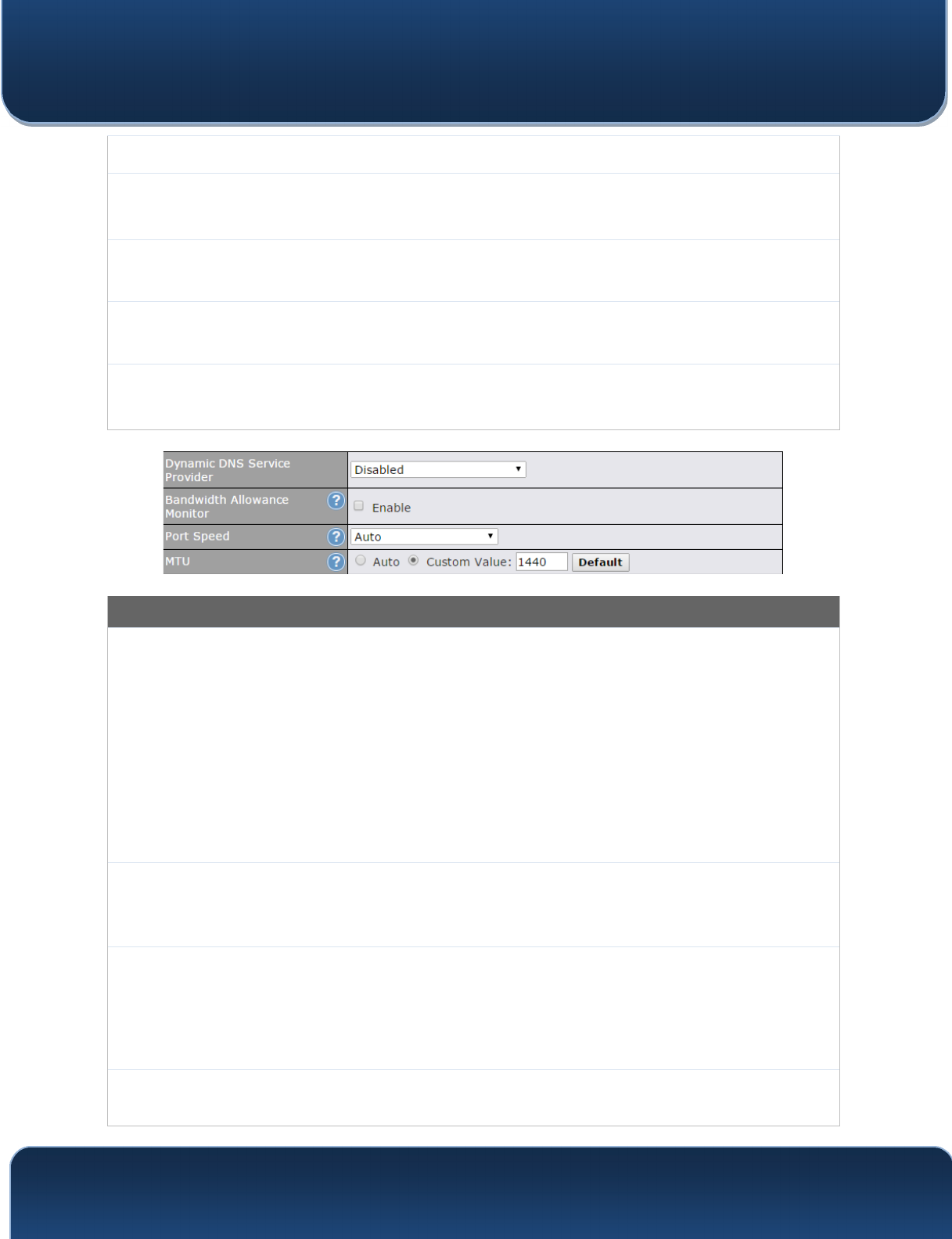
Pepwave MAX and Surf User Manual
http://www.pepwave.com 58 Copyright @ 2016 Pepwave
health check DNS servers, regardless of whether the result is positive or negative.
Timeout
If a health check test cannot be completed within the specified amount of time, the test will
be treated as failed.
Health Check
Interval
This is the number of consecutive check failures before treating a connection as down.
Health Check
Retries
This is the number of consecutive check failures before treating a connection as down.
Recovery
Retries
This is the number of responses required after a health check failure before treating a
connection as up again.
WAN Port (Section 3)
Dynamic DNS
Service
Provider
This setting specifies the dynamic DNS service provider to be used for the WAN based on
supported dynamic DNS service providers:
• changeip.com
• dyndns.org
• no-ip.org
• tzo.com
• DNS-O-Matic
Select Disabled to disable this feature. See Section 9.5 for configuration details.
Bandwidth
Allowance
Monitor
This option enables bandwidth usage monitoring on this WAN connection for each billing
cycle. When this setting is not enabled, each month’s bandwidth usage is tracked, but no
action will be taken.
Port Speed
This setting specifies port speed and duplex configurations of the WAN port. By default,
Auto is selected and the appropriate data speed is automatically detected by the Pepwave
router. In the event of negotiation issues, the port speed can be manually specified. You can
also choose whether or not to advertise the speed to the peer by selecting the Advertise
Speed checkbox.
MTU
This setting specifies the maximum transmission unit. By default, MTU is set to Custom
1440. You may adjust the MTU value by editing the text field. Click Default to restore the
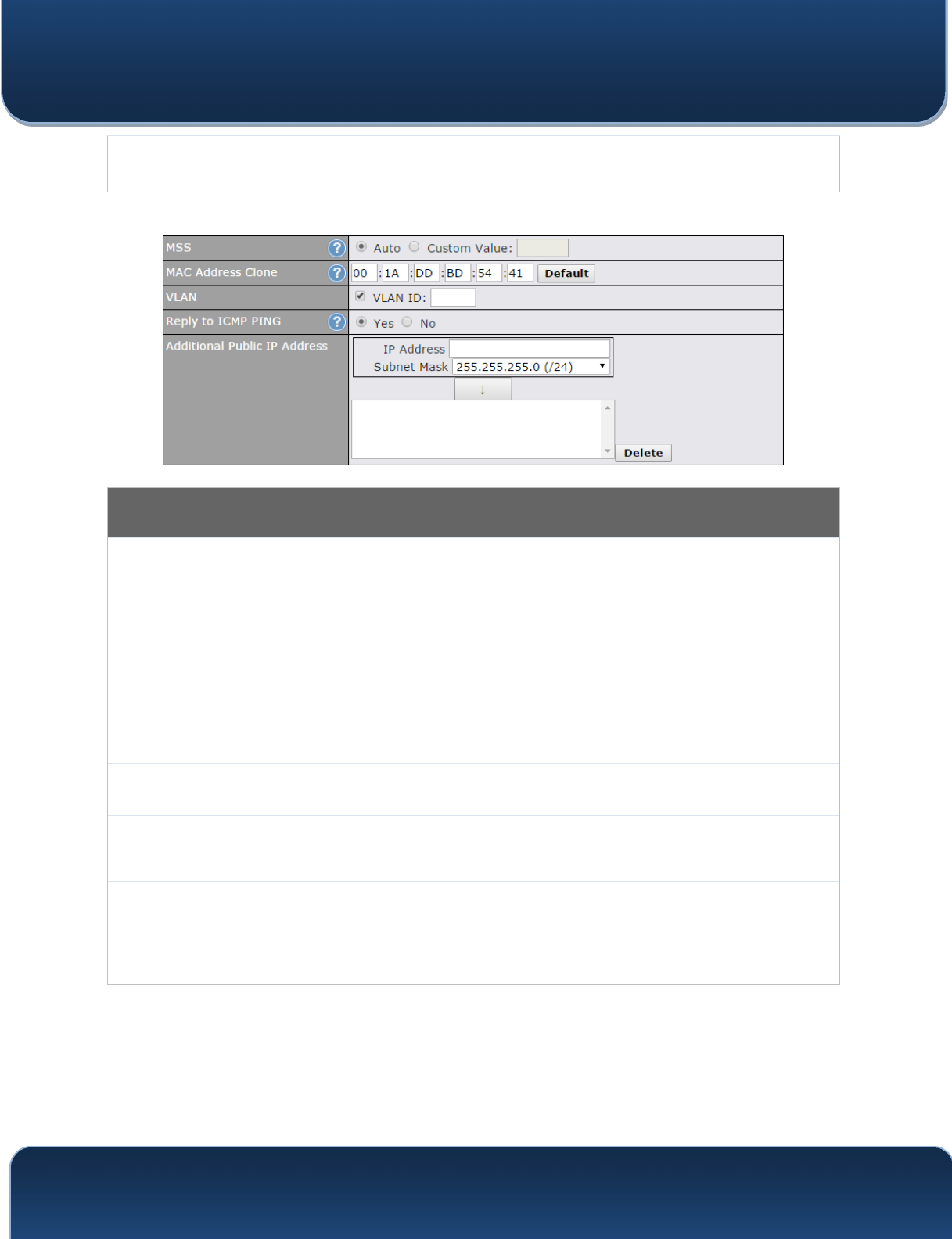
Pepwave MAX and Surf User Manual
http://www.pepwave.com 59 Copyright @ 2016 Pepwave
default MTU value. Select Auto and the appropriate MTU value will be automatically
detected. Auto-detection will run each time the WAN connection establishes.
WAN Port (Section 4)
MSS
This setting should be configured based on the maximum payload size that the local system
can handle. The MSS (maximum segment size) is computed from the MTU minus 40 bytes
for TCP over IPv4. If MTU is set to Auto, the MSS will also be set automatically. By default,
MSS is set to Auto.
MAC Address
Clone
Some service providers (e.g., cable providers) identify the client’s MAC address and require
the client to always use the same MAC address to connect to the network. In such cases,
change the WAN interface’s MAC address to the original client PC’s MAC address via this
field. The default MAC address is a unique value assigned at the factory. In most cases, the
default value is sufficient. Clicking Default restores the MAC address to the default value.
VLAN
Click the square if you wish to enable VLAN functionality and enable multiple broadcast
domains. Once you enable VLAN, you will be able to enter a name for your network.
Reply to ICMP
PING
If this field is disabled, the WAN connection will not respond to ICMP ping requests. By
default, this is enabled.
Additional
Public IP
Address
The IP Address list represents the list of fixed Internet IP addresses assigned by the ISP, in
the event that more than one Internet IP address is assigned to this WAN connection. Enter
the fixed Internet IP addresses and the corresponding subnet mask, and then click the
Down Arrow button to populate IP address entries to the IP Address List.
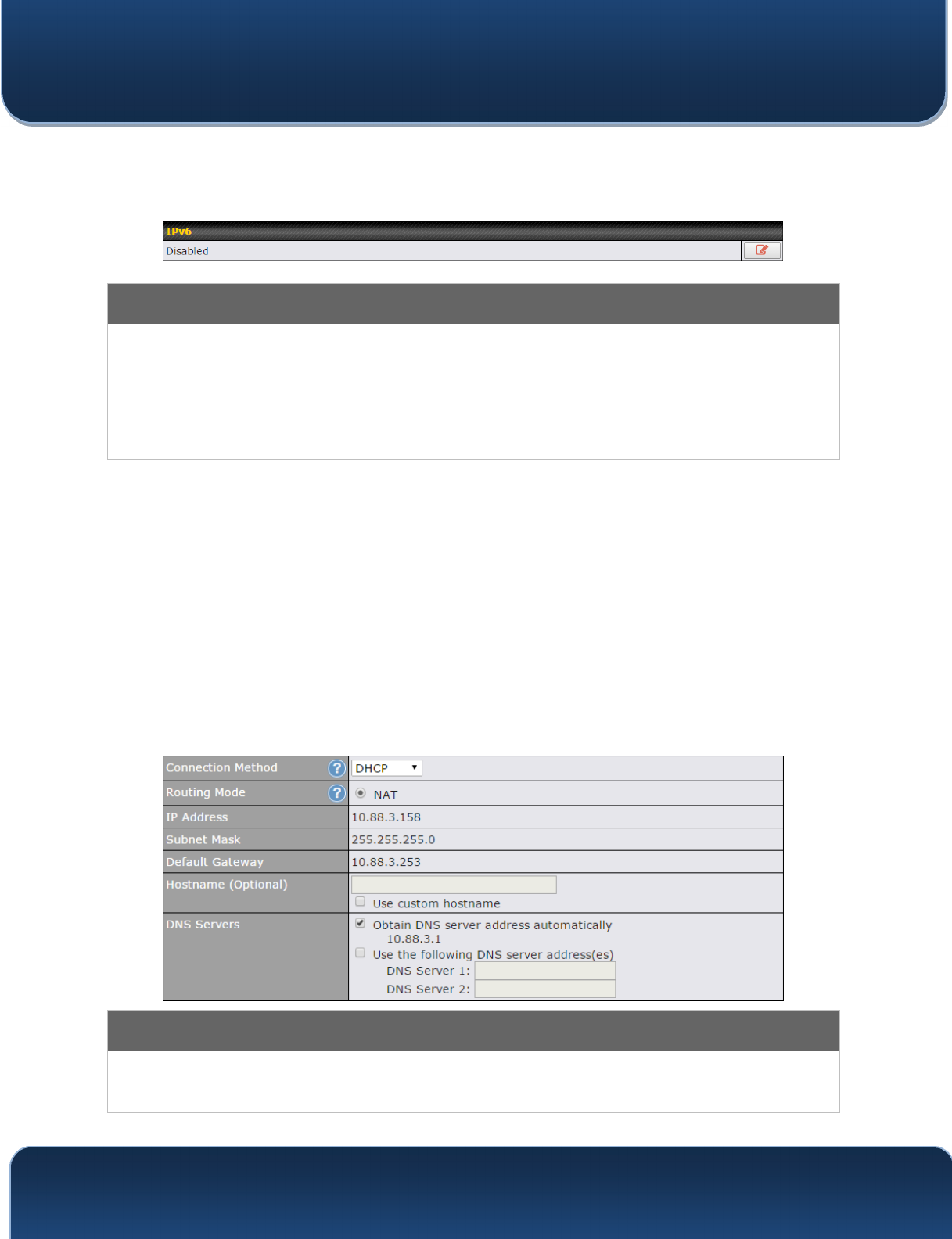
Pepwave MAX and Surf User Manual
http://www.pepwave.com 60 Copyright @ 2016 Pepwave
IPv6
IPv6
IPv6 support can be enabled on one of the available Ethernet WAN ports. On this screen, you
can choose which WAN will support IPv6. To enable IPv6 support on a WAN, the WAN router
must respond to stateless address auto configuration advertisements and DHCPv6 requests.
IPv6 clients on the LAN will acquire their IPv6, gateway, and DNS server addresses from it.
The device will also acquire an IPv6 address for performing ping/traceroute checks and
accepting web admin accesses. Note: This feature is only available on the Pepwave MAX 700,
HD2, and HD2 IP67.
10.1.1 DHCP Connection
There are four possible connection methods:
1. DHCP
2. Static IP
3. PPPoE
4. L2TP
The DHCP connection method is suitable if the ISP provides an IP address
automatically using DHCP (e.g., satellite modem, WiMAX modem, cable, Metro
Ethernet, etc.).
DHCP Connection Settings
Routing Mode
NAT allows substituting the real address in a packet with a mapped address that is
routable on the destination network. By clicking the help icon in this field, you can
display the IP Forwarding option, if your network requires it.
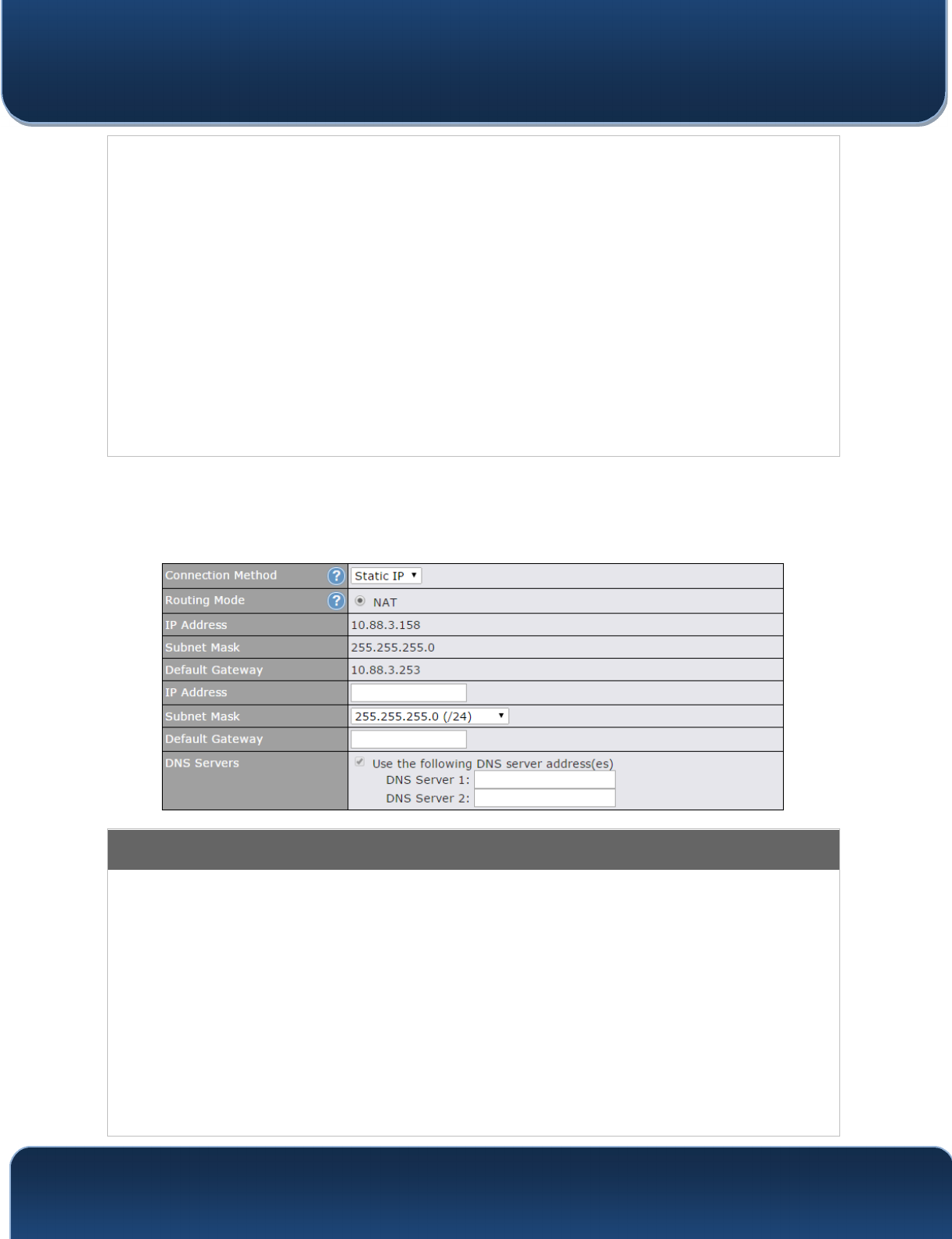
Pepwave MAX and Surf User Manual
http://www.pepwave.com 61 Copyright @ 2016 Pepwave
IP Address/
Subnet Mask/
Default Gateway
This information is obtained from the ISP automatically.
Hostname
(Optional)
If your service provider's DHCP server requires you to supply a hostname value
upon acquiring an IP address, you may enter the value here. If your service
provider does not provide you with the value, you can safely bypass this option.
DNS Servers
Each ISP may provide a set of DNS servers for DNS lookups. This setting
specifies the DNS (Domain Name System) servers to be used when a DNS lookup
is routed through this connection.
Selecting Obtain DNS server address automatically results in the DNS servers
being assigned by the WAN DHCP server to be used for outbound DNS lookups
over the connection. (The DNS servers are obtained along with the WAN IP
address assigned from the DHCP server.)
When Use the following DNS server address(es) is selected, you may enter
custom DNS server addresses for this WAN connection into the DNS Server 1
and DNS Server 2 fields.
10.1.2 Static IP Connection
The static IP connection method is suitable if your ISP provides a static IP address to
connect directly.
Static IP Settings
Routing Mode
NAT allows substituting the real address in a packet with a mapped address that is
routable on the destination network. By clicking the help icon in this field, you can display
the IP Forwarding option, if your network requires it.
IP Address /
Subnet Mask /
Default
Gateway
These settings allow you to specify the information required in order to communicate on
the Internet via a fixed Internet IP address. The information is typically determined by and
can be obtained from the ISP.
DNS Servers
Each ISP may provide a set of DNS servers for DNS lookups. This setting specifies the
DNS (Domain Name System) servers to be used when a DNS lookup is routed through
this connection. Selecting Obtain DNS server address automatically results in the DNS
servers being assigned by the WAN DHCP server to be used for outbound DNS lookups
over the connection. (The DNS servers are obtained along with the WAN IP address
assigned from the DHCP server.) When Use the following DNS server address(es) is
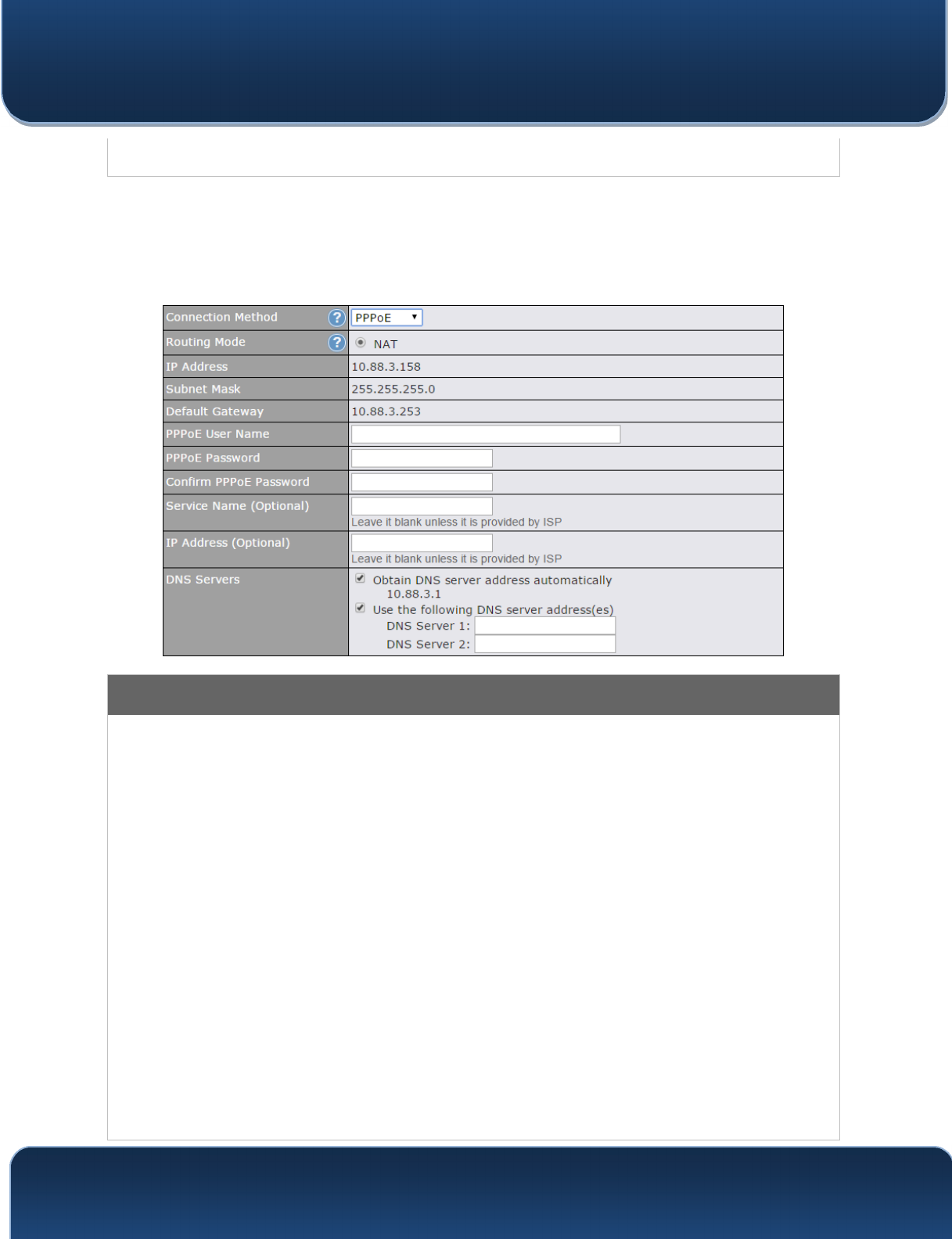
Pepwave MAX and Surf User Manual
http://www.pepwave.com 62 Copyright @ 2016 Pepwave
selected, you may enter custom DNS server addresses for this WAN connection into the
DNS Server 1 and DNS Server 2 fields.
10.1.3 PPPoE Connection
This connection method is suitable if your ISP provides a login ID/password to connect
via PPPoE.
PPPoE Settings
Routing Mode
NAT allows substituting the real address in a packet with a mapped address that is
routable on the destination network. By clicking the help icon in this field, you can
display the IP Forwarding option, if your network requires it.
IP Address /
Subnet Mask /
Default Gateway
This information is obtained from the ISP automatically.
PPPoE User
Name / Password
Enter the required information in these fields in order to connect via PPPoE to the ISP.
The parameter values are determined by and can be obtained from the ISP.
Confirm PPPoE
Password
Verify your password by entering it again in this field.
Service Name
(Optional)
Service name is provided by the ISP.
Note: Leave this field blank unless it is provided by your ISP.
IP Address
(Optional)
If your ISP provides a PPPoE IP address, enter it here.
Note: Leave this field blank unless it is provided by your ISP.
DNS Servers
Each ISP may provide a set of DNS servers for DNS lookups. This setting specifies
the DNS (Domain Name System) servers to be used when a DNS lookup is routed
through this connection. Selecting Obtain DNS server address automatically results
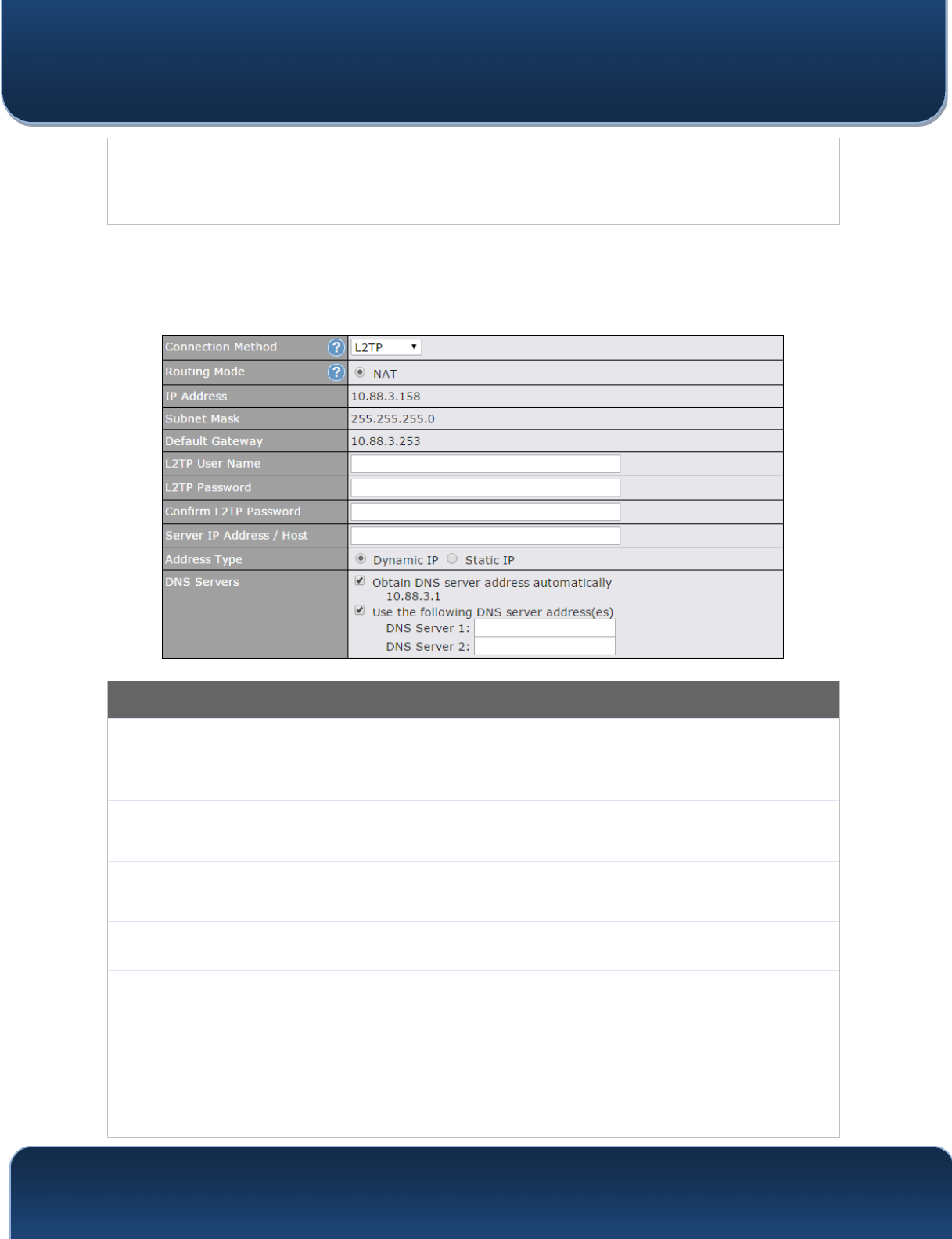
Pepwave MAX and Surf User Manual
http://www.pepwave.com 63 Copyright @ 2016 Pepwave
in the DNS servers being assigned by the WAN DHCP server to be used for outbound
DNS lookups over the connection. (The DNS servers are obtained along with the WAN
IP address assigned from the DHCP server.) When Use the following DNS server
address(es) is selected, you may enter custom DNS server addresses for this WAN
connection into the DNS Server 1 and DNS Server 2 fields.
10.1.4 L2TP Connection
L2TP has all the compatibility and convenience of PPTP with greater security. Combine
this with IPsec for a good balance between ease of use and security.
L2TP Settings
L2TP User
Name /
Password
Enter the required information in these fields in order to connect via L2TP to your ISP.
The parameter values are determined by and can be obtained from your ISP.
Confirm L2TP
Password
Verify your password by entering it again in this field.
Server IP
Address / Host
L2TP server address is a parameter which is provided by your ISP.
Note: Leave this field blank unless it is provided by your ISP.
Address Type
Your ISP will also indicate whether the server IP address is Dynamic or Static. Please click
the appropriate value.
DNS Servers
Each ISP may provide a set of DNS servers for DNS lookups. This setting specifies the
DNS (Domain Name System) servers to be used when a DNS lookup is routed through this
connection.
Selecting Obtain DNS server address automatically results in the DNS servers assigned
by the PPPoE server to be used for outbound DNS lookups over the WAN connection.
(The DNS servers are obtained along with the WAN IP address assigned from the PPPoE
server.)
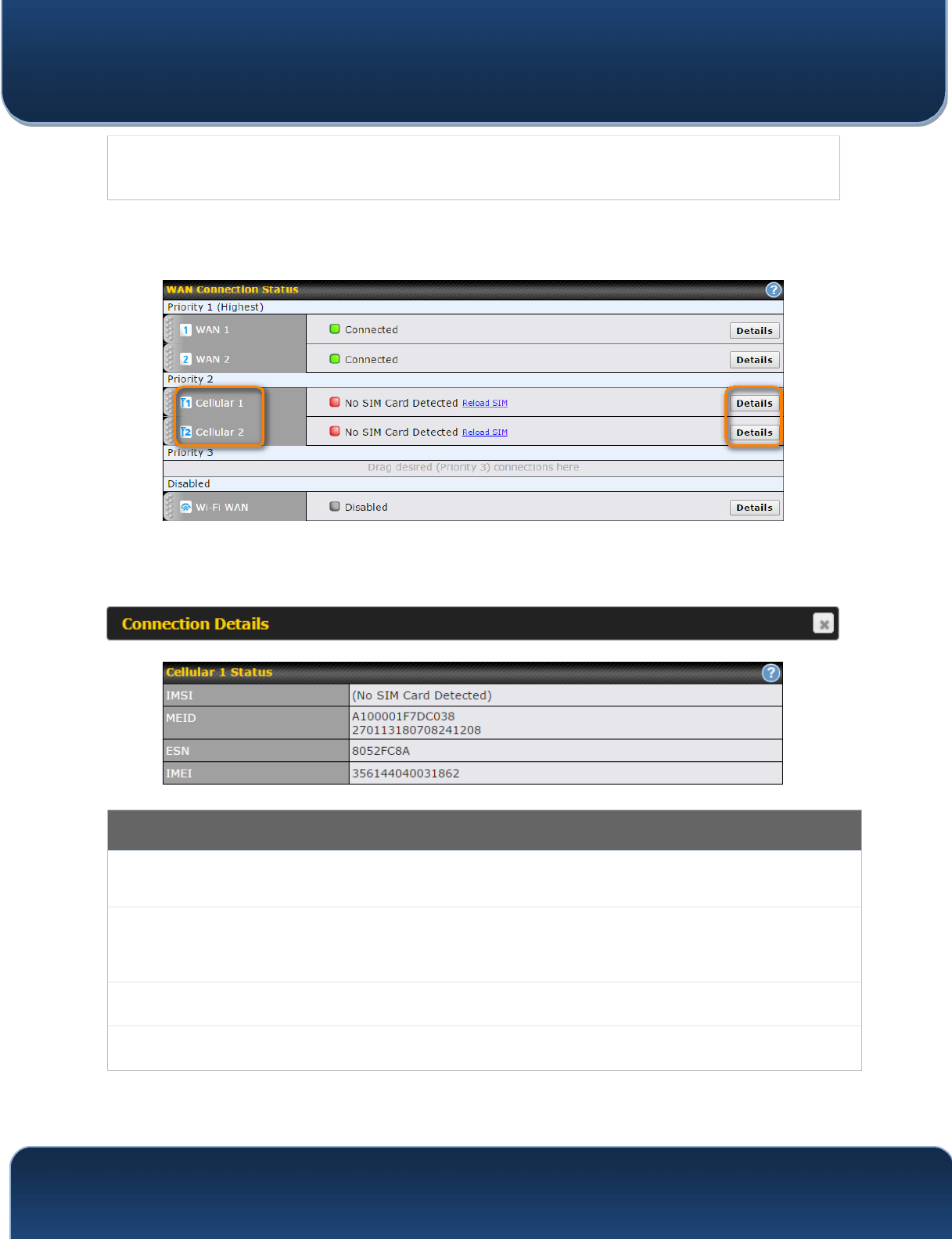
Pepwave MAX and Surf User Manual
http://www.pepwave.com 64 Copyright @ 2016 Pepwave
When Use the following DNS server address(es) is selected, you can enter custom DNS
server addresses for this WAN connection into the DNS server 1 and DNS server 2 fields.
10.2 Cellular WAN
To access cellular WAN settings, click Network>WAN>Details.
(Available on the Pepwave MAX BR1, HD2, and HD2 IP67 only)
Cellular Status
IMSI
This is the International Mobile Subscriber Identity which uniquely identifies the SIM card. This
is applicable to 3G modems only.
MEID
Some Pepwave routers support both HSPA and EV-DO. For Sprint or Verizon Wireless EV-DO
users, a unique MEID identifier code (in hexadecimal format) is used by the carrier to associate
the EV-DO device with the user. This information is presented in hex and decimal format.
ESN
This serves the same purpose as MEID HEX but uses an older format.
IMEI
This is the unique ID for identifying the modem in GSM/HSPA mode.
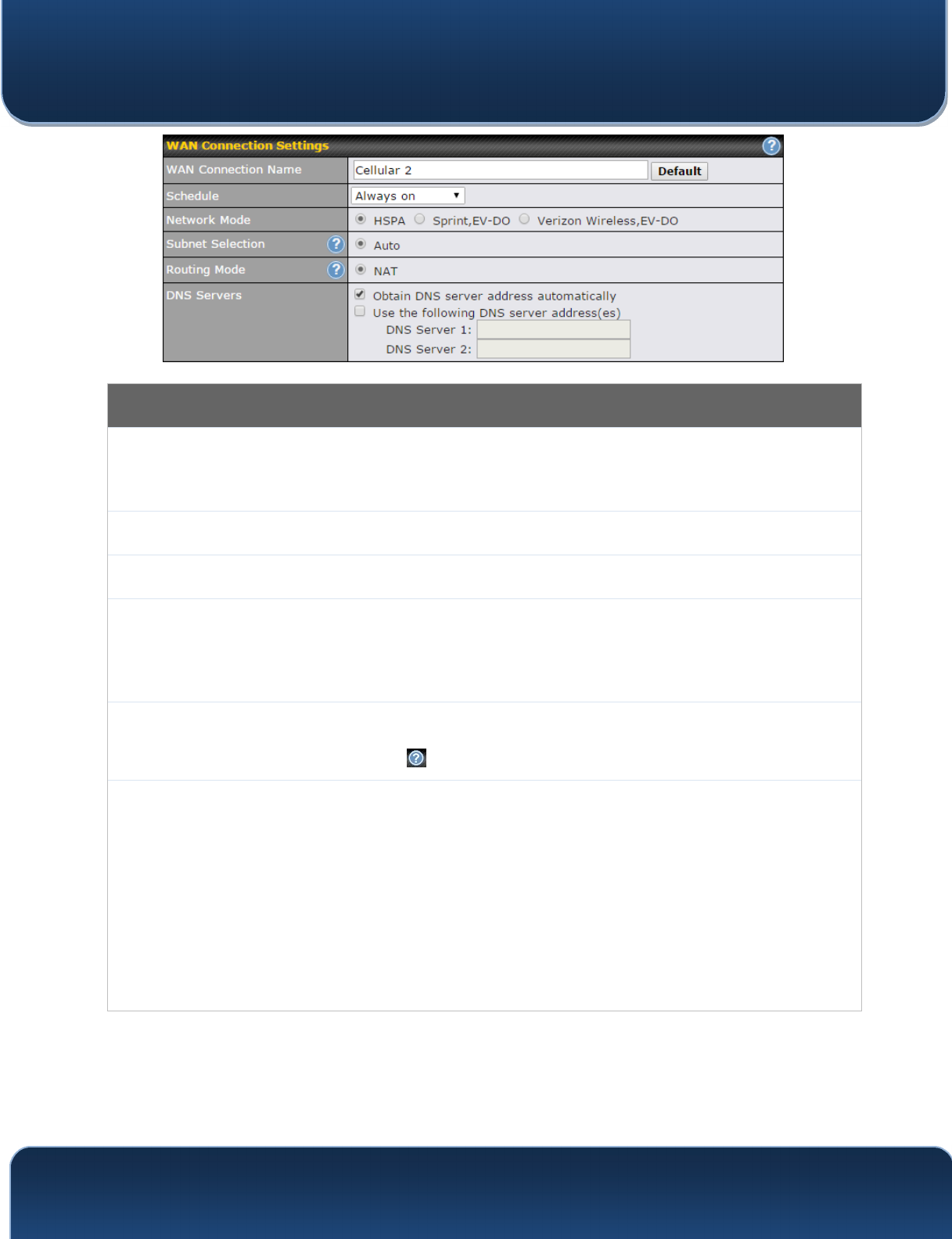
Pepwave MAX and Surf User Manual
http://www.pepwave.com 65 Copyright @ 2016 Pepwave
WAN Connection Settings
WAN
Connection
Name
Enter a name to represent this WAN connection.
Schedule
Click the drop-down menu to apply a time schedule to this interface if needed.
Network Mode
Users have to specify the network they are on accordingly.
Subnet
Selection
Auto: The subnet mask will be set automatically.
Force /31 Subnet: The subnet mask will be set as 255.255.255.254(/31), and the gateway IP
address will be recalculated.
Routing Mode
This option allows you to select the routing method to be used in routing IP frames via the
WAN connection. The mode can be either NAT (network address translation) or IP
Forwarding. Click the button to enable IP forwarding.
DNS Servers
Each ISP may provide a set of DNS servers for DNS lookups. This setting specifies the
DNS (Domain Name System) servers to be used when a DNS lookup is routed through this
connection.
Selecting Obtain DNS server address automatically results in the DNS servers assigned
by the PPPoE server to be used for outbound DNS lookups over the WAN connection.
(The DNS servers are obtained along with the WAN IP address assigned from the PPPoE
server.)
When Use the following DNS server address(es) is selected, you can enter custom DNS
server addresses for this WAN connection into the DNS server 1 and DNS server 2 fields.
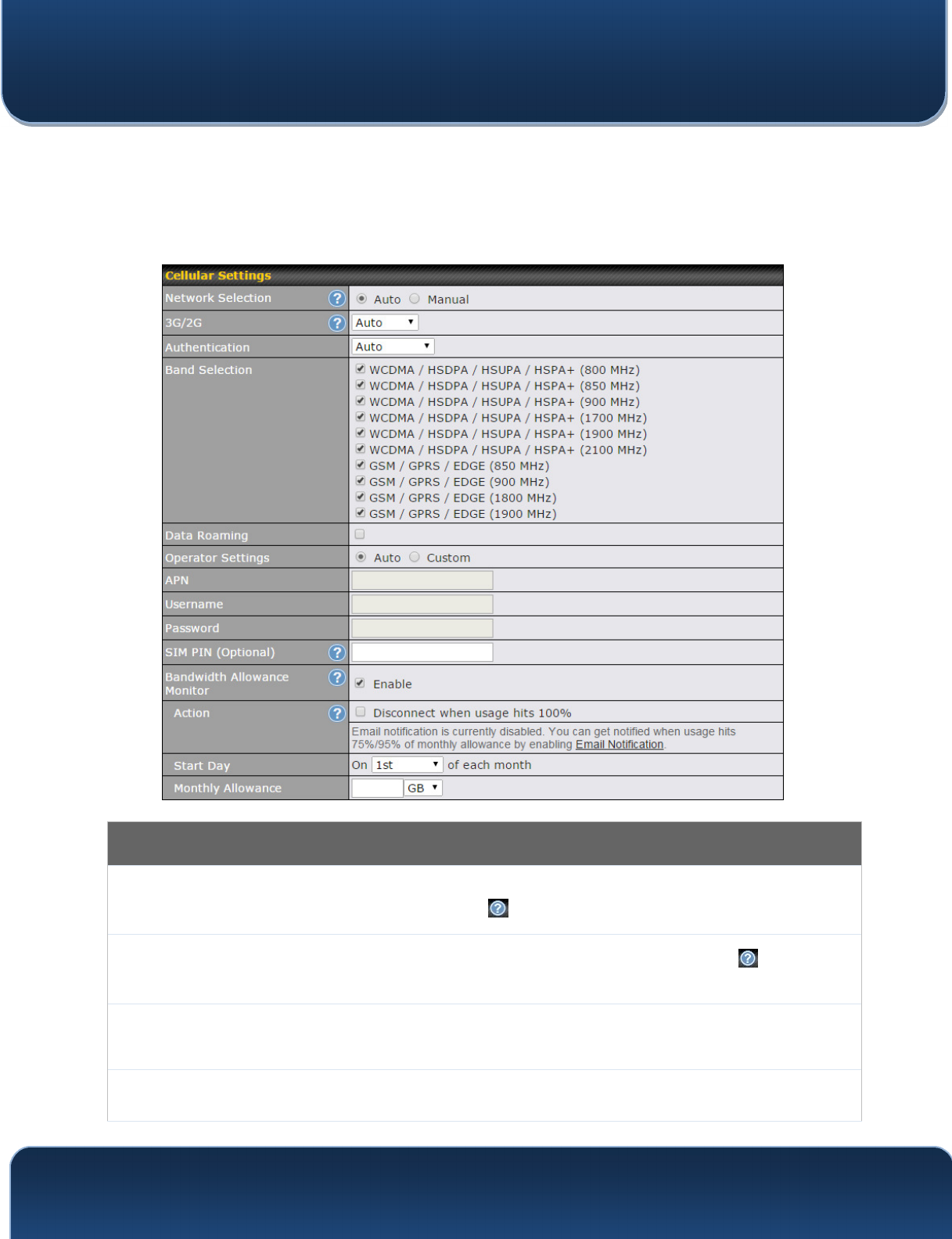
Pepwave MAX and Surf User Manual
http://www.pepwave.com 66 Copyright @ 2016 Pepwave
Cellular Settings
Network
Selection
By default, the MAX router will automatically choose a network to connect to. If you wish to
use only certain networks, click the button beside the menu item.
3G/2G
This drop-down menu allows restricting cellular to particular band. Click the button to
enable the selection of specific bands.
Authentication
Choose from PAP Only or CHAP Only to use those authentication methods exclusively.
Select Auto to automatically choose an authentication method.
Data Roaming
This checkbox enables data roaming on this particular SIM card. Please check your service
provider’s data roaming policy before proceeding.
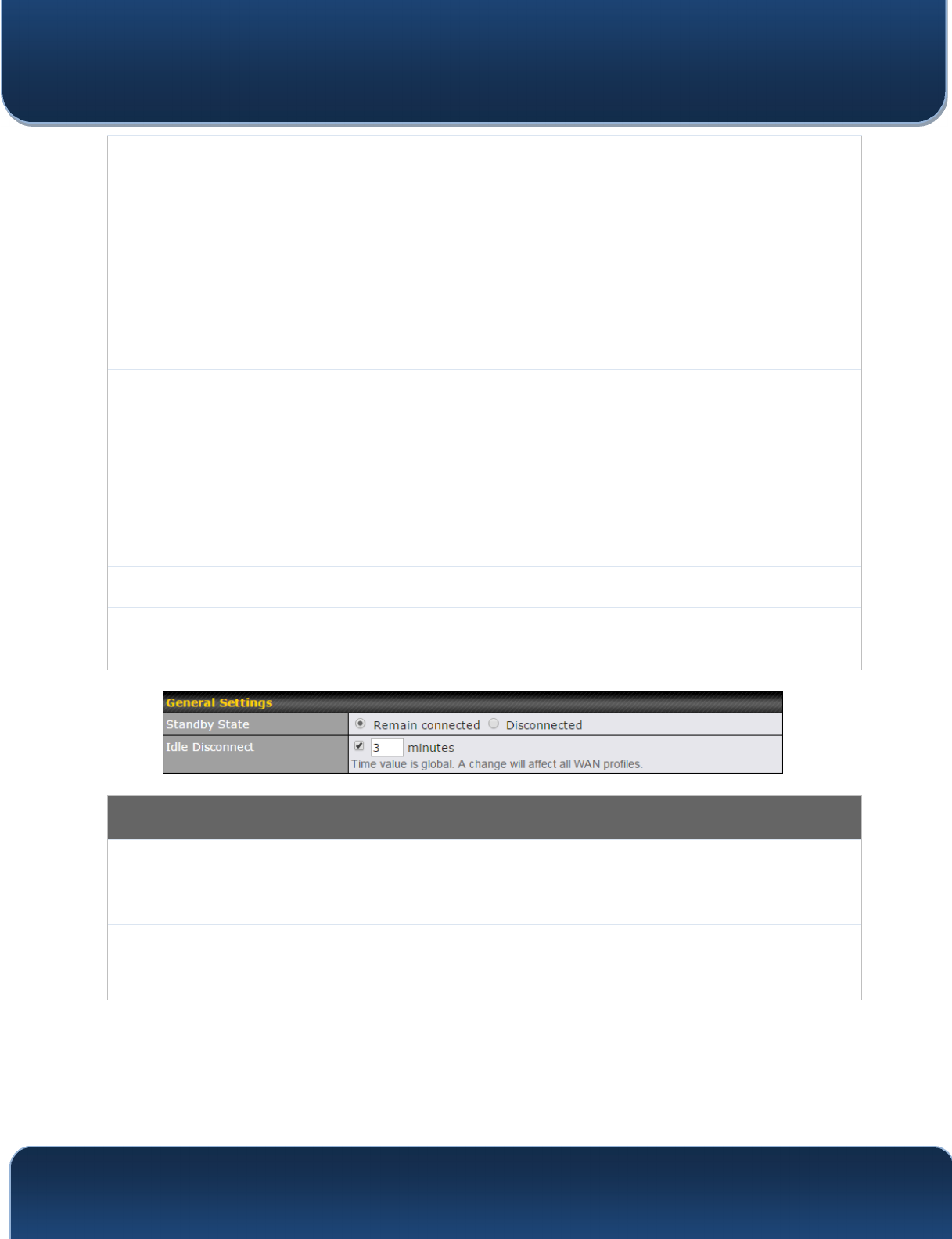
Pepwave MAX and Surf User Manual
http://www.pepwave.com 67 Copyright @ 2016 Pepwave
Operator
Settings
This setting applies to 3G/EDGE/GPRS modems only. It does not apply to EVDO/EVDO Rev.
A modems. This allows you to configure the APN settings of your connection. If Auto is
selected, the mobile operator should be detected automatically. The connected device will be
configured and connection will be made automatically. If there is any difficulty in making
connection, you may select Custom to enter your carrier’s APN, Login, Password, and Dial
Number settings manually. The correct values can be obtained from your carrier. The default
and recommended setting is Auto.
APN / Login /
Password /
SIM PIN
When Auto is selected, the information in these fields will be filled automatically. Select
Custom to customize these parameters. The parameter values are determined by and can be
obtained from the ISP.
Bandwidth
Allowance
Monitor
Check the box Enable to enable bandwidth usage monitoring on this WAN connection for each
billing cycle. When this option is not enabled, bandwidth usage of each month is still being
tracked but no action will be taken.
Action
If
email notification is enabled, you will be notified by email when usage hits 75% and 95% of
the monthly allowance. If Disconnect when usage hits 100% of monthly allowance is
checked, this WAN connection will be disconnected automatically when the usage hits the
monthly allowance. It will not resume connection unless this option has been turned off or the
usage has been reset when a new billing cycle starts.
Start Day
This option allows you to define which day of the month each billing cycle begins.
Monthly
Allowance
This field is for defining the maximum bandwidth usage allowed for the WAN connection each
month.
General Settings
Standby State
This option allows you to choose whether to remain connected or disconnected when this WAN
connection is no longer in the highest priority and has entered the standby state. When Remain
connected is chosen, bringing up this WAN connection to active makes it immediately available
for use.
Idle
Disconnect
When Internet traffic is not detected within the user-specified timeframe, the modem will
automatically disconnect. Once the traffic is resumed by the LAN host, the connection will be re-
activated.
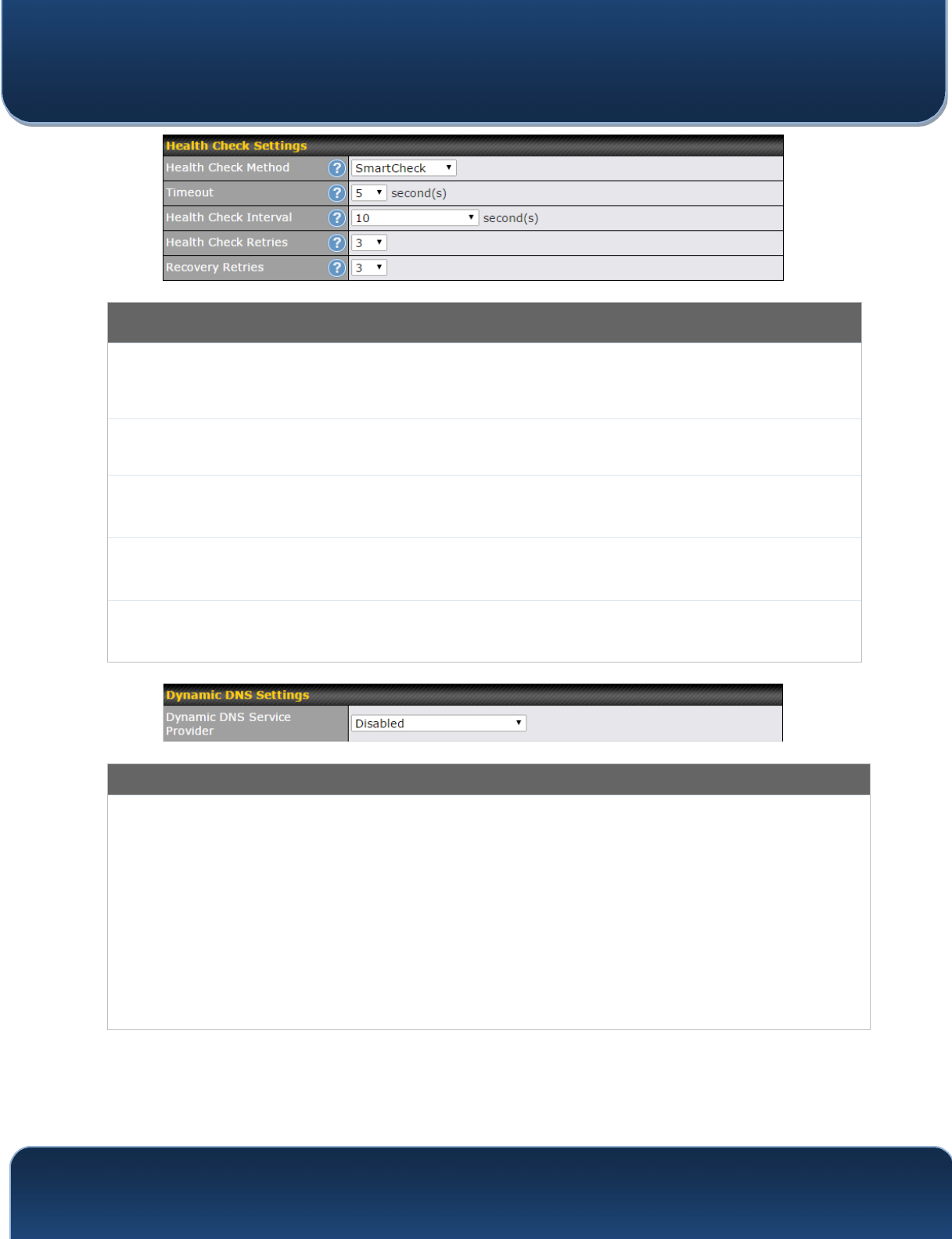
Pepwave MAX and Surf User Manual
http://www.pepwave.com 68 Copyright @ 2016 Pepwave
Health Check Settings
Heath Check
Method
This setting allows you to specify the health check method for the cellular connection. Available
options are Disabled, Ping, DNS Lookup, HTTP, and SmartCheck. The default method is
DNS Lookup. See Section 10.4 for configuration details.
Timeout
If a health check test cannot be completed within the specified amount of time, the test will be
treated as failed.
Health Check
Interval
This is the time interval between each health check test.
Health Check
Retries
This is the number of consecutive check failures before treating a connection as down.
Recovery
Retries
This is the number of responses required after a health check failure before treating a
connection as up again.
Dynamic DNS Settings
Dynamic DNS
Service
Provider
This setting specifies the dynamic DNS service provider to be used for the WAN based on
supported dynamic DNS service providers:
• changeip.com
• dyndns.org
• no-ip.org
• tzo.com
• DNS-O-Matic
Select Disabled to disable this feature. See Section 9.5
for configuration details.
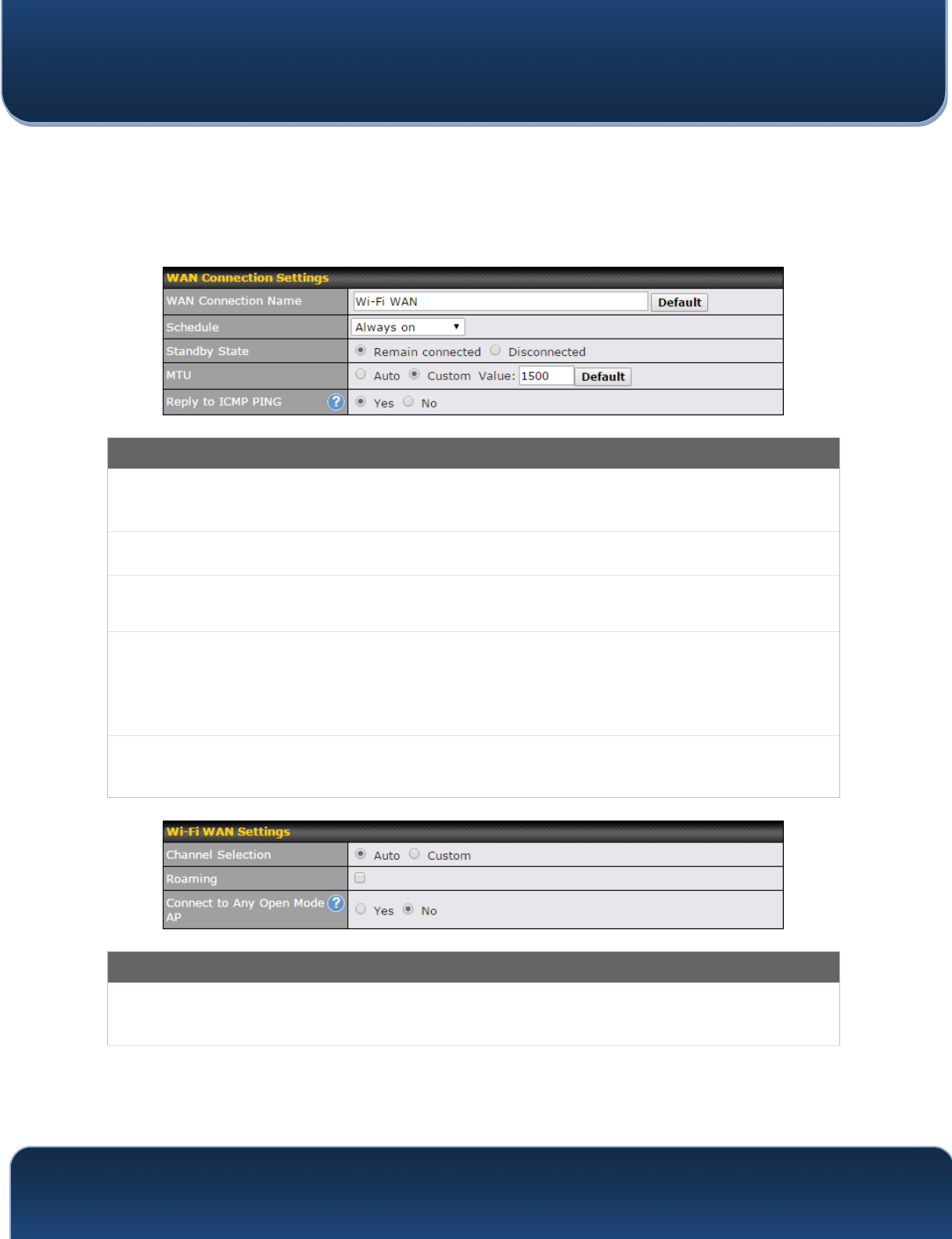
Pepwave MAX and Surf User Manual
http://www.pepwave.com 69 Copyright @ 2016 Pepwave
10.3 Wi-Fi WAN
To access Wi-Fi WAN settings, click Network>WAN>Details.
Wi-Fi Connection Settings
WAN Connection
Name
Enter a name to represent this WAN connection.
Schedule
Click the drop-down menu to apply a time schedule to this interface.
Standby State
This setting specifies the state of the WAN connection while in standby. The available
options are Remain Connected (hot standby) and Disconnect (cold standby).
MTU
This setting specifies the maximum transmission unit. By default, MTU is set to Custom
1440. You may adjust the MTU value by editing the text field. Click Default to restore the
default MTU value. Select Auto and the appropriate MTU value will be automatically
detected. The auto-detection will run each time the WAN connection establishes
Reply to ICMP
PING
If this setting is disabled, the WAN connection will not respond to ICMP ping requests. By
default, this setting is enabled.
Wi-Fi WAN Settings
Channel
Selection
Determine whether the channel will be automatically selected. If you select custom, the
following table will appear:
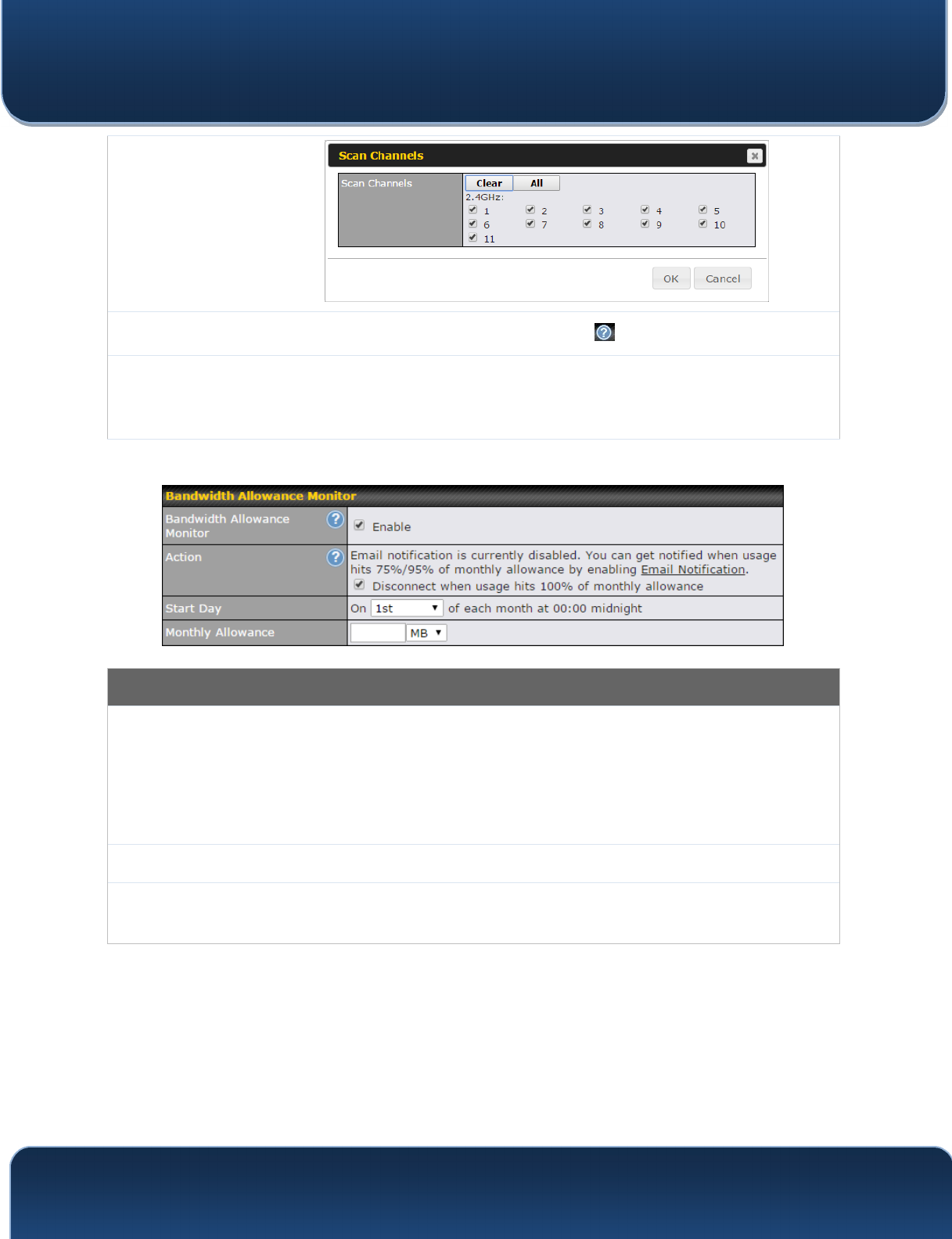
Pepwave MAX and Surf User Manual
http://www.pepwave.com 70 Copyright @ 2016 Pepwave
Roaming
Checking this box will enable Wi-Fi roaming. Click the icon for additional options.
Connect to
Any Open
Mode AP
This option is to specify whether the Wi-Fi WAN will connect to any open mode access
points it finds.
Bandwidth Allowance Monitor
Action
If
Error! Reference source not found.
is enabled, you will be notified by email
when usage hits 75% and 95% of the monthly allowance.
If Disconnect when usage hits 100% of monthly allowance is checked, this WAN
connection will be disconnected automatically when the usage hits the monthly allowance.
It will not resume connection unless this option has been turned off or the usage has been
reset when a new billing cycle starts.
Start Day
This option allows you to define which day of the month each billing cycle begins.
Monthly
Allowance
This field is for defining the maximum bandwidth usage allowed for the WAN connection
each month.
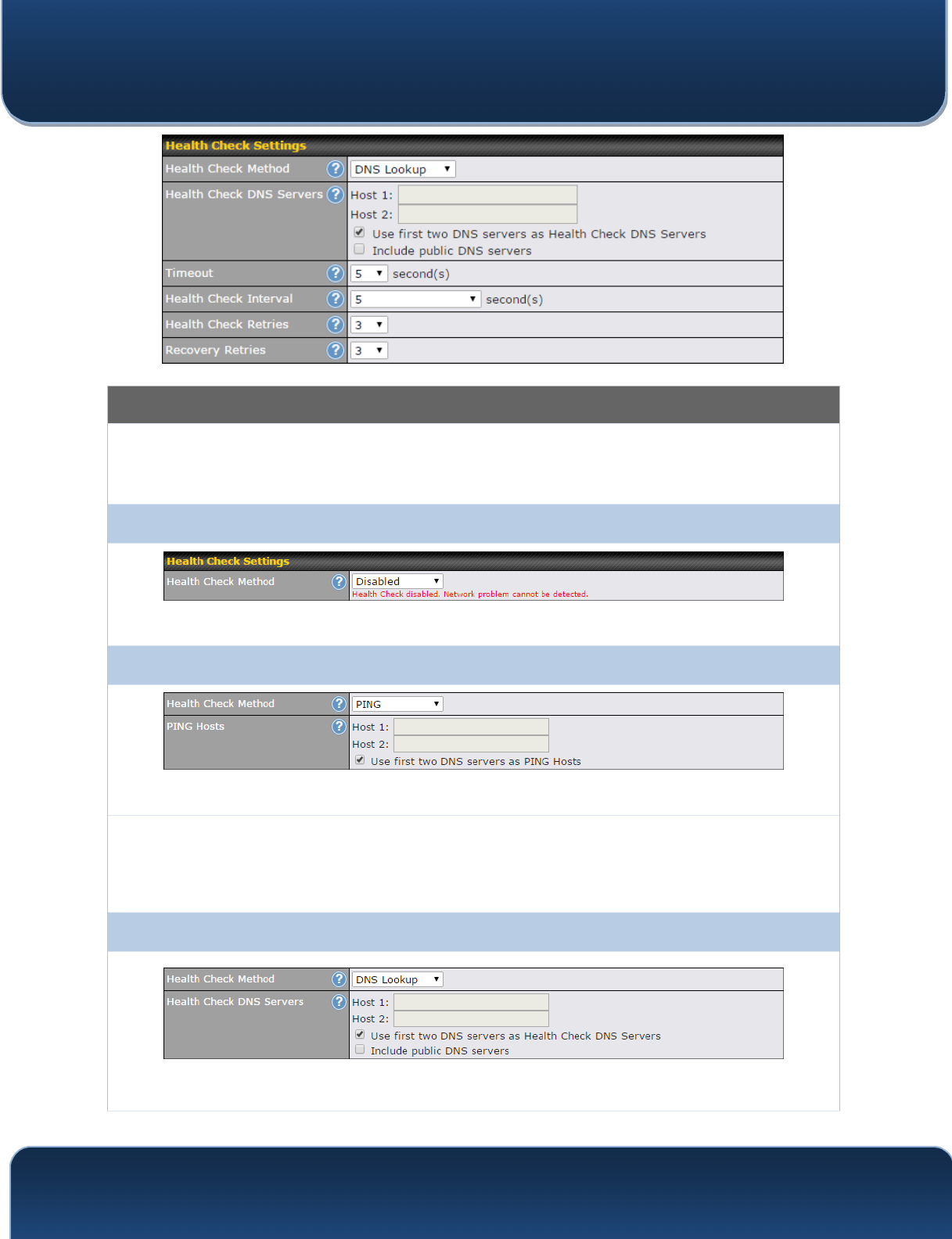
Pepwave MAX and Surf User Manual
http://www.pepwave.com 71 Copyright @ 2016 Pepwave
Health Check Settings
Method
This setting specifies the health check method for the WAN connection. This value can be
configured as Disabled, PING, DNS Lookup, or HTTP. The default method is DNS
Lookup. For mobile Internet connections, the value of Method can be configured as
Disabled or SmartCheck.
Health Check Disabled
When Disabled is chosen in the Method field, the WAN connection will always be considered as up. The
connection will NOT be treated as down in the event of IP routing errors.
Health Check Method: PING
ICMP ping packets will be issued to test the connectivity with a configurable target IP address or hostname. A WAN
connection is considered as up if ping responses are received from either one or both of the ping hosts.
PING Hosts
This setting specifies IP addresses or hostnames with which connectivity is to be tested via
ICMP ping. If Use first two DNS servers as Ping Hosts is checked, the target ping host
will be the first DNS server for the corresponding WAN connection. Reliable ping hosts with
a high uptime should be considered. By default, the first two DNS servers of the WAN
connection are used as the ping hosts.
Health Check Method: DNS Lookup
DNS lookups will be issued to test connectivity with target DNS servers. The connection will be treated as up if DNS
responses are received from one or both of the servers, regardless of whether the result was positive or negative.
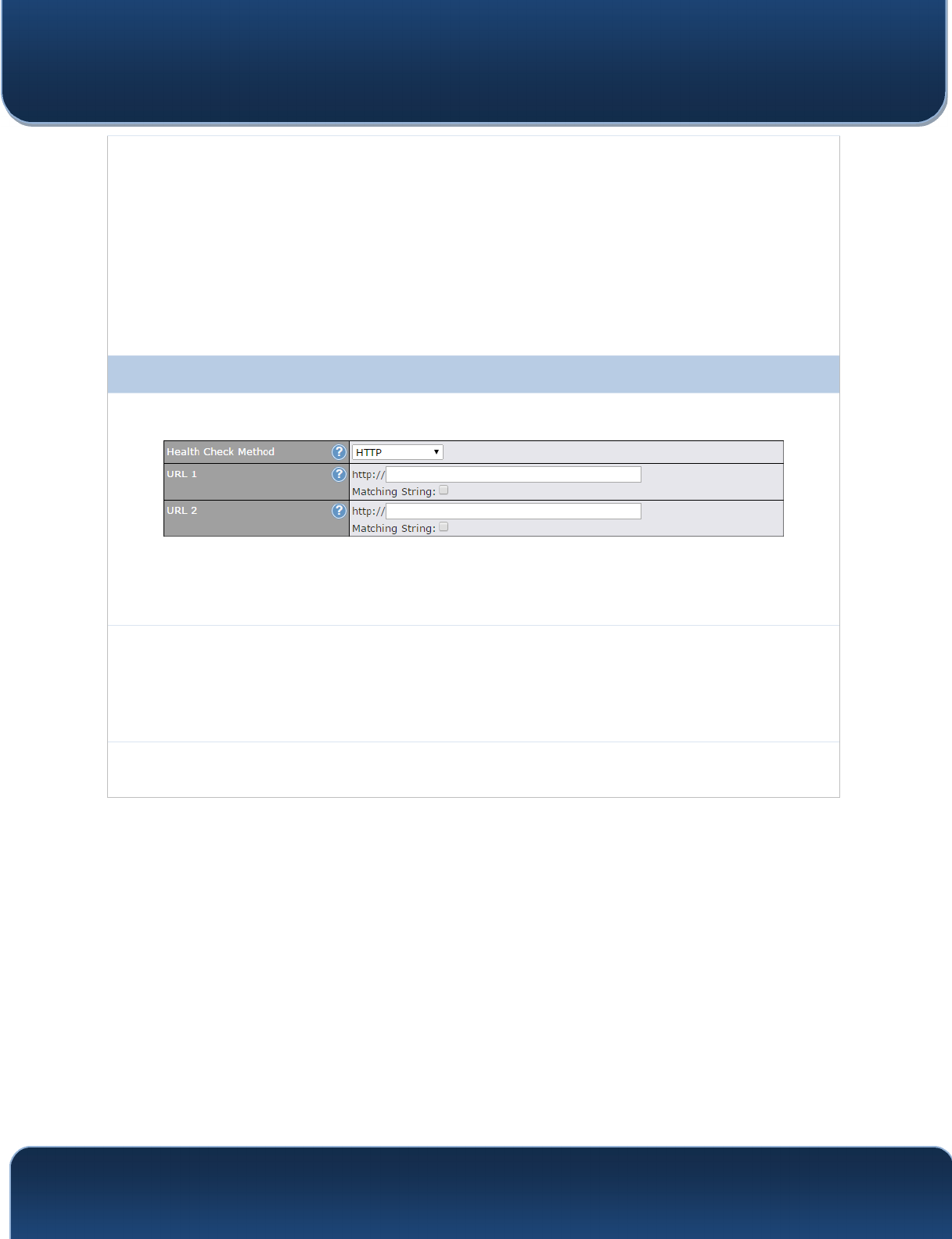
Pepwave MAX and Surf User Manual
http://www.pepwave.com 72 Copyright @ 2016 Pepwave
Health Check
DNS Servers
This field allows you to specify two DNS hosts’ IP addresses with which connectivity is to be
tested via DNS Lookup.
If Use first two DNS servers as Health Check DNS Servers is checked, the first two DNS
servers will be the DNS lookup targets for checking a connection's health. If the box is not
checked, Host 1 must be filled, while a value for Host 2 is optional.
If Include public DNS servers is selected and no response is received from all specified
DNS servers, DNS lookups will also be issued to some public DNS servers. A WAN
connection will be treated as down only if there is also no response received from the public
DNS servers.
Connections will be considered as up if DNS responses are received from any one of the
health check DNS servers, regardless of a positive or negative result. By default, the first
two DNS servers of the WAN connection are used as the health check DNS servers.
Health Check Method: HTTP
HTTP connections will be issued to test connectivity with configurable URLs and strings to match.
URL1
WAN Settings>WAN Edit>Health Check Settings>URL1
The URL will be retrieved when performing an HTTP health check. When String to Match
is left blank, a health check will pass if the HTTP return code is between 200 and 299
(Note: HTTP redirection codes 301 or 302 are treated as failures). When String to Match is
filled, a health check will pass if the HTTP return code is between 200 and 299 and if the
HTTP response content contains the string.
URL 2
WAN Settings>WAN Edit>Health Check Settings>URL2
If URL2 is also provided, a health check will pass if either one of the tests passed.
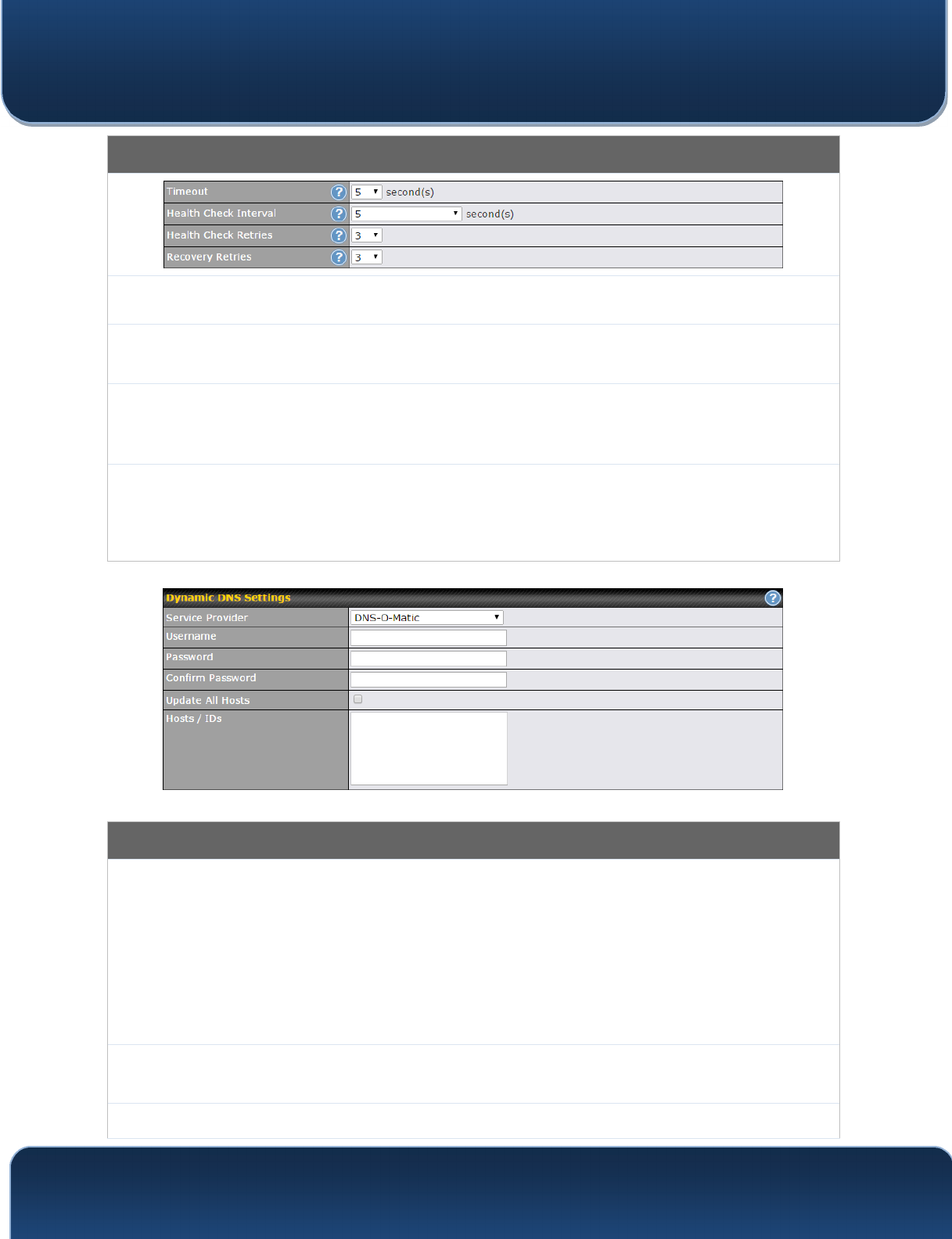
Pepwave MAX and Surf User Manual
http://www.pepwave.com 73 Copyright @ 2016 Pepwave
Other Health Check Settings
Timeout
This setting specifies the timeout in seconds for ping/DNS lookup requests. The default
timeout is 5 seconds.
Health Check
Interval
This setting specifies the time interval in seconds between ping or DNS lookup requests.
The default health check interval is 5 seconds.
Health Check
Retries
This setting specifies the number of consecutive ping/DNS lookup timeouts after which the
Peplink Balance will treat the corresponding WAN connection as down. Default health
retries is set to 3. Using the default Health Retries setting of 3, the corresponding WAN
connection will be treated as down after three consecutive timeouts.
Recovery
Retries
This setting specifies the number of consecutive successful ping/DNS lookup responses
that must be received before the Peplink Balance treats a previously down WAN connection
as up again. By default, Recover Retries is set to 3. Using the default setting, a WAN
connection that is treated as down will be considered as up again upon receiving three
consecutive successful ping/DNS lookup responses.
Dynamic DNS Settings
Service Provider
This setting specifies the dynamic DNS service provider to be used for the WAN.
Supported providers are:
• changeip.com
• dyndns.org
• no-ip.org
• tzo.com
• DNS-O-Matic
Select Disabled to disable this feature.
User ID / User /
Email
This setting specifies the registered user name for the dynamic DNS service.
Password / Pass /
This setting specifies the password for the dynamic DNS service.
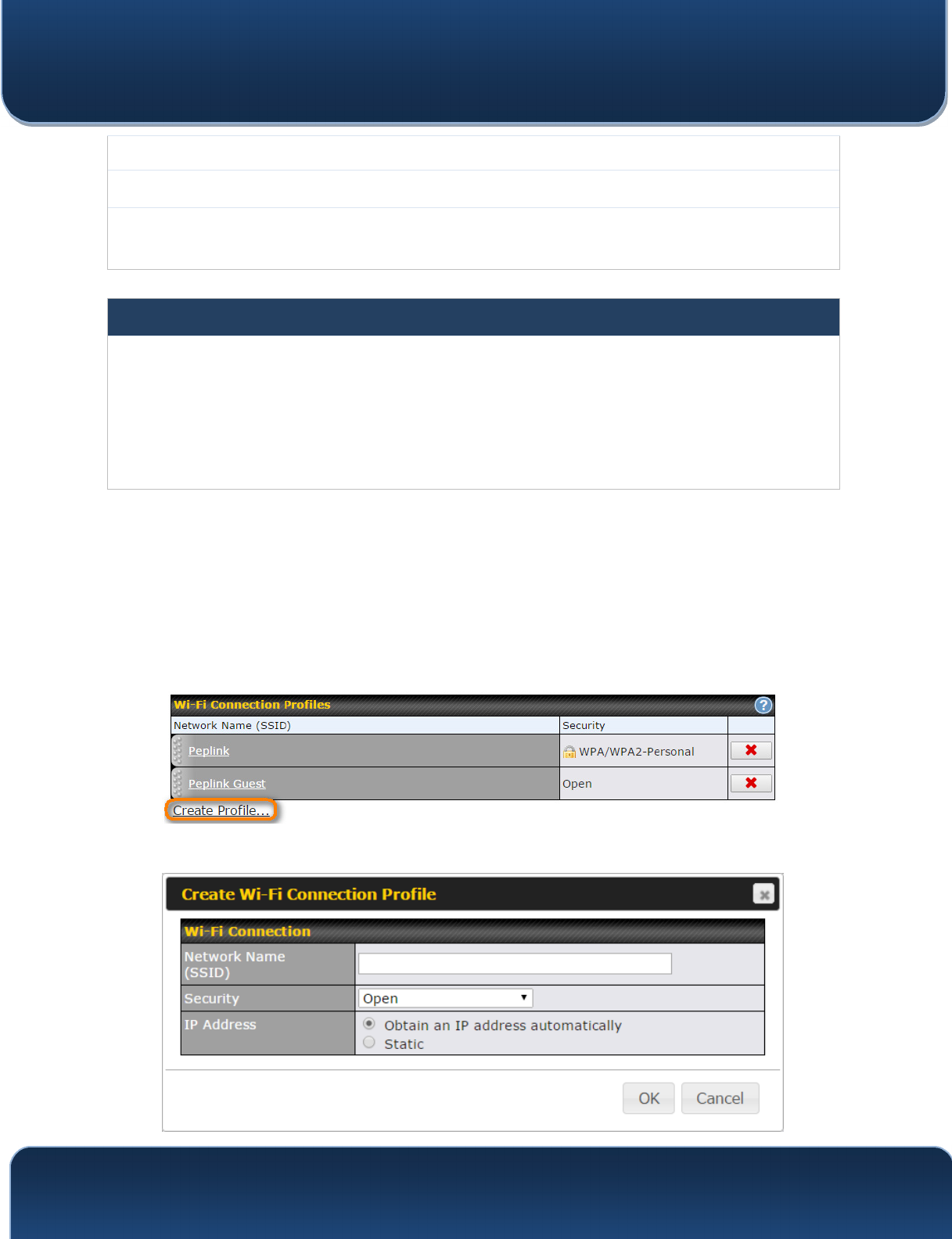
Pepwave MAX and Surf User Manual
http://www.pepwave.com 74 Copyright @ 2016 Pepwave
TZO Key
Update All Hosts
Check this box to automatically update all hosts.
Hosts / Domain
This setting specifies a list of hostnames or domains to be associated with the public
Internet IP address of the WAN connection.
Important Note
In order to use dynamic DNS services, appropriate hostname registration(s), as well as a valid account with a
supported dynamic DNS service provider, are required.
A dynamic DNS update is performed whenever a WAN’s IP address is changed, such as when an IP is changed
after a DHCP IP refresh or reconnection.
Due to dynamic DNS service providers’ policies, a dynamic DNS host expires automatically when the host record
has not been not updated for a long time. Therefore, the Peplink Balance performs an update every 23 days, even if
a WAN’s IP address did not change.
10.3.1 Creating Wi-Fi Connection Profiles
You can manually create a profile to connect to a Wi-Fi connection. This is useful for
creating a profile for connecting to hidden-SSID access points. Click
Network>WAN>Details>Create Profile… to get started.
This will open a window similar to the one shown below:
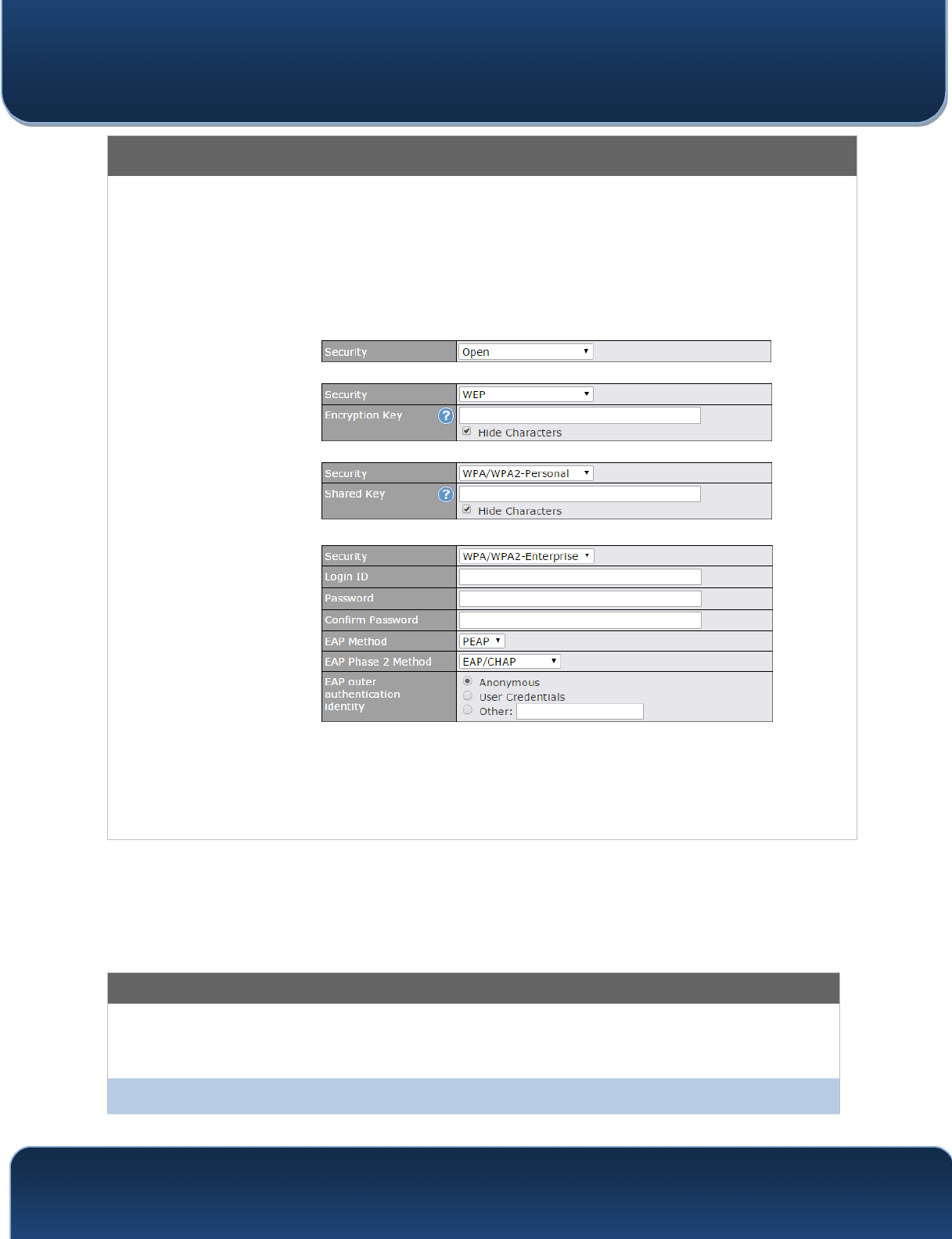
Pepwave MAX and Surf User Manual
http://www.pepwave.com 75 Copyright @ 2016 Pepwave
Wi-Fi Connection Profile Settings
Type
Select whether the network will connect automatically or manually.
Network Name
(SSID)
Enter a name to represent this Wi-Fi connection.
Security
This option allows you to select which security policy is used for this wireless network.
Available options:
• Open
• WEP
• WPA/WPA2 – Personal
•
WPA/WPA2 – Enterprise
10.4 WAN Health Check
To ensure traffic is routed to healthy WAN connections only, the Pepwave router can
periodically check the health of each WAN connection. The health check settings for
each WAN connection can be independently configured via Network>WAN>Details.
Health Check Settings
Method
This setting specifies the health check method for the WAN connection. This value can be
configured as Disabled, PING, DNS Lookup, or HTTP. The default method is DNS
Lookup. For mobile Internet connections, the value of Method can be configured as
Disabled or SmartCheck.
Health Check Disabled
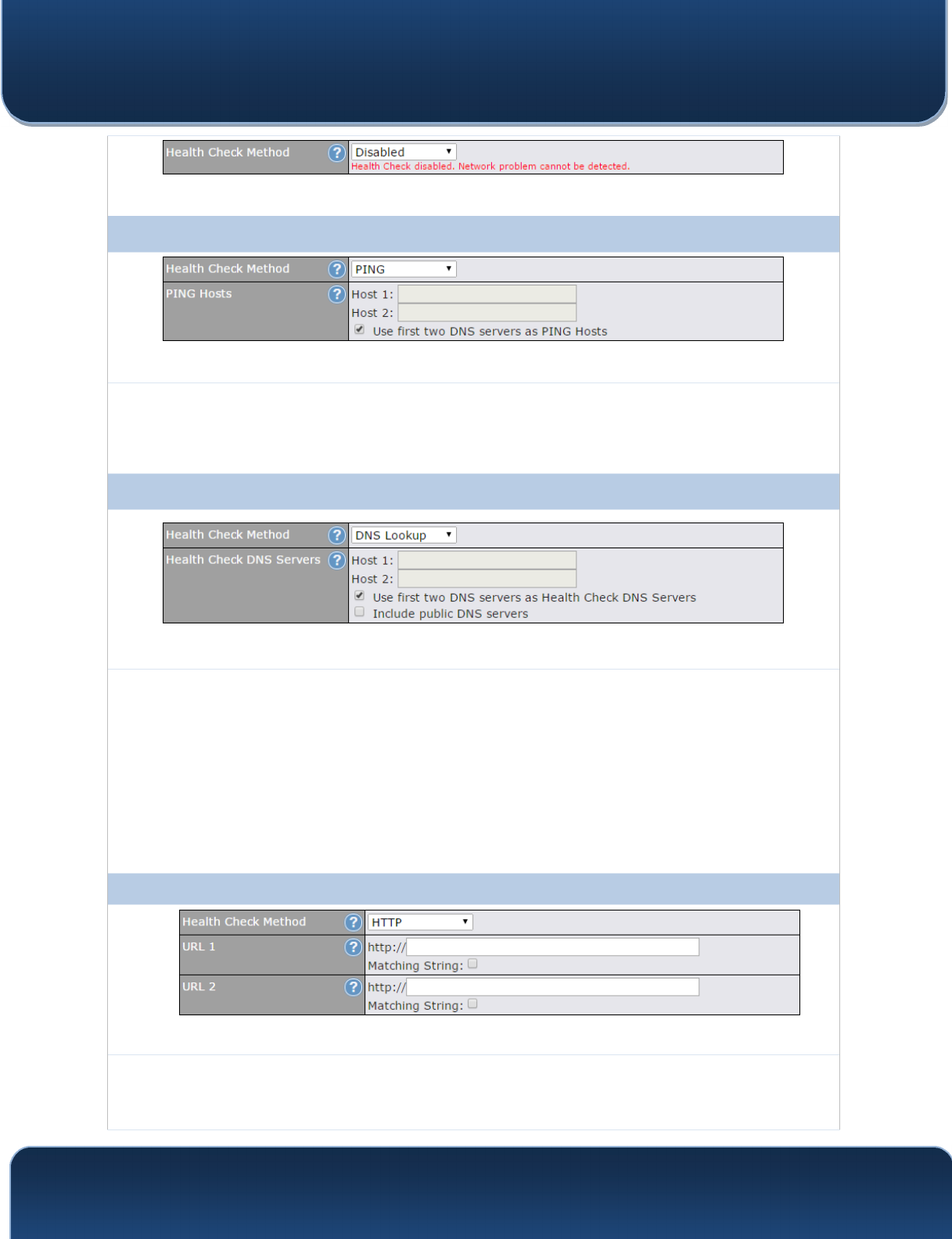
Pepwave MAX and Surf User Manual
http://www.pepwave.com 76 Copyright @ 2016 Pepwave
When Disabled is chosen in the Method field, the WAN connection will always be considered as up. The
connection will NOT be treated as down in the event of IP routing errors.
Health Check Method: PING
ICMP ping packets will be issued to test the connectivity with a configurable target IP address or hostname. A WAN
connection is considered as up if ping responses are received from either one or both of the ping hosts.
PING Hosts
This setting specifies IP addresses or hostnames with which connectivity is to be tested via
ICMP ping. If Use first two DNS servers as Ping Hosts is checked, the target ping host
will be the first DNS server for the corresponding WAN connection. Reliable ping hosts with
a high uptime should be considered. By default, the first two DNS servers of the WAN
connection are used as the ping hosts.
Health Check Method: DNS Lookup
DNS lookups will be issued to test connectivity with target DNS servers. The connection will be treated as up if DNS
responses are received from one or both of the servers, regardless of whether the result was positive or negative.
Health Check
DNS Servers
This field allows you to specify two DNS hosts’ IP addresses with which connectivity is to be
tested via DNS lookup.
If Use first two DNS servers as Health Check DNS Servers is checked, the first two DNS
servers will be the DNS lookup targets for checking a connection's health. If the box is not
checked, Host 1 must be filled, while a value for Host 2 is optional.
If Include public DNS servers is selected and no response is received from all specified
DNS servers, DNS lookups will also be issued to some public DNS servers. A WAN
connection will be treated as down only if there is also no response received from the public
DNS servers.
Connections will be considered as up if DNS responses are received from any one of the
health check DNS servers, regardless of a positive or negative result. By default, the first
two DNS servers of the WAN connection are used as the health check DNS servers.
Health Check Method: HTTP
HTTP connections will be issued to test connectivity with configurable URLs and strings to match.
URL1
WAN Settings>WAN Edit>Health Check Settings>URL1
The URL will be retrieved when performing an HTTP health check. When String to Match
is left blank, a health check will pass if the HTTP return code is between 200 and 299
(Note: HTTP redirection codes 301 or 302 are treated as failures). When String to Match is
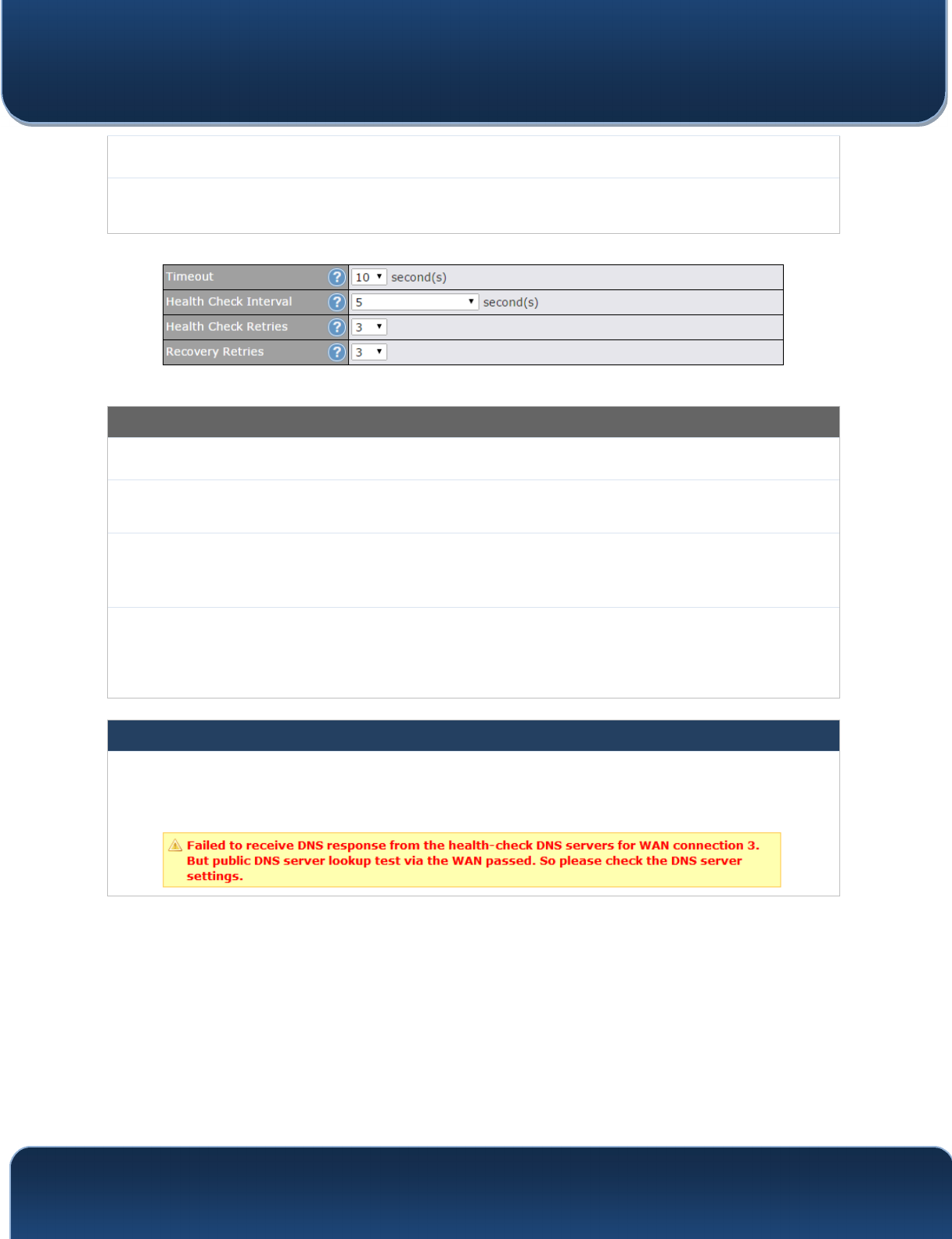
Pepwave MAX and Surf User Manual
http://www.pepwave.com 77 Copyright @ 2016 Pepwave
filled, a health check will pass if the HTTP return code is between 200 and 299 and if the
HTTP response content contains the string.
URL 2
WAN Settings>WAN Edit>Health Check Settings>URL2
If URL2 is also provided, a health check will pass if either one of the tests passed.
Other Health Check Settings
Timeout
This setting specifies the timeout in seconds for ping/DNS lookup requests. The default
timeout is 5 seconds.
Health Check
Interval
This setting specifies the time interval in seconds between ping or DNS lookup requests.
The default health check interval is 5 seconds.
Health Check
Retries
This setting specifies the number of consecutive ping/DNS lookup timeouts after which the
Pepwave router will treat the corresponding WAN connection as down. Default health
retries is set to 3. Using the default Health Retries setting of 3, the corresponding WAN
connection will be treated as down after three consecutive timeouts.
Recovery
Retries
This setting specifies the number of consecutive successful ping/DNS lookup responses
that must be received before the Pepwave router treats a previously down WAN connection
as up again. By default, Recover Retries is set to 3. Using the default setting, a WAN
connection that is treated as down will be considered as up again upon receiving three
consecutive successful ping/DNS lookup responses.
Automatic Public DNS Server Check on DNS Test Failure
When the health check method is set to DNS Lookup and health checks fail, the Pepwave router will automatically
perform DNS lookups on public DNS servers. If the tests are successful, the WAN may not be down, but rather the
target DNS server malfunctioned. You will see the following warning message on the main page:
10.5 Dynamic DNS Settings
Pepwave routers are capable of registering the domain name relationships to dynamic
DNS service providers. Through registration with dynamic DNS service provider(s), the
default public Internet IP address of each WAN connection can be associated with a
host name. With dynamic DNS service enabled for a WAN connection, you can connect
to your WAN's IP address from the external, even if its IP address is dynamic. You must
register for an account from the listed dynamic DNS service providers before enabling
this option.
If the WAN connection's IP address is a reserved private IP address (i.e., behind a NAT
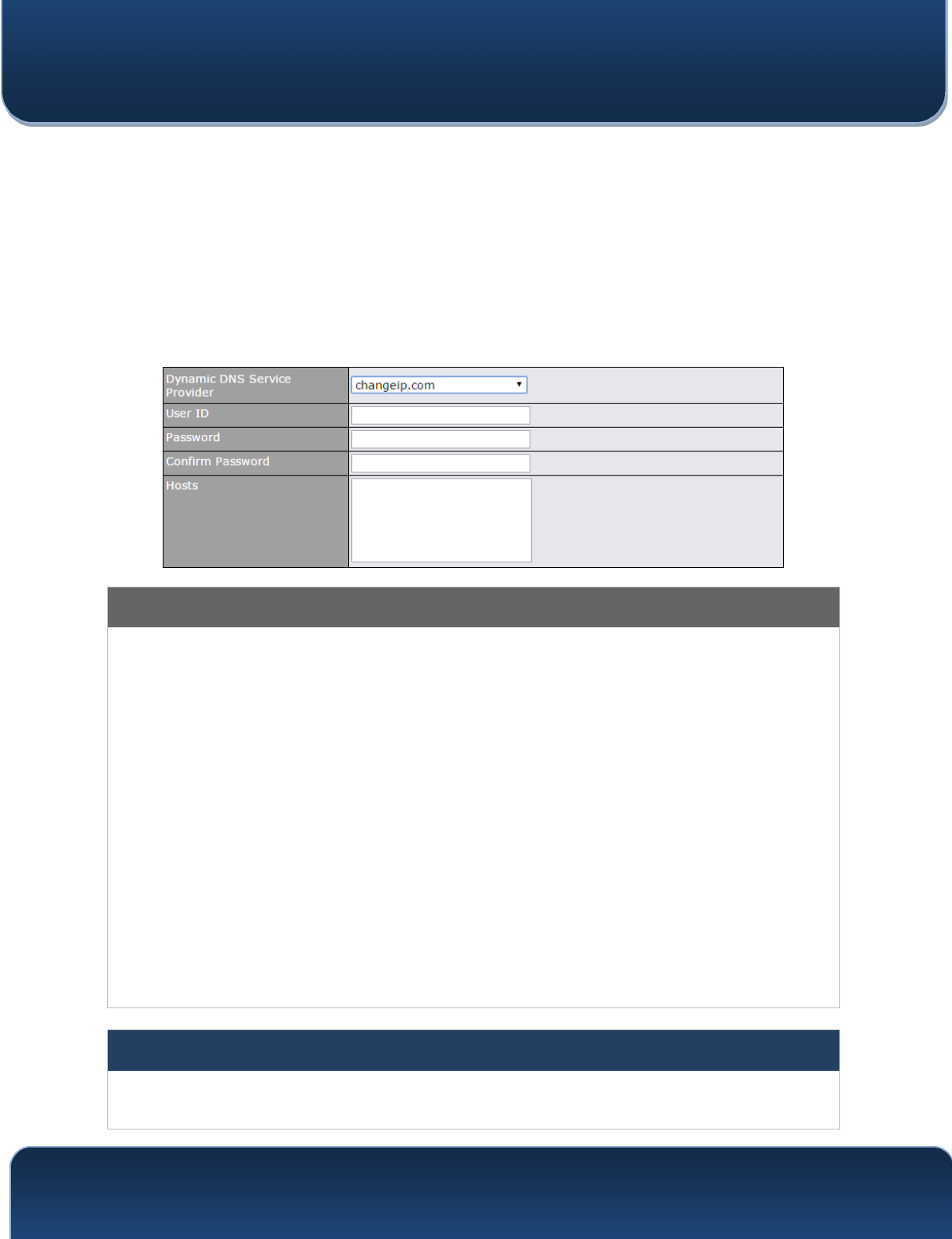
Pepwave MAX and Surf User Manual
http://www.pepwave.com 78 Copyright @ 2016 Pepwave
router), the public IP of each WAN will be automatically reported to the DNS service
provider.
Either upon a change in IP addresses or every 23 days without link reconnection, the
Pepwave router will connect to the dynamic DNS service provider to perform an IP
address update within the provider’s records.
The settings for dynamic DNS service provider(s) and the association of hostname(s)
are configured via Network>WAN>Details>Dynamic DNS Service Provider/Dynamic
DNS Settings.
Dynamic DNS Settings
Dynamic DNS
This setting specifies the dynamic DNS service provider to be used for the WAN based
on supported dynamic DNS service providers:
• changeip.com
• dyndns.org
• no-ip.org
• tzo.com
• DNS-O-Matic
• Others…
Support custom Dynamic DNS servers by entering its URL. Works with
any service compatible with DynDNS API.
Select Disabled to disable this feature.
Account Name /
Email Address
This setting specifies the registered user name for the dynamic DNS service.
Password / TZO
Key
This setting specifies the password for the dynamic DNS service.
Hosts / Domain
This field allows you to specify a list of host names or domains to be associated with
the public Internet IP address of the WAN connection. If you need to enter more than
one host, use a carriage return to separate them.
Important Note
In order to use dynamic DNS services, appropriate host name registration(s) and a valid account with a supported
dynamic DNS service provider are required. A dynamic DNS update is performed whenever a WAN’s IP address
changes (e.g., the IP is changed after a DHCP IP refresh, reconnection, etc.). Due to dynamic DNS service

Pepwave MAX and Surf User Manual
http://www.pepwave.com 79 Copyright @ 2016 Pepwave
providers’ policy, a dynamic DNS host will automatically expire if the host record has not been updated for a long
time. Therefore the Pepwave router performs an update every 23 days, even if a WAN’s IP address has not
changed.
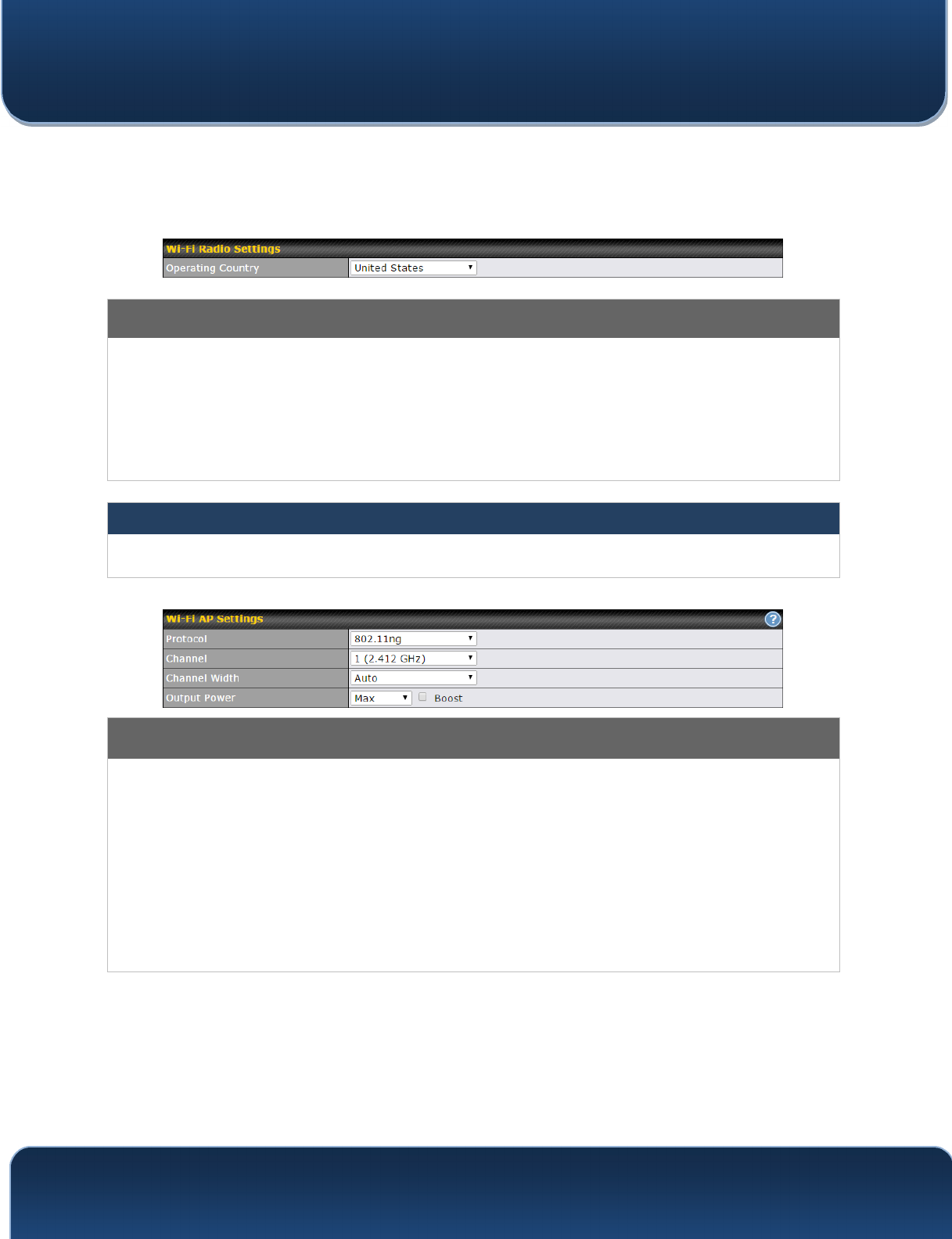
Pepwave MAX and Surf User Manual
http://www.pepwave.com 80 Copyright @ 2016 Pepwave
11 Advanced Wi-Fi Settings
Wi-Fi settings can be configured at Advanced>Wi-Fi Settings (or AP>Settings on
some models). Note that menus displayed can vary by model.
Wi-Fi Radio Settings
Operating
Country
This drop-down menu specifies the national/regional regulations which the Wi-Fi radio
should follow.
• If a North American region is selected, RF channels 1 to 11 will be available
and the maximum transmission power will be 26 dBm (400 mW).
• If European region is selected, RF channels 1 to 13 will be available. The
maximum transmission power will be 20 dBm (100 mW).
NOTE: Users are required to choose an option suitable to local laws and regulations.
Important Note
Per FCC regulation, the country selection is not available on all models marketed in
the US. All US models are fixed to US channels only.
Wi-Fi AP Settings
Protocol
This option allows you to specify whether 802.11b and/or 802.11g client association
requests will be accepted. Available options are 802.11ng and 802.11na. By default,
802.11ng is selected.
Channel
This option allows you to select which 802.11 RF channel will be utilized. Channel 1
(2.412 GHz) is selected by default.
Channel Width
Available options are 20 MHz, 40 MHz, and Auto (20/40 MHz) . Default is Auto (20/40
MHz), which allows both widths to be used simultaneously.
Output Power
This option is for specifying the transmission output power for the Wi-Fi AP. There are 4
relative power levels available – Max, High, Mid, and Low. The actual output power
will be bound by the regulatory limits of the selected country.
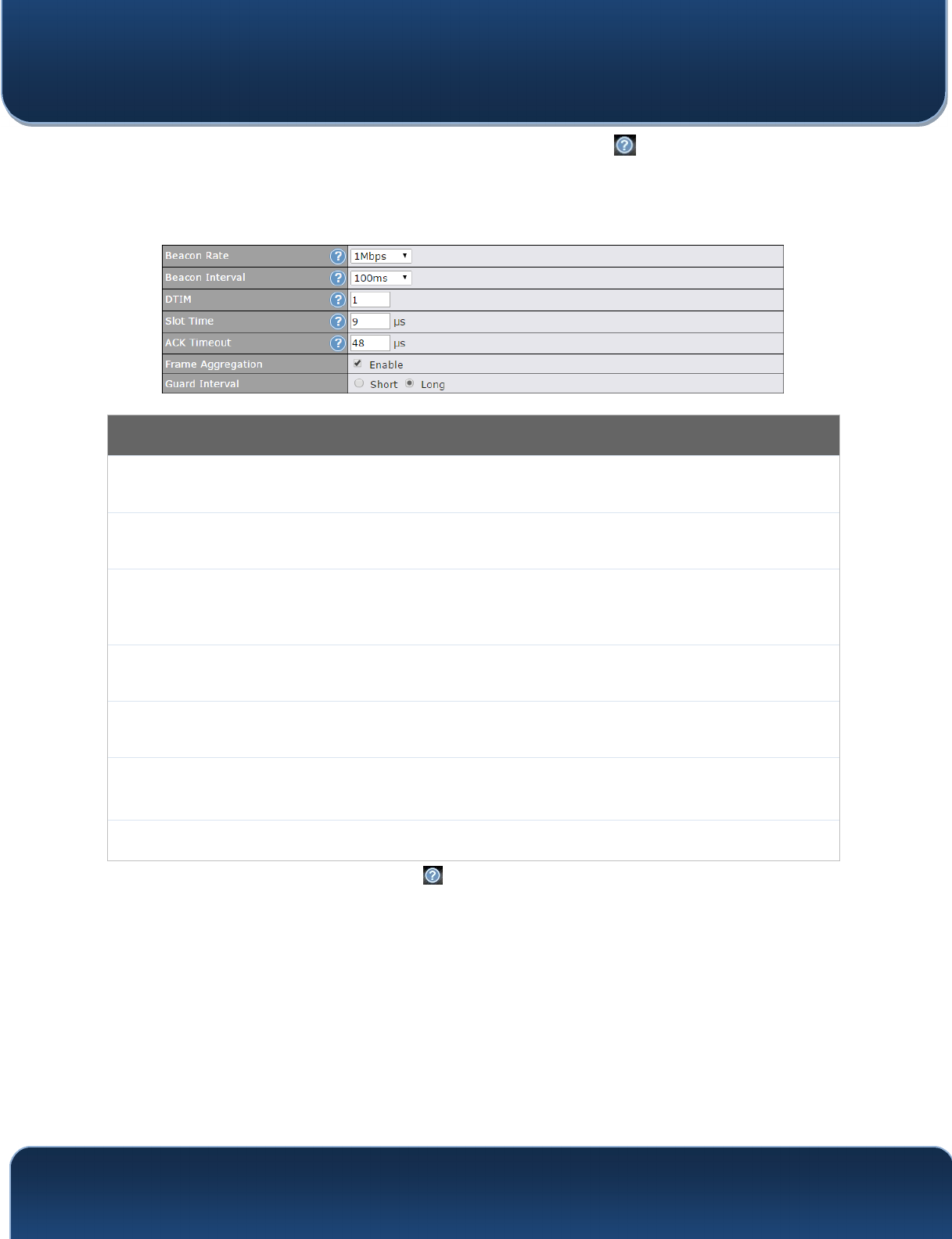
Pepwave MAX and Surf User Manual
http://www.pepwave.com 81 Copyright @ 2016 Pepwave
Advanced Wi-Fi AP settings can be displayed by clicking the on the top right-hand
corner of the Wi-Fi AP Settings section, which can be found at AP>Settings. Other
models will display a separate section called Wi-Fi AP Advanced Settings, which can
be found at Advanced>Wi-Fi Settings.
Wi-Fi AP Advanced Settings
Beacon Rate
A
This option is for setting the transmit bit rate for sending a beacon. By default, 1Mbps is
selected.
Beacon Interval
A
This option is for setting the time interval between each beacon. By default, 100ms is
selected.
DTIM
A
This field allows you to set the frequency for the beacon to include delivery traffic
indication messages. The interval is measured in milliseconds. The default value is set to
1 ms.
Slot Time
A
This field is for specifying the unit wait time before transmitting a packet. By default, this
field is set to 9 µs.
ACK Timeout
A
This field is for setting the wait time to receive an acknowledgement packet before
performing a retransmission. By default, this field is set to 48 µs.
Frame
Aggregation
A
This option allows you to enable frame aggregation to increase transmission throughput.
Guard Interval
A
This is where you opt for a short or long guard period interval for your transmissions.
A
- Advanced feature, please click the button on the top right-hand corner to activate.
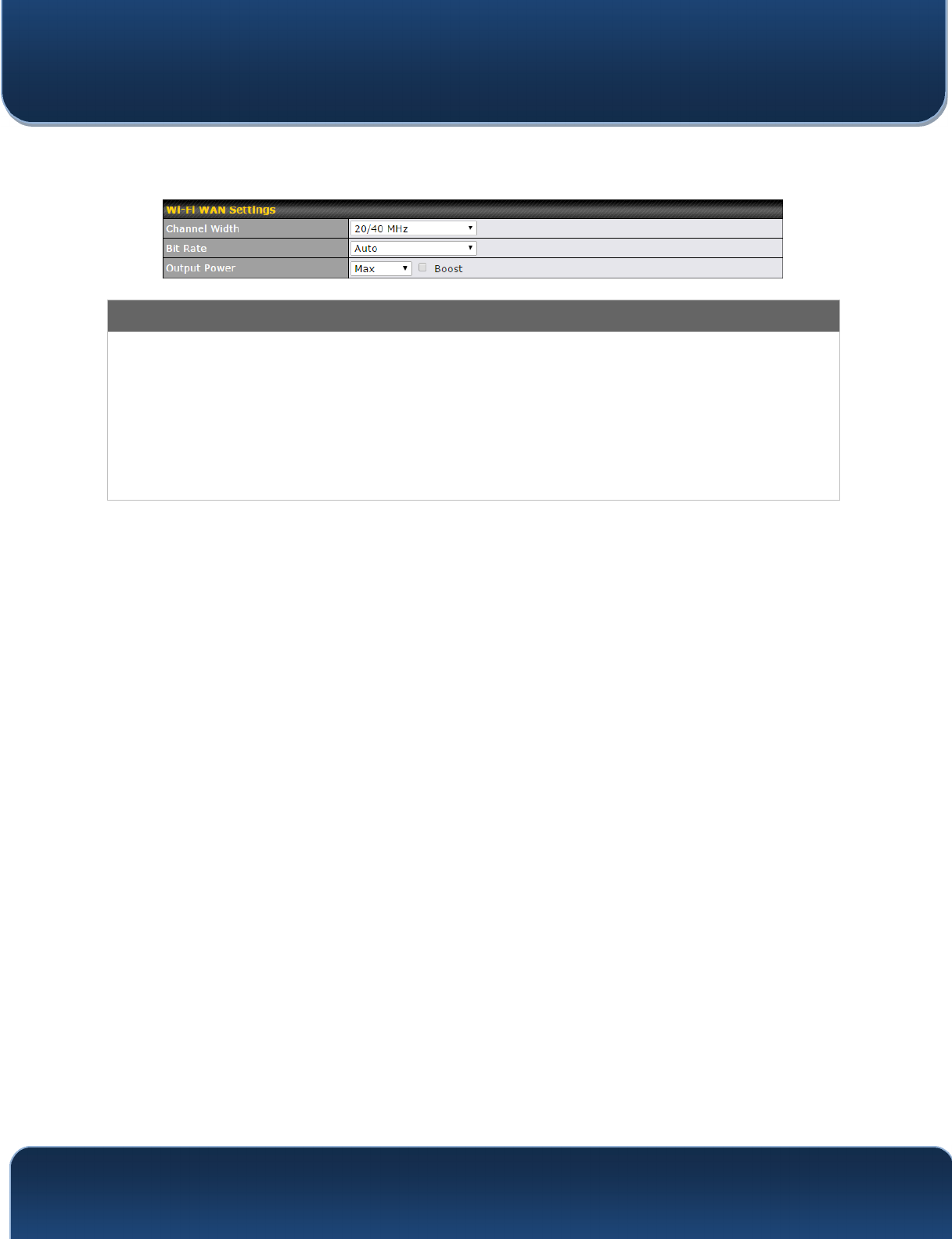
Pepwave MAX and Surf User Manual
http://www.pepwave.com 82 Copyright @ 2016 Pepwave
Wi-Fi WAN settings can be configured at Advanced>Wi-Fi Settings (or
Advanced>Wi-Fi WAN or some models).
Wi-Fi WAN Settings
Channel Width
Available options are 20/40 MHz and 20 MHz. Default is 20/40 MHz, which allows both
widths to be used simultaneously.
Bit Rate
This option allows you to select a specific bit rate for data transfer over the device’s Wi-
Fi network. By default, Auto is selected.
Output Power
This option is for specifying the transmission output power for the Wi-Fi AP. There are 4
relative power levels available – Max, High, Mid, and Low. The actual output power
will be bound by the regulatory limits of the selected country. Note that selecting the
Boost option may cause the MAX’s radio output to exceed local regulatory limits.
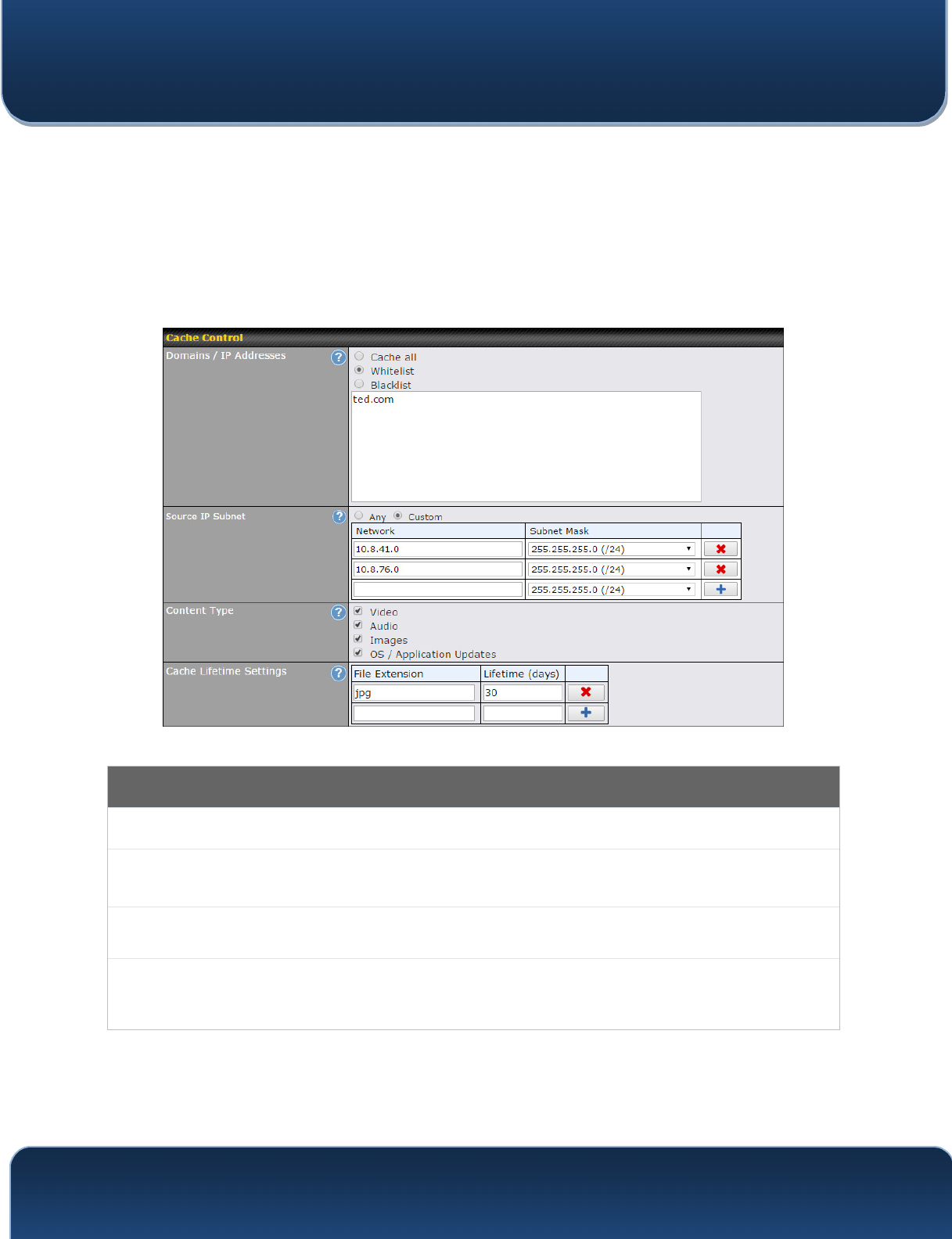
Pepwave MAX and Surf User Manual
http://www.pepwave.com 83 Copyright @ 2016 Pepwave
12 MediaFast Configuration
MediaFast settings can be configured from the Network menu.
12.1 Setting Up MediaFast Content Caching
To access MediaFast content caching settings, select Advanced>Cache Control.
Cache Control Settings
Domain
Choose to Cache on all domains, or enter domain names and then choose either Cache
the specified domains only or Do not cache the specified domains.
Source IP
Subnet
This setting allows caching to be applied to the user-specified IP subnets. If "Any" is
selected, then caching will apply to all subnets.
Content Type
Check these boxes to cache the listed content types or leave boxes unchecked to disable
caching for the listed types.
Cache Lifetime
Settings
Enter a file extension, such as JPG or DOC. Then enter a lifetime in days to specify how
long files with that extension will be cached. Add or delete entries using the controls on the
right.
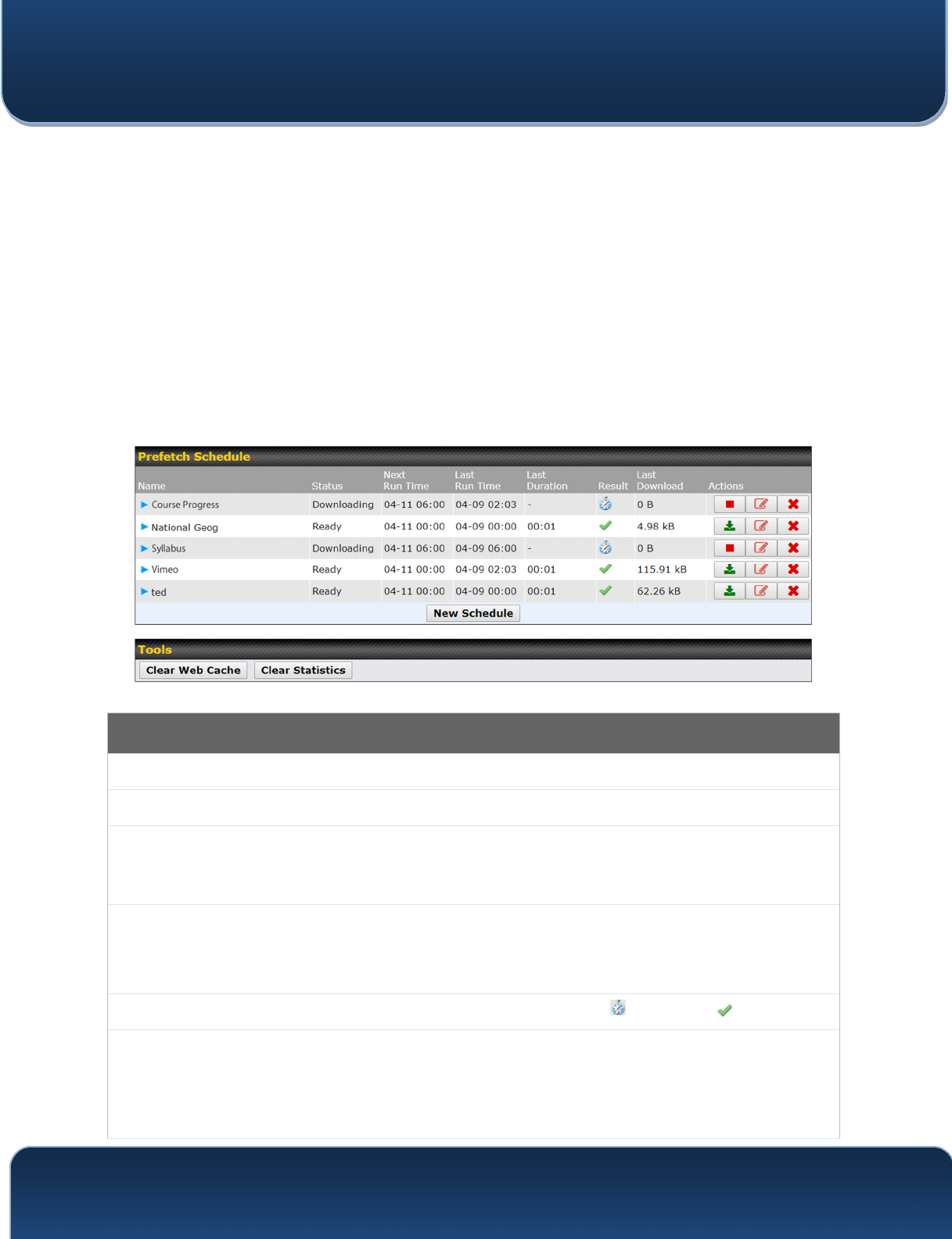
Pepwave MAX and Surf User Manual
http://www.pepwave.com 84 Copyright @ 2016 Pepwave
12.2 Scheduling Content Prefetching
Content prefetching allows you to download content on a schedule that you define,
which can help to preserve network bandwidth during busy times and keep costs down.
To access MediaFast content prefetching settings, select Advanced >Prefetch
Schedule.
Prefetch Schedule Settings
Name
This field displays the name given to the scheduled download.
Status
Check the status of your scheduled download here.
Next Run
Time/Last Run
Time
These fields display the date and time of the next and most recent occurrences of the
scheduled download.
Last Duration
Check this field to ensure that the most recent download took as long as expected to
complete. A value that is too low might indicate an incomplete download or incorrectly
specified download target, while a value that is too long could mean a download with an
incorrectly specified target or stop time.
Result
This field indicates whether downloads are in progress ( ) or complete ( ).
Last Download
Check this field to ensure that the most recent download file size is within the expected
range. A value that is too low might indicate an incomplete download or incorrectly specified
download target, while a value that is too long could mean a download with an incorrectly
specified target or stop time. This field is also useful for quickly seeing which downloads are
consuming the most storage space.
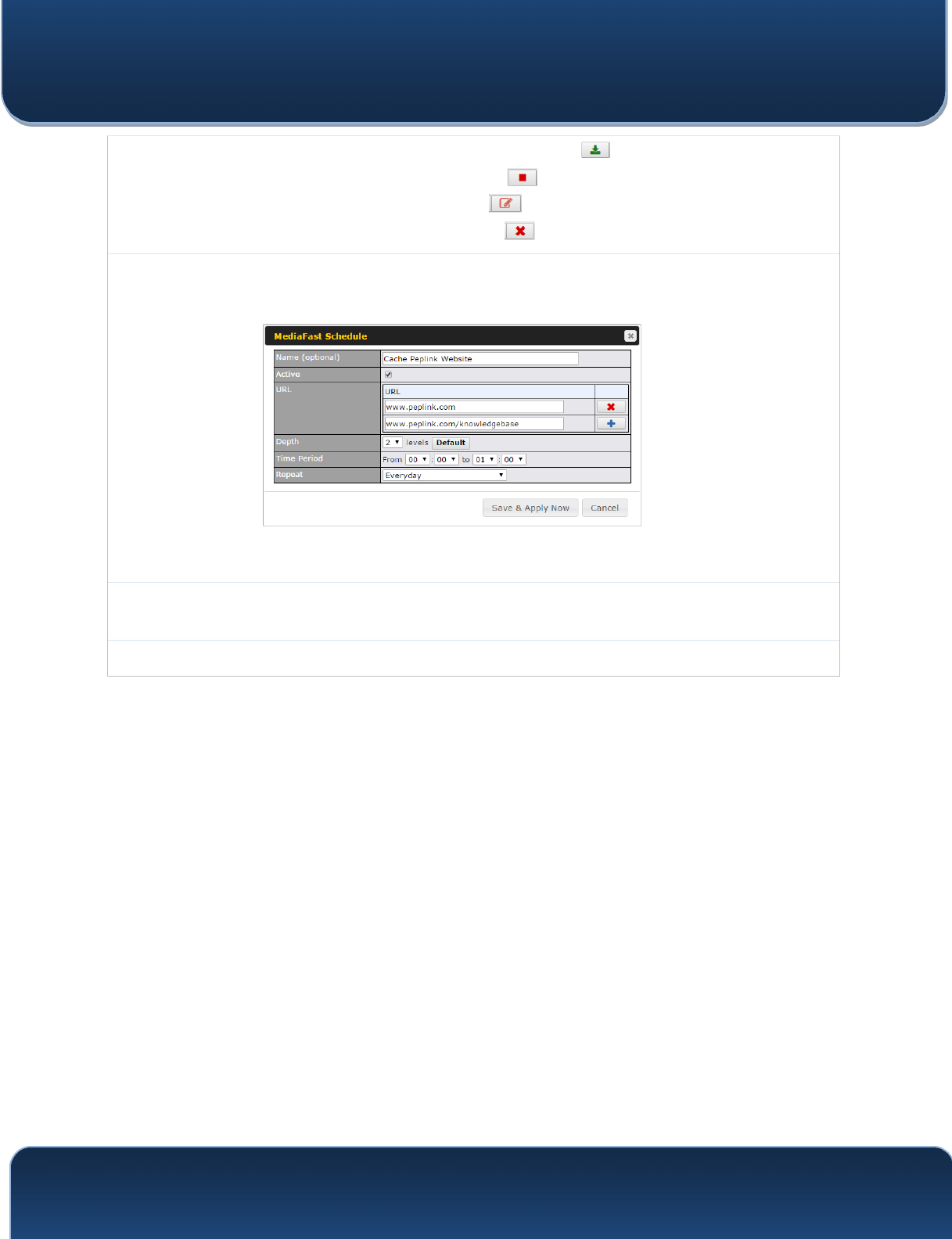
Pepwave MAX and Surf User Manual
http://www.pepwave.com 85 Copyright @ 2016 Pepwave
Actions
To begin a scheduled download immediately, click
.
To cancel a scheduled download, click
.
To edit a scheduled download, click
.
To delete a scheduled download, click
.
New Schedule
Click to begin creating a new scheduled download. Clicking the button will cause the
following screen to appear:
Simply provide the requested information to create your schedule.
Clear Web
Cache
To clear all cached content, click this button. Note that this action cannot be undone.
Clear Statistics
To clear all prefetch and status page statistics, click this button.
12.3 Viewing MediaFast Statistics
To get details on storage and bandwidth usage, select Status>MediaFast.
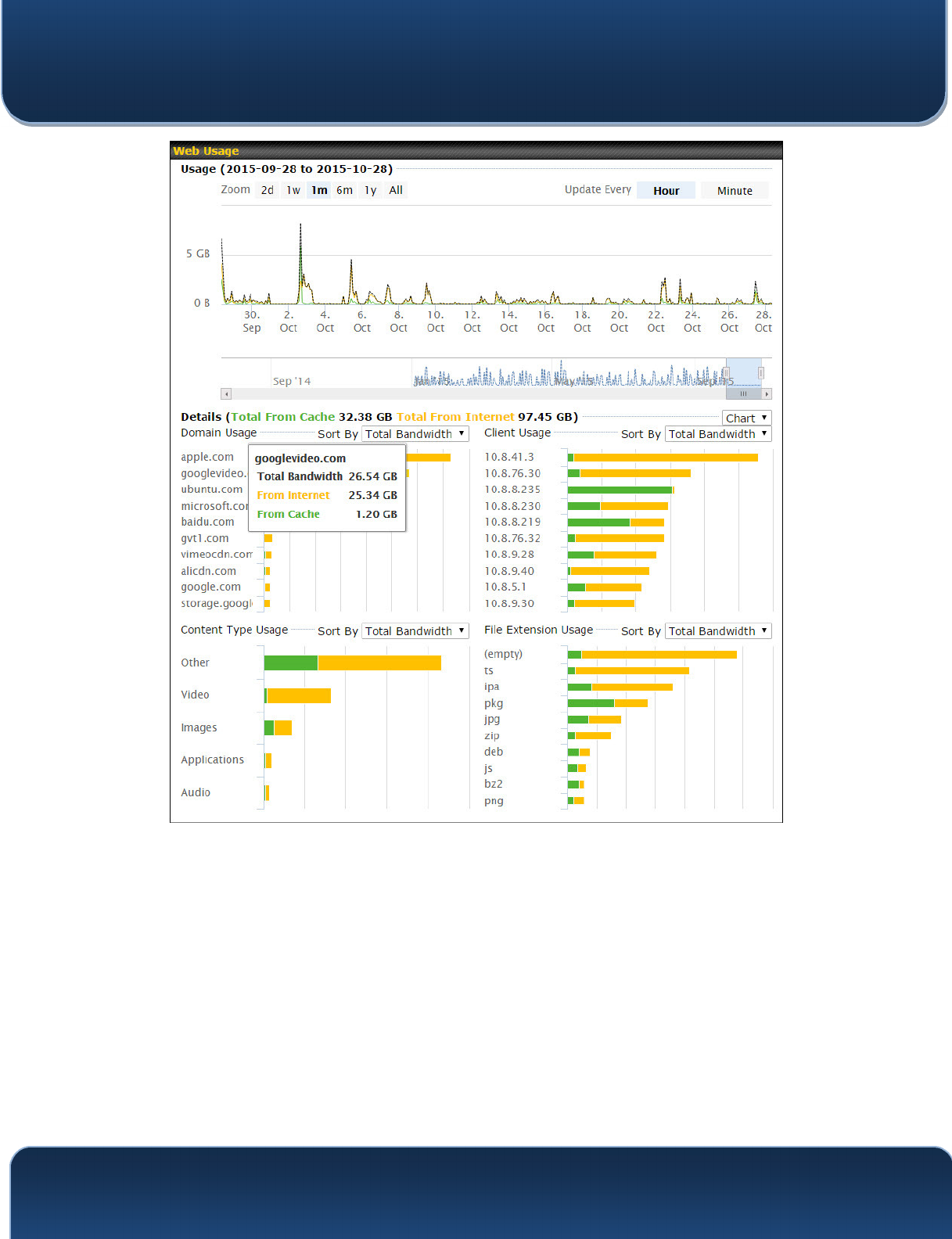
Pepwave MAX and Surf User Manual
http://www.pepwave.com 86 Copyright @ 2016 Pepwave

Pepwave MAX and Surf User Manual
http://www.pepwave.com 87 Copyright @ 2016 Pepwave
13 Bandwidth Bonding SpeedFusion
TM
/ PepVPN
Pepwave bandwidth bonding SpeedFusionTM is our patented technology that enables
our SD-WAN routers to bond multiple Internet connections to increase site-to-site
bandwidth and reliability. SpeedFusion functionality securely connects your Pepwave
router to another Pepwave or Peplink device (Peplink Balance
210/310/380/580/710/1350 only). Data, voice, or video communications between these
locations are kept confidential across the public Internet.
Bandwidth bonding SpeedFusion
TM
is specifically designed for multi-WAN environments.
In case of failures and network congestion at one or more WANs, other WANs can be
used to continue carrying the network traffic.
Different models of our SD-WAN routers have different numbers of site-to-site
connections allowed. End-users who need to have more site-to-site connections can
purchase a SpeedFusion license to increase the number of site-to-site connections
allowed.
Pepwave routers can aggregate all WAN connections’ bandwidth for routing
SpeedFusion
TM
traffic. Unless all the WAN connections of one site are down, Pepwave
routers can keep the VPN up and running.
VPN bandwidth bonding is supported in Firmware 5.1 or above. All available bandwidth
will be utilized to establish the VPN tunnel, and all traffic will be load balanced at packet
level across all links. VPN bandwidth bonding is enabled by default.
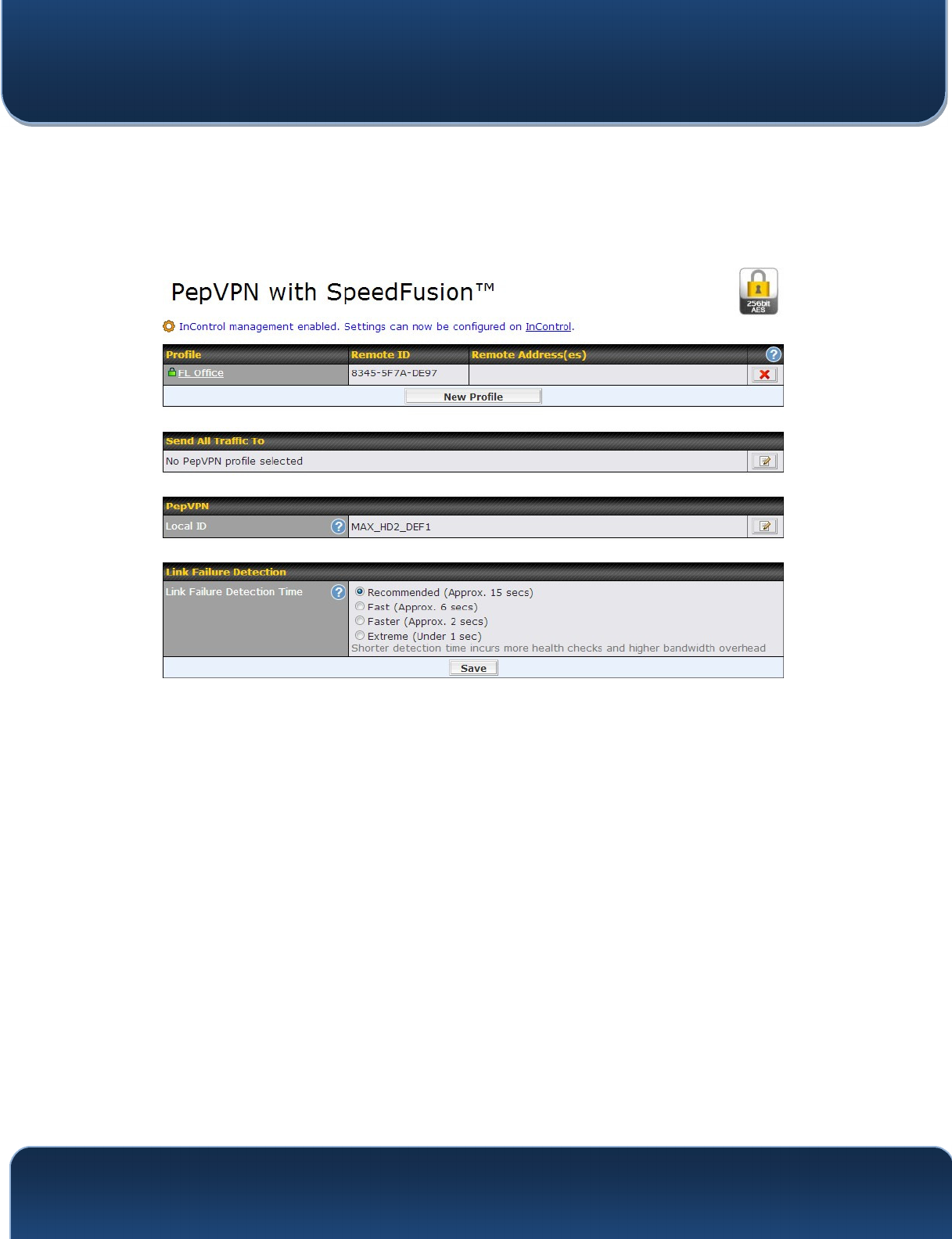
Pepwave MAX and Surf User Manual
http://www.pepwave.com 88 Copyright @ 2016 Pepwave
13.1 PepVPN
To configure PepVPN and SpeedFusion, navigate to Advanced>SpeedFusion™ or
Advanced>PepVPN.
The local LAN subnet and subnets behind the LAN (defined under Static Route on the
LAN settings page) will be advertised to the VPN. All VPN members (branch offices and
headquarters) will be able to route to local subnets.
Note that all LAN subnets and the subnets behind them must be unique. Otherwise,
VPN members will not be able to access each other.
All data can be routed over the VPN using the 256-bit AES encryption standard. To
configure, navigate to Advanced>SpeedFusion™ or Advanced>PepVPN and click
the New Profile button to create a new VPN profile (you may have to first save the
displayed default profile in order to acesss the New Profile button). Each profile
specifies the settings for making VPN connection with one remote Pepwave or Peplink
device. Note that available settings vary by model.
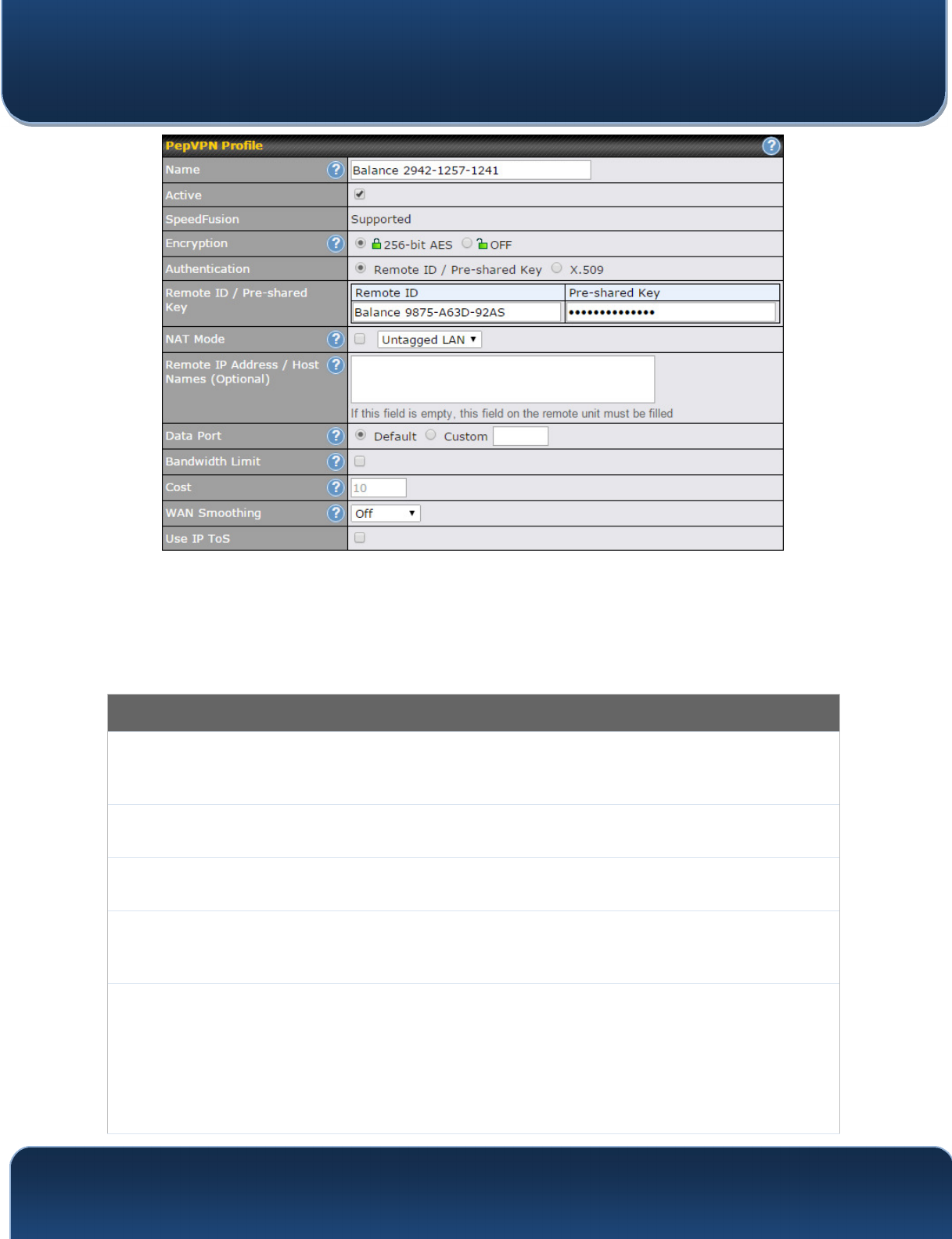
Pepwave MAX and Surf User Manual
http://www.pepwave.com 89 Copyright @ 2016 Pepwave
A list of defined SpeedFusion
connection profiles and a Link Failure Detection Time
option will be shown. Click the New Profile button to create a new VPN connection
profile for making a VPN connection to a remote Peplink Balance via the available WAN
connections. Each profile is for making a VPN connection with one remote Peplink
Balance.
PepVPN Profile Settings
Name
This field is for specifying a name to represent this profile. The name can be any
combination of alphanumeric characters (0-9, A-Z, a-z), underscores (_), dashes (-), and/or
non-leading/trailing spaces ( ).
Active
When this box is checked, this VPN connection profile will be enabled. Otherwise, it will be
disabled.
Encryption
By default, VPN traffic is encrypted with 256-bit AES. If Off is selected on both sides of a
VPN connection, no encryption will be applied.
Authentication
Select from By Remote ID Only, Preshared Key, or X.509 to specify the method the
Peplink Balance will use to authenticate peers. When selecting By Remote ID Only, be
sure to enter a unique peer ID number in the Remote ID field.
Remote ID /
Pre-shared Key
This optional field becomes available when Remote ID / Pre-shared Key is selected as the
Peplink Balance’s VPN Authentication method, as explained above. Pre-shared Key
defines the pre-shared key used for this particular VPN connection. The VPN connection's
session key will be further protected by the pre-shared key. The connection will be up only if
the pre-shared keys on each side match. When the peer is running firmware 5.0+, this
setting will be ignored.

Pepwave MAX and Surf User Manual
http://www.pepwave.com 90 Copyright @ 2016 Pepwave
Enter Remote IDs either by typing out each Remote ID and Pre-shared Key, or by pasting a
CSV. If you wish to paste a CSV, click the icon next to the “Remote ID / Preshared Key”
setting.
Remote
ID/Remote
Certificate
These optional fields become available when X.509 is selected as the Peplink Balance’s
VPN authentication method, as explained above. To authenticate VPN connections using
X.509 certificates, copy and paste certificate details into these fields. To get more
information on a listed X.509 certificate, click the Show Details link below the field.
Allow Shared
Remote ID
When this option is enabled, the router will allow multiple peers to run using the same
remote ID.
NAT Mode
Check this box to allow the local DHCP server to assign an IP address to the remote peer.
When NAT Mode is enabled, all remote traffic over the VPN will be tagged with the
assigned IP address using network address translation.
Remote IP
Address / Host
Names
(Optional)
If NAT Mode is not enabled, you can enter a remote peer’s WAN IP address or
hostname(s) here. If the remote uses more than one address, enter only one of them here.
Multiple hostnames are allowed and can be separated by a space character or carriage
return. Dynamic-DNS host names are also accepted.
This field is optional. With this field filled, the Peplink Balance will initiate connection to each
of the remote IP addresses until it succeeds in making a connection. If the field is empty,
the Peplink Balance will wait for connection from the remote peer. Therefore, at least one of
the two VPN peers must specify this value. Otherwise, VPN connections cannot be
established.
Data Port
This field is used to specify a UDP port number for transporting outgoing VPN data. If
Default is selected, UDP port 4500 will be used. Port 32015 will be used if the remote unit
uses Firmware prior to version 5.4 or if port 4500 is unavailable. If Custom is selected,
enter an outgoing port number from 1 to 65535.
Bandwidth
Limit
Define maximum download and upload speed to each individual peer. This functionality
requires the peer to use PepVPN version 4.0.0 or above.
Cost
Define path cost for this profile.
OSPF will determine the best route through the network using the assigned cost.
Default: 10
WAN
Smoothing
A
Select the degree to which WAN Smoothing will be implemented across your WAN links.
A
- Advanced feature, please click the button on the top right-hand corner to activate.
To enable Layer 2 Bridging between PepVPN profiles, navigate to
Network>LAN>Basic Settings>*LAN Profile Name* and refer to instructions in
section 9.1
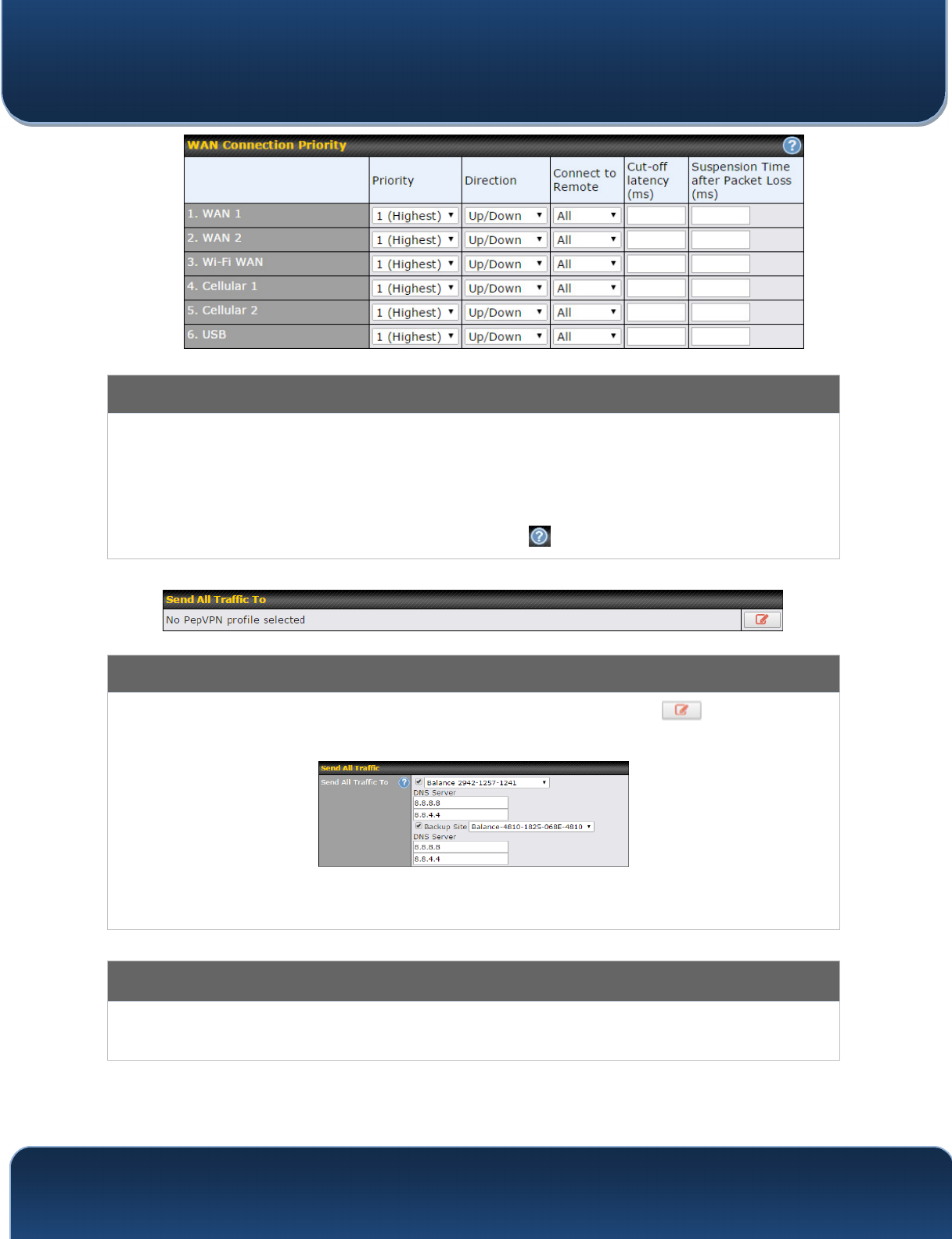
Pepwave MAX and Surf User Manual
http://www.pepwave.com 91 Copyright @ 2016 Pepwave
8.41
WAN Connection Priority
WAN
Connection
Priority
If your device supports it, you can specify the priority of WAN connections to be used for
making VPN connections. WAN connections set to OFF will never be used. Only available
WAN connections with the highest priority will be used.
To enable asymmetric connections, connection mapping to remote WANs, cut-off latency,
and packet loss suspension time, click the button.
Send All Traffic To
This feature allows you to redirect all traffic to a specified PepVPN connection. Click the button to select your
connection and the following menu will appear:
You could also specify a DNS server to resolve incoming DNS requests. Click the checkbox next to Backup Site to
designate a backup SpeedFusion profile that will take over, should the main PepVPN connection fail.
Outbound Policy/PepVPN Outbound Custom Rules
Some models allow you to set outbound policy and custom outbound rules from Advanced>PepVPN. See Section
14 for more information on outbound policy settings.
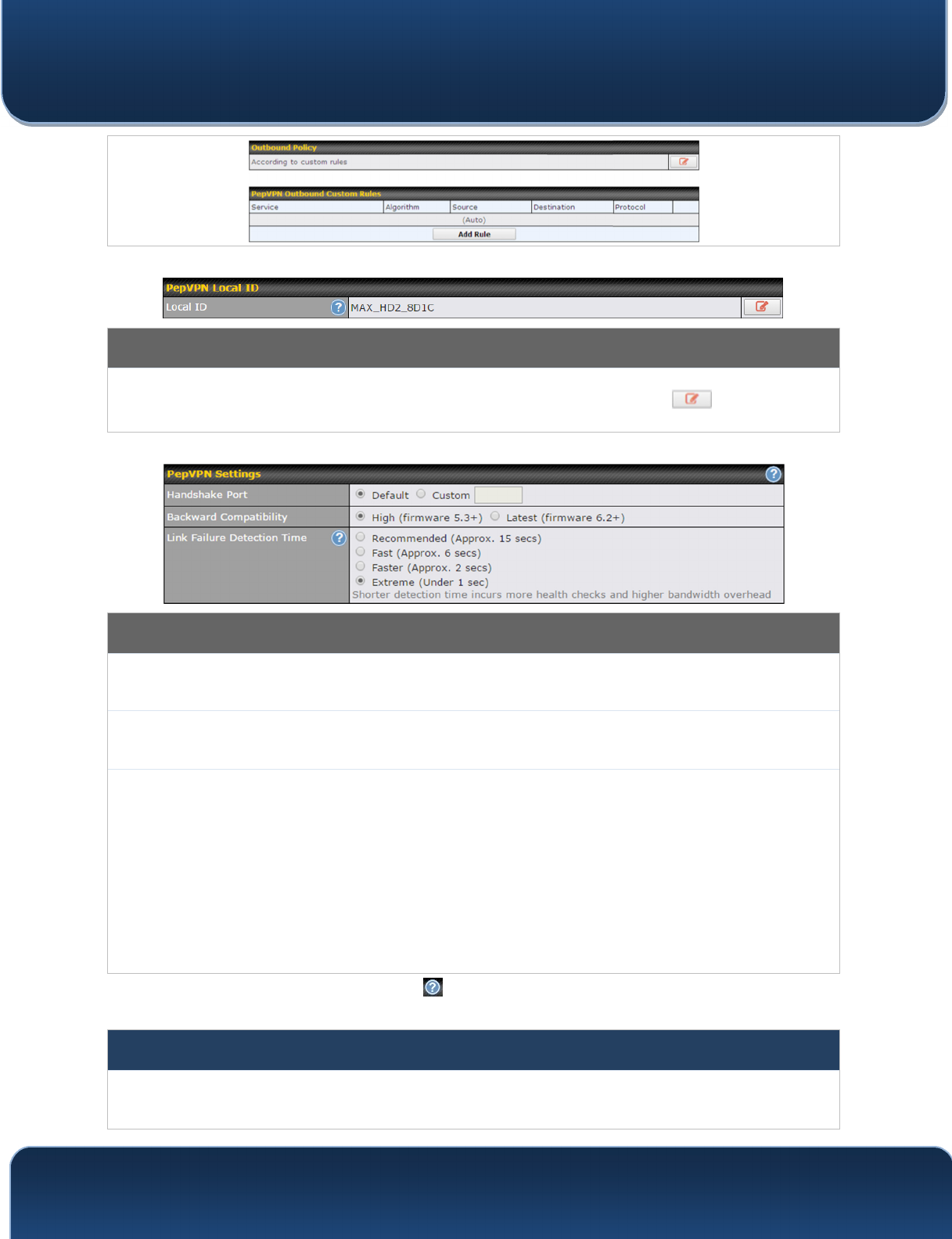
Pepwave MAX and Surf User Manual
http://www.pepwave.com 92 Copyright @ 2016 Pepwave
PepVPN Local ID
The local ID is a text string to identify this local unit when establishing a VPN connection. When creating a profile on
a remote unit, this local ID must be entered in the remote unit's Remote ID field. Click the icon to edit Local
ID.
PepVPN Settings
Handshake
Port
A
To designate a custom handshake port (TCP), click the custom radio button and enter the
port number you wish to designate.
Backward
Compatibility
Determine the level of backward compatibility needed for PepVPN tunnels. The use of the
Latest setting is recommended as it will improve the performance and resilience of
SpeedFusion connections.
Link Failure
Detection Time
The bonded VPN can detect routing failures on the path between two sites over each WAN
connection. Failed WAN connections will not be used to route VPN traffic. Health check
packets are sent to the remote unit to detect any failure. The more frequently checks are
sent, the shorter the detection time, although more bandwidth will be consumed.
When Recommended (default) is selected, a health check packet is sent every five
seconds, and the expected detection time is 15 seconds.
When Fast is selected, a health check packet is sent every three seconds, and the
expected detection time is six seconds.
When Faster is selected, a health check packet is sent every second, and the expected
detection time is two seconds.
When Extreme is selected, a health check packet is sent every 0.1 second, and the
expected detection time is less than one second.
A
- Advanced feature, please click the button on the top right-hand corner to activate.
Important Note
Peplink proprietary SpeedFusion
TM
uses TCP port 32015 and UDP port 4500 for establishing VPN connections. If
you have a firewall in front of your Pepwave devices, you will need to add firewall rules for these ports and protocols
to allow inbound and outbound traffic to pass through the firewall.
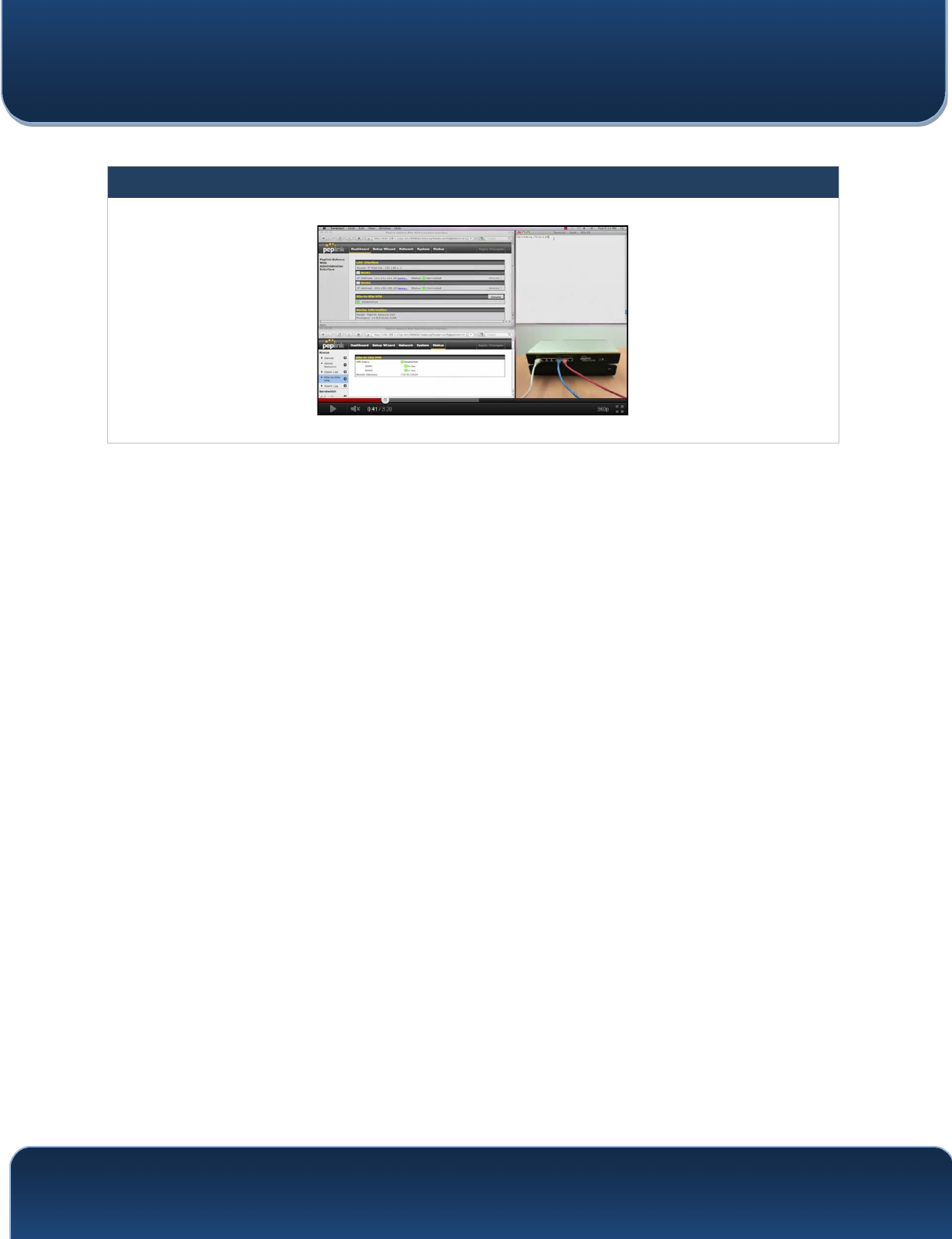
Pepwave MAX and Surf User Manual
http://www.pepwave.com 93 Copyright @ 2016 Pepwave
Tip
Want to know more about VPN sub-second session failover? Visit our YouTube Channel for a video tutorial!
http://youtu.be/TLQgdpPSY88
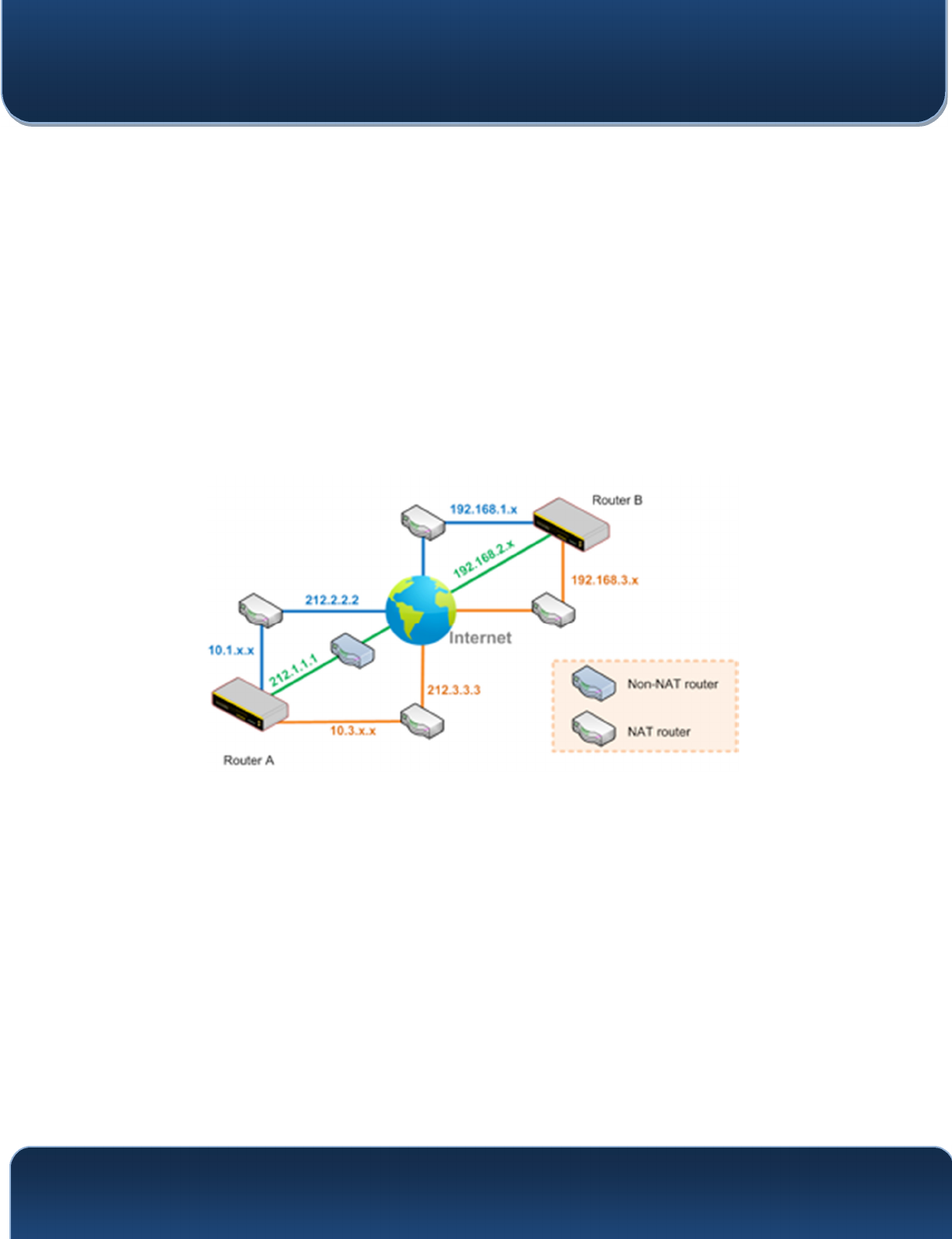
Pepwave MAX and Surf User Manual
http://www.pepwave.com 94 Copyright @ 2016 Pepwave
13.2 The Pepwave Router Behind a NAT Router
Pepwave routers support establishing SpeedFusion
TM
over WAN connections which are
behind a NAT (network address translation) router.
To enable a WAN connection behind a NAT router to accept VPN connections, you can
configure the NAT router in front of the WAN connection to inbound port-forward TCP
port 32015 to the Pepwave router.
If one or more WAN connections on Unit A can accept VPN connections (by means of
port forwarding or not), while none of the WAN connections on the peer Unit B can do
so, you should enter all of Unit A’s public IP addresses or hostnames into Unit B’s
Remote IP Addresses / Host Names field. Leave the field in Unit A blank. With this
setting, a SpeedFusion
TM
connection can be set up and all WAN connections on both
sides will be utilized.
See the following diagram for an example of this setup in use:
One of the WANs connected to Router A is non-NAT’d (212.1.1.1). The rest of the
WANs connected to Router A and all WANs connected to Router B are NAT’d. In this
case, the Peer IP Addresses / Host Names field for Router B should be filled with all of
Router A’s hostnames or public IP addresses (i.e., 212.1.1.1, 212.2.2.2, and 212.3.3.3),
and the field in Router A can be left blank. The two NAT routers on WAN1 and WAN3
connected to Router A should inbound port-forward TCP port 32015 to Router A so that
all WANs will be utilized in establishing the VPN.
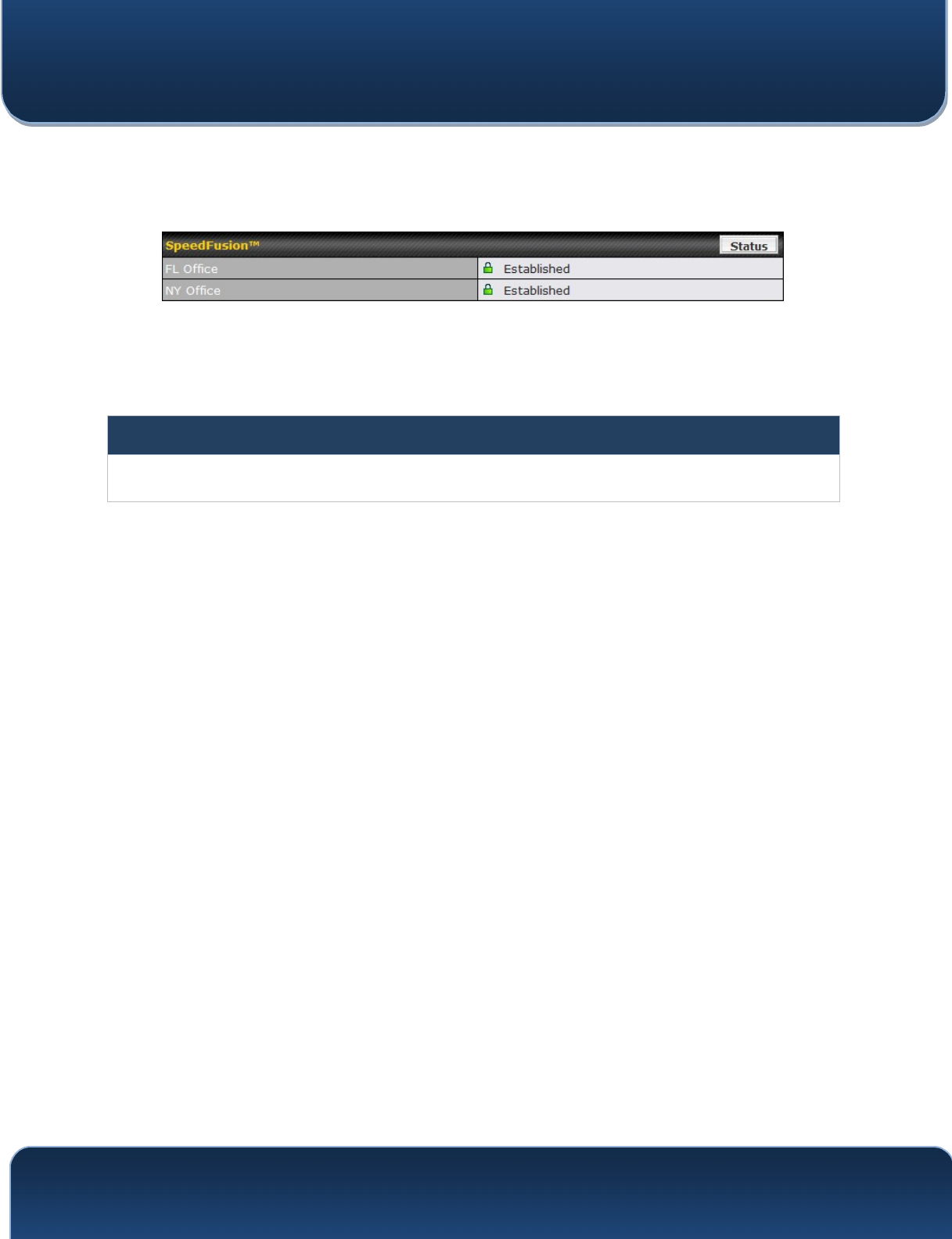
Pepwave MAX and Surf User Manual
http://www.pepwave.com 95 Copyright @ 2016 Pepwave
13.3 SpeedFusion
TM
Status
SpeedFusion
TM
status is shown in the Dashboard. The connection status of each
connection profile is shown as below.
After clicking the Status button at the top right corner of the SpeedFusion
TM
table, you
will be forwarded to Status>SpeedFusion
TM
, where you can view subnet and WAN
connection information for each VPN peer. Please refer to Section 22.6 for details.
IP Subnets Must Be Unique Among VPN Peers
The entire interconnected SpeedFusion
TM
network is a single non-NAT IP network. Avoid duplicating subnets in
your sites to prevent connectivity problems when accessing those subnets.
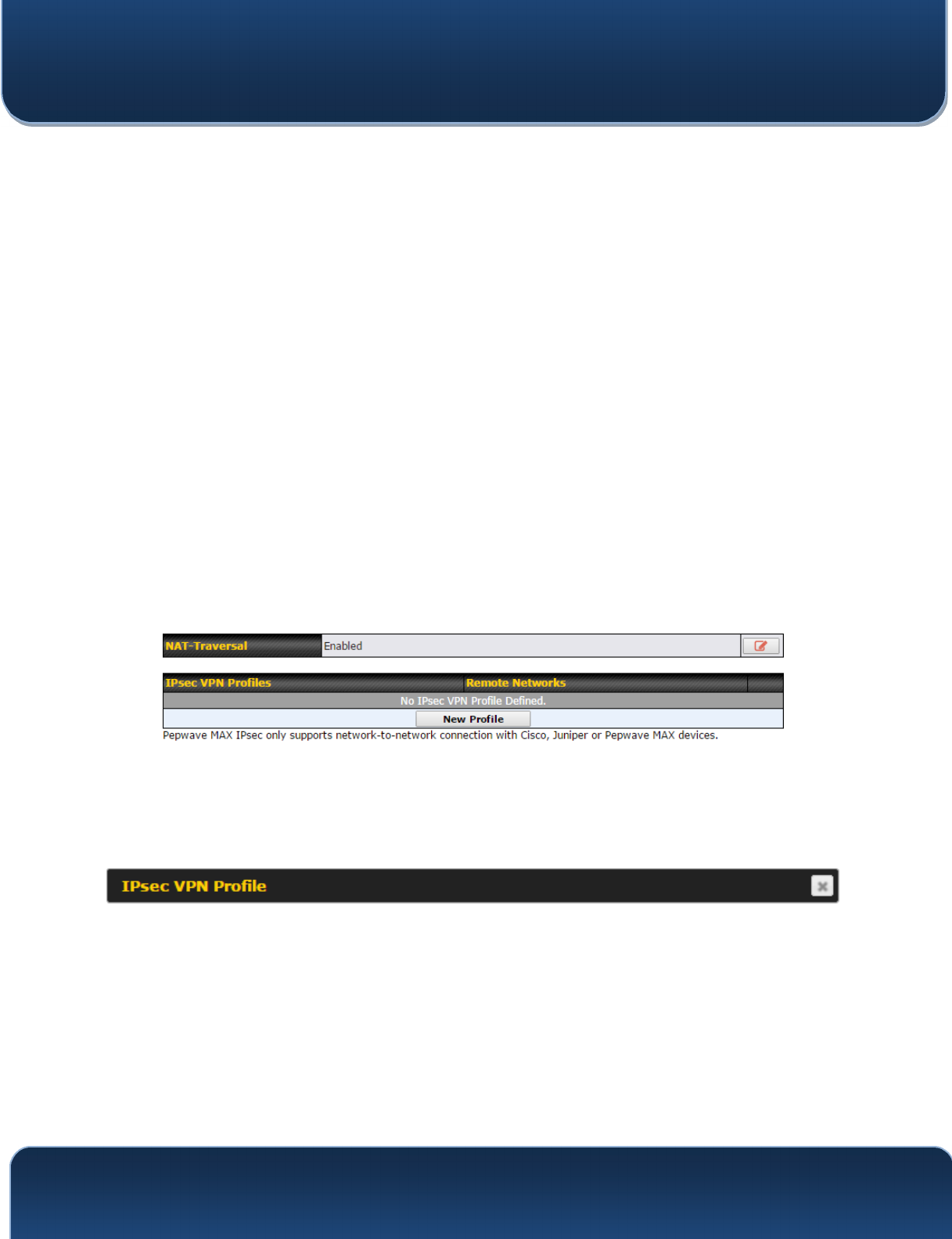
Pepwave MAX and Surf User Manual
http://www.pepwave.com 96 Copyright @ 2016 Pepwave
14 IPsec VPN
IPsec VPN functionality securely connects one or more branch offices to your
company's main headquarters or to other branches. Data, voice, and video
communications between these locations are kept safe and confidential across the
public Internet.
IPsec VPN on Pepwave routers is specially designed for multi-WAN environments. For
instance, if a user sets up multiple IPsec profiles for a multi-WAN environment and
WAN1 is connected and healthy, IPsec traffic will go through this link. However, should
unforeseen problems (e.g., unplugged cables or ISP problems) cause WAN1 to go
down, our IPsec implementation will make use of WAN2 and WAN3 for failover.
14.1 IPsec VPN Settings
Many Pepwave products can make multiple IPsec VPN connections with Peplink,
Pepwave, Cisco, and Juniper routers. Note that all LAN subnets and the subnets behind
them must be unique. Otherwise, VPN members will not be able to access each other.
All data can be routed over the VPN with a selection of encryption standards, such as
3DES, AES-128, and AES-256. To configure IPsec VPN on Pepwave devices that
support it, navigate to Advanced>IPsec VPN.
A NAT-Traversal option and list of defined IPsec VPN profiles will be shown. NAT-
Traversal should be enabled if your system is behind a NAT router. Click the New
Profile button to create new IPsec VPN profiles that make VPN connections to remote
Pepwave, Cisco, or Juniper routers via available WAN connections. To edit any of the
profiles, click on its associated connection name in the leftmost column.
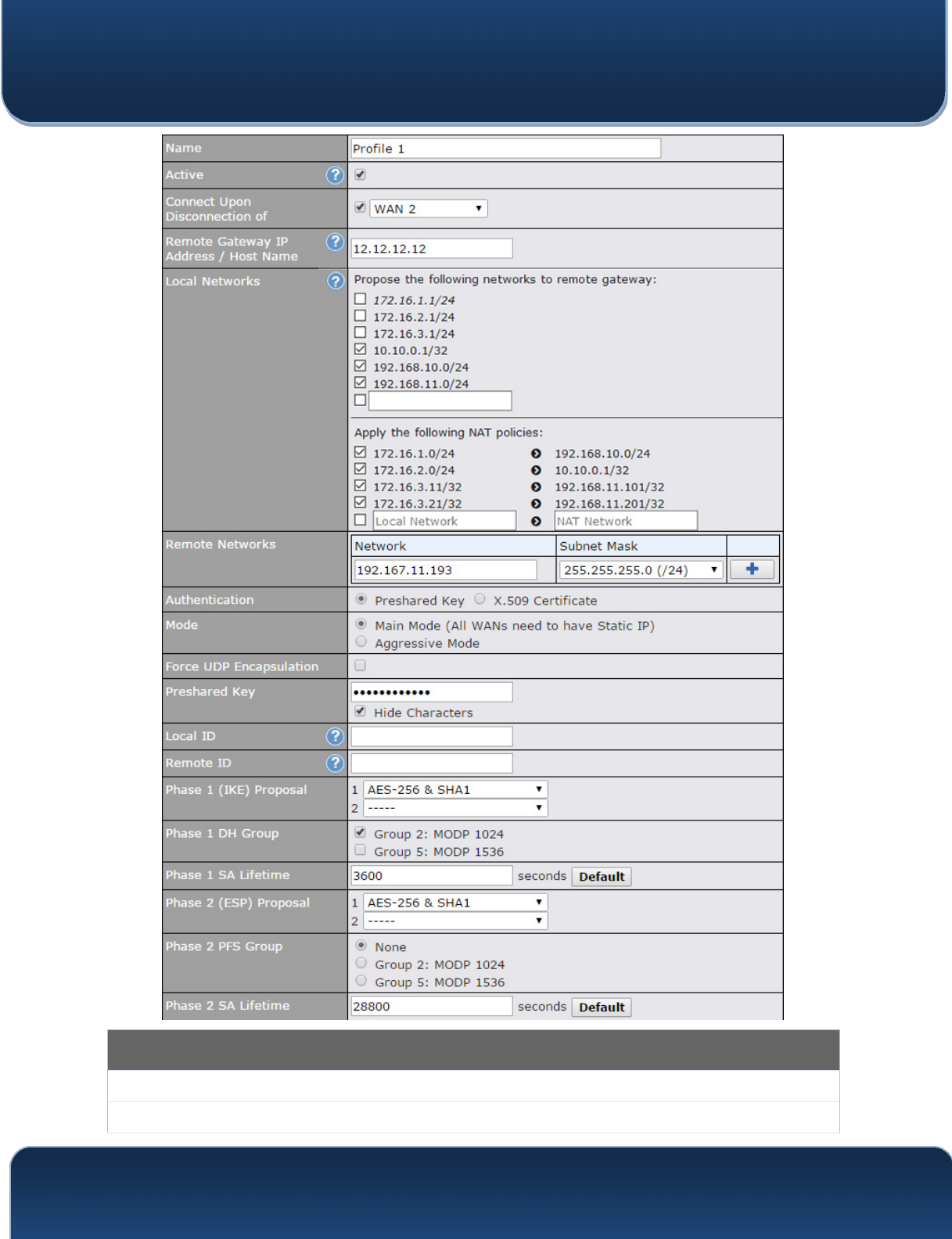
Pepwave MAX and Surf User Manual
http://www.pepwave.com 97 Copyright @ 2016 Pepwave
IPsec VPN Settings
Name
This field is for specifying a local name to represent this connection profile.
Active
When this box is checked, this IPsec VPN connection profile will be enabled. Otherwise, it

Pepwave MAX and Surf User Manual
http://www.pepwave.com 98 Copyright @ 2016 Pepwave
will be disabled.
Connect Upon
Disconnection
of
Check this box and select a WAN to connect to this VPN automatically when the specified
WAN is disconnected.
Remote
Gateway IP
Address /
Host Name
Enter the remote peer’s public IP address. For Aggressive Mode, this is optional.
Local
Networks
Enter the local LAN subnets here. If you have defined static routes, they will be shown
here.
Using NAT, you can map a specific local network / IP address to another, and the packets
received by remote gateway will appear to be coming from the mapped network / IP
address. This allow you to establish IPsec connection to a remote site that has one or
more subnets overlapped with local site.
Two types of NAT policies can be defined:
One-to-One NAT policy: if the defined subnet in Local Network and NAT Network has the
same size, for example, policy "192.168.50.0/24 > 172.16.1.0/24" will translate the local
IP address 192.168.50.10 to 172.16.1.10 and 192.168.50.20 to 172.16.1.20. This is a
bidirectional mapping which means clients in remote site can initiate connection to the
local clients using the mapped address too.
Many-to-One NAT policy: if the defined NAT Network on the right hand side is an IP
address (or having a network prefix /32), for example, policy "192.168.1.0/24 >
172.168.50.1/32" will translate all clients in 192.168.1.0/24 network to 172.168.50.1. This
is a unidirectional mapping which means clients in remote site will not be able to initiate
connection to the local clients.
Remote
Networks
Enter the LAN and subnets that are located at the remote site here.
Authentication
To access your VPN, clients will need to authenticate by your choice of methods. Choose
between the Preshared Key and X.509 Certificate methods of authentication.
Mode
Choose Main Mode if both IPsec peers use static IP addresses. Choose Aggressive
Mode if one of the IPsec peers uses dynamic IP addresses.
Force UDP
Encapsulation
For forced UDP encapsulation regardless of NAT-traversal, tick this checkbox.
Pre-shared
Key
This defines the peer authentication pre-shared key used to authenticate this VPN
connection. The connection will be up only if the pre-shared keys on each side match.
Remote
Certificate
(pem
encoded)
Available only when X.509 Certificate is chosen as the Authentication method, this field
allows you to paste a valid X.509 certificate.
Local ID
In Main Mode, this field can be left blank. In Aggressive Mode, if Remote Gateway IP
Address is filled on this end and the peer end, this field can be left blank. Otherwise, this
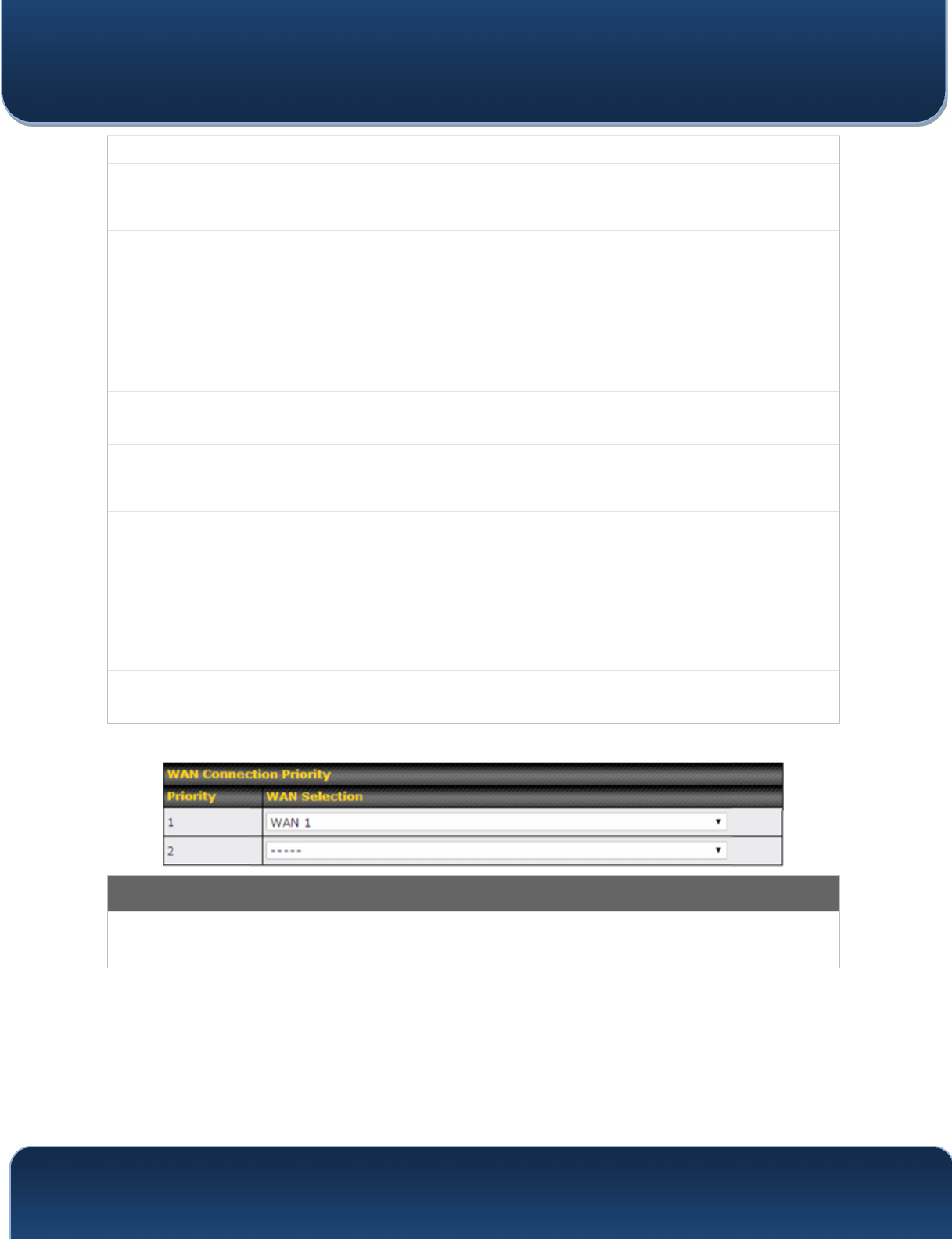
Pepwave MAX and Surf User Manual
http://www.pepwave.com 99 Copyright @ 2016 Pepwave
field is typically a U-FQDN.
Remote ID
In Main Mode, this field can be left blank. In Aggressive Mode, if Remote Gateway IP
Address is filled on this end and the peer end, this field can be left blank. Otherwise, this
field is typically a U-FQDN.
Phase 1 (IKE)
Proposal
In Main Mode, this allows setting up to six encryption standards, in descending order of
priority, to be used in initial connection key negotiations. In Aggressive Mode, only one
selection is permitted.
Phase 1 DH
Group
This is the Diffie-Hellman group used within IKE. This allows two parties to establish a
shared secret over an insecure communications channel. The larger the group number,
the higher the security.
Group 2: 1024-bit is the default value.
Group 5: 1536-bit is the alternative option.
Phase 1 SA
Lifetime
This setting specifies the lifetime limit of this Phase 1 Security Association. By default, it is
set at 3600 seconds.
Phase 2 (ESP)
Proposal
In Main Mode, this allows setting up to six encryption standards, in descending order of
priority, to be used for the IP data that is being transferred. In Aggressive Mode, only
one selection is permitted.
Phase 2 PFS
Group
Perfect forward secrecy (PFS) ensures that if a key was compromised, the attacker will be
able to access only the data protected by that key.
None - Do not request for PFS when initiating connection. However, since there is no
valid reason to refuse PFS, the system will allow the connection to use PFS if requested
by the remote peer. This is the default value.
Group 2: 1024-bit Diffie-Hellman group. The larger the group number, the higher the
security.
Group 5: 1536-bit is the third option.
Phase 2 SA
Lifetime
This setting specifies the lifetime limit of this Phase 2 Security Association. By default, it is
set at 28800 seconds.
WAN Connection Priority
WAN Connection
Select the appropriate WAN connection from the drop-down menu.
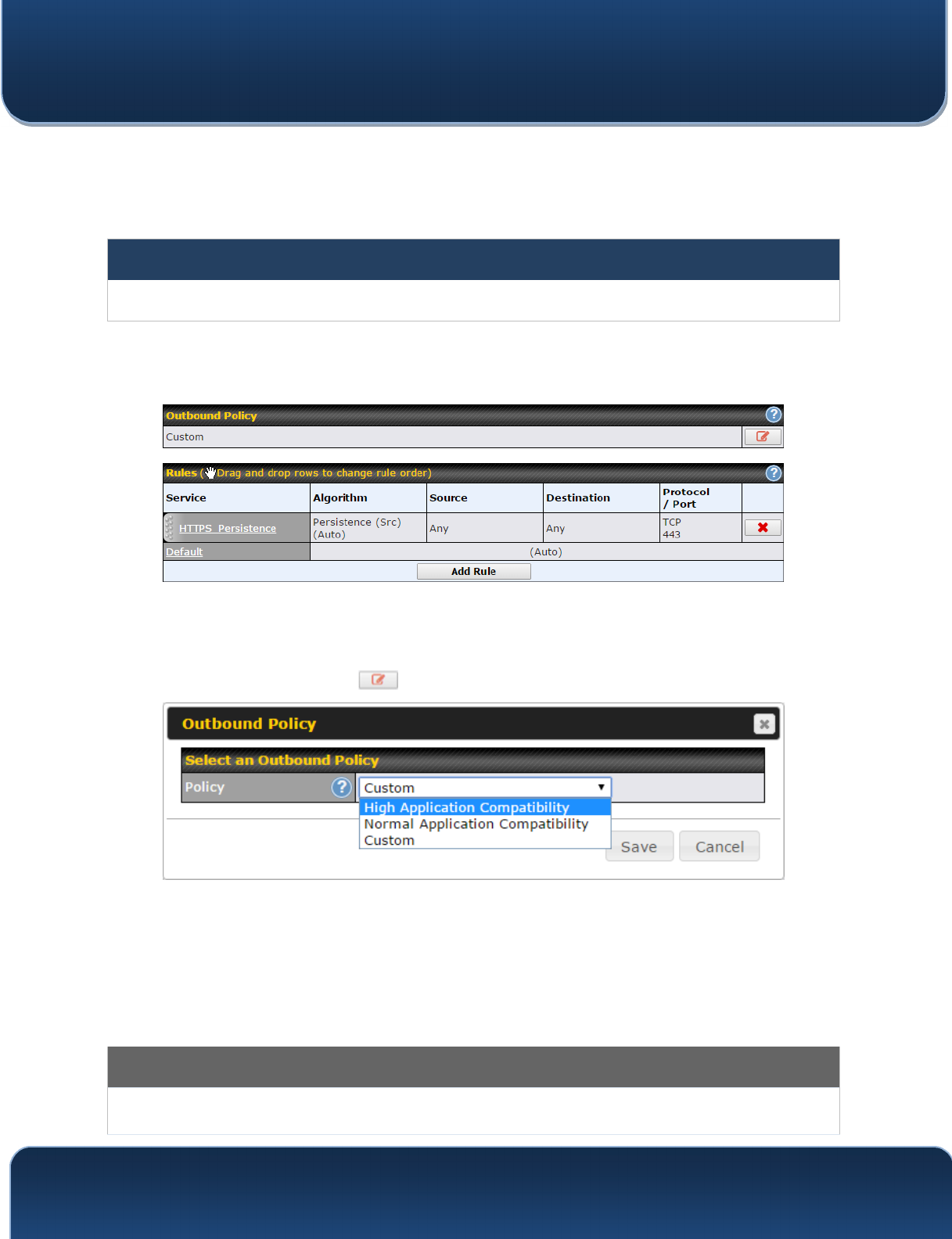
Pepwave MAX and Surf User Manual
http://www.pepwave.com 100 Copyright @ 2016 Pepwave
15 Outbound Policy Management
Pepwave routers can flexibly manage and load balance outbound traffic among WAN
connections.
Important Note
Outbound policy is applied only when more than one WAN connection is active
.
The settings for managing and load balancing outbound traffic are located at
Advanced>Outbound Policy or Advanced>PepVPN, depending on the model.
15.1 Outbound Policy
Outbound policies for managing and load balancing outbound traffic are located at
Network>Outbound Policy> or Advanced>PepVPN>Outbound Policy.
There are three main selections for the outbound traffic policy:
High Application Compatibility
Normal Application Compatibility
Custom
Note that some Pepwave routers provide only the Send All Traffic To setting here. See
Section 12.1 for details.
Outbound Policy Settings
High
Outbound traffic from a source LAN device is routed through the same WAN connection
regardless of the destination Internet IP address and protocol. This option provides the
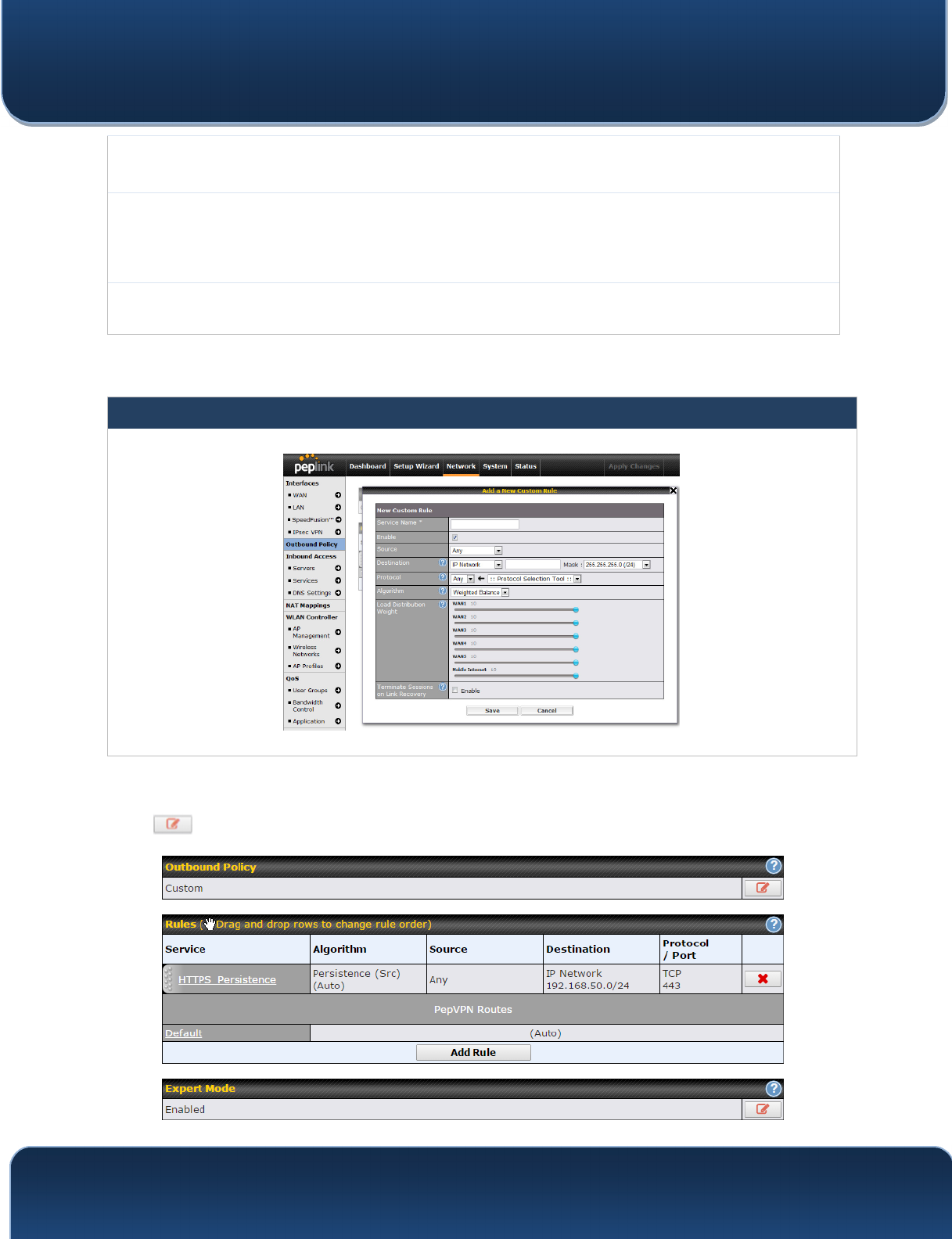
Pepwave MAX and Surf User Manual
http://www.pepwave.com 101 Copyright @ 2016 Pepwave
Application
Compatibility
highest application compatibility.
Normal
Application
Compatibility
Outbound traffic from a source LAN device to the same destination Internet IP address will
be routed through the same WAN connection persistently, regardless of protocol. This
option provides high compatibility to most applications, and users still benefit from WAN link
load balancing when multiple Internet servers are accessed.
Custom
Outbound traffic behavior can be managed by defining rules in a custom rule table. A
default rule can be defined for connections that cannot be matched with any of the rules.
The default policy is Normal Application Compatibility.
Tip
Want to know more about creating outbound rules? Visit our YouTube Channel for a video tutorial!
http://youtu.be/rKH4AS_bQnE
15.2 Custom Rules for Outbound Policy
Click in the Outbound Policy form. Choose Custom and press the Save button.
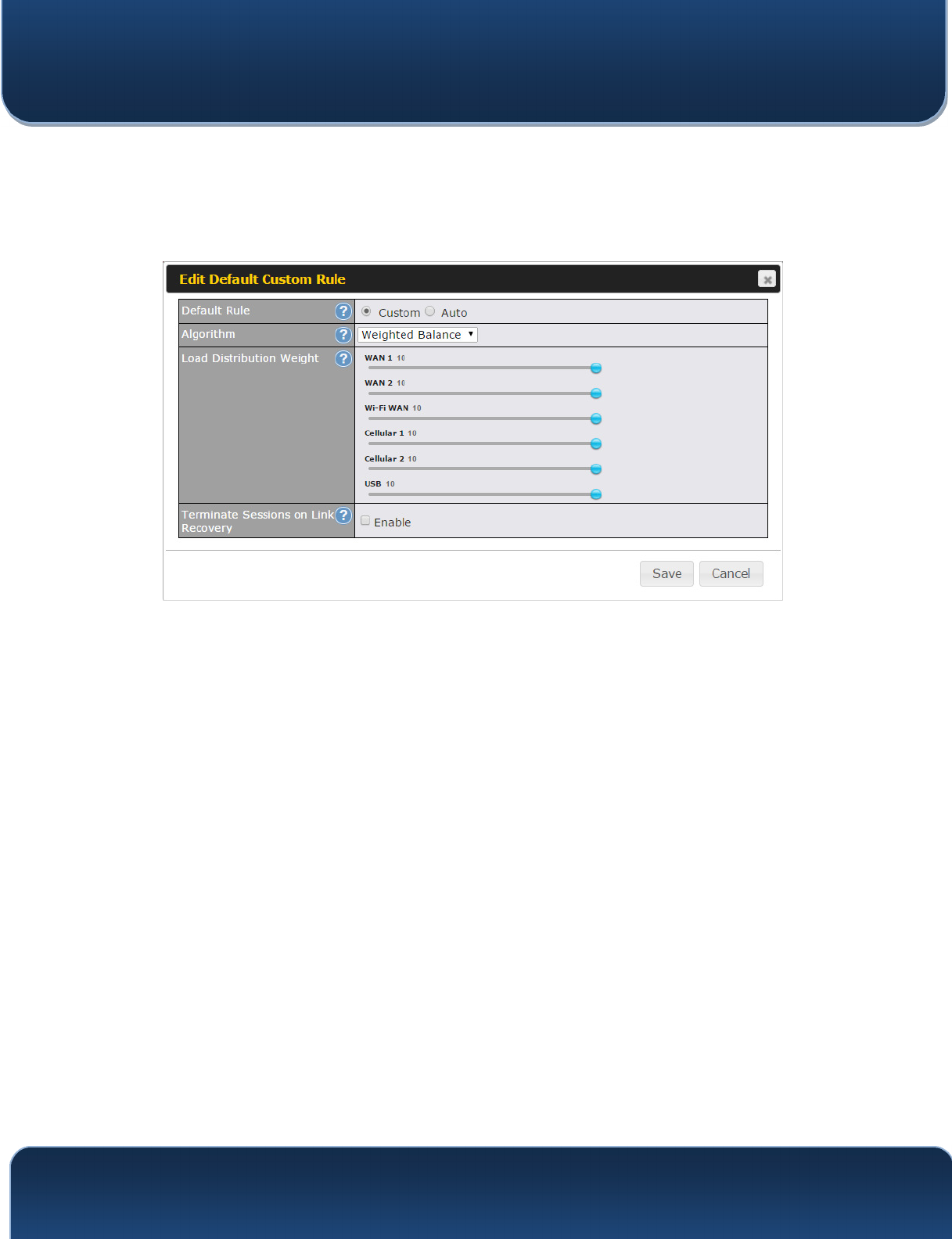
Pepwave MAX and Surf User Manual
http://www.pepwave.com 102 Copyright @ 2016 Pepwave
The bottom-most rule is Default. Edit this rule to change the device’s default manner of
controlling outbound traffic for all connections that do not match any of the rules above
it. Under the Service heading, click Default to change these settings.
To rearrange the priority of outbound rules, drag and drop them into the desired
sequence.
By default, Auto is selected as the Default Rule. You can select Custom to change the
algorithm to be used. Please refer to the upcoming sections for the details on the
available algorithms.
To create a custom rule, click Add Rule at the bottom of the table. Note that some
Pepwave routers display this button at Advanced>PepVPN>PepVPN Outbound
Custom Rules.
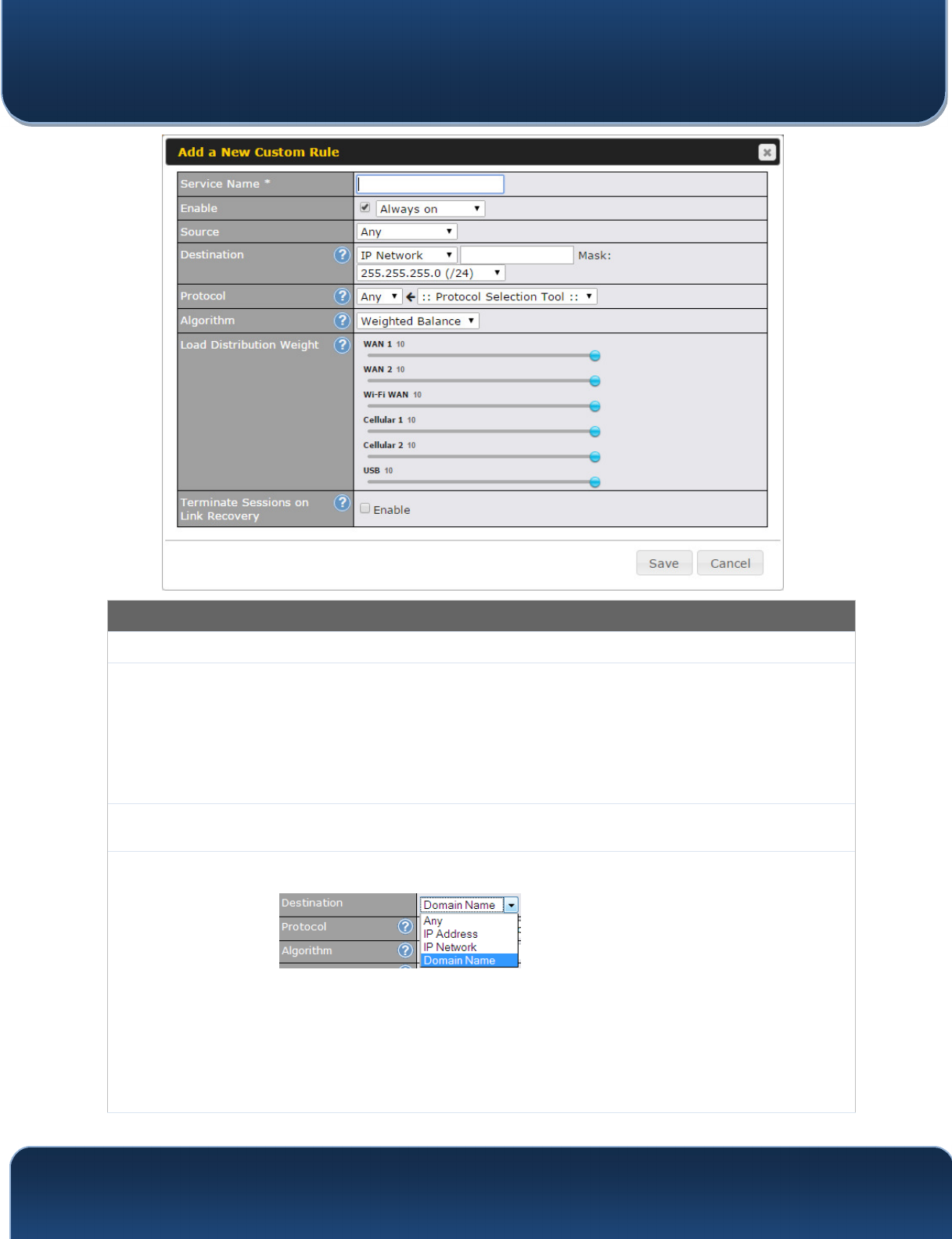
Pepwave MAX and Surf User Manual
http://www.pepwave.com 103 Copyright @ 2016 Pepwave
New Custom Rule Settings
Service Name
This setting specifies the name of the outbound traffic rule.
Enable
This setting specifies whether the outbound traffic rule takes effect. When Enable is
checked, the rule takes effect: traffic is matched and actions are taken by the Pepwave
router based on the other parameters of the rule. When Enable is unchecked, the rule does
not take effect: the Pepwave router disregards the other parameters of the rule.
Click the drop-down menu next to the checkbox to apply a time schedule to this custom
rule.
Source
This setting specifies the source IP address, IP network, or MAC address for traffic that
matches the rule.
Destination
This setting specifies the destination IP address, IP network, or domain name for traffic that
matches the rule.
If Domain Name is chosen and a domain name, such as foobar.com, is entered, any
outgoing accesses to foobar.com and *.foobar.com will match this criterion. You may enter
a wildcard (.*) at the end of a domain name to match any host with a name having the
domain name in the middle. If you enter foobar.*, for example, www.foobar.com,
www.foobar.co.jp, or foobar.co.uk will also match. Placing wildcards in any other position is
not supported.
NOTE: if a server has one Internet IP address and multiple server names, and if one of the
names is defined here, accesses to any one of the server names will also match this rule.

Pepwave MAX and Surf User Manual
http://www.pepwave.com 104 Copyright @ 2016 Pepwave
Protocol and Port
This setting specifies the IP protocol and port of traffic that matches this rule.
Algorithm
This setting specifies the behavior of the Pepwave router for the custom rule.
One of the following values can be selected (note that some Pepwave routers provide only
some of these options):
Weighted Balance
Persistence
Enforced
Priority
Overflow
Least Used
Lowest Latency
The upcoming sections detail the listed algorithms.
Terminate
Sessions on Link
Recovery
This setting specifies whether to terminate existing IP sessions on a less preferred WAN
connection in the event that a more preferred WAN connection is recovered. This setting is
applicable to the Weighted, Persistence, and Priority algorithms. By default, this setting is
disabled. In this case, existing IP sessions will not be terminated or affected when any other
WAN connection is recovered. When this setting is enabled, existing IP sessions may be
terminated when another WAN connection is recovered, such that only the preferred
healthy WAN connection(s) is used at any point in time.
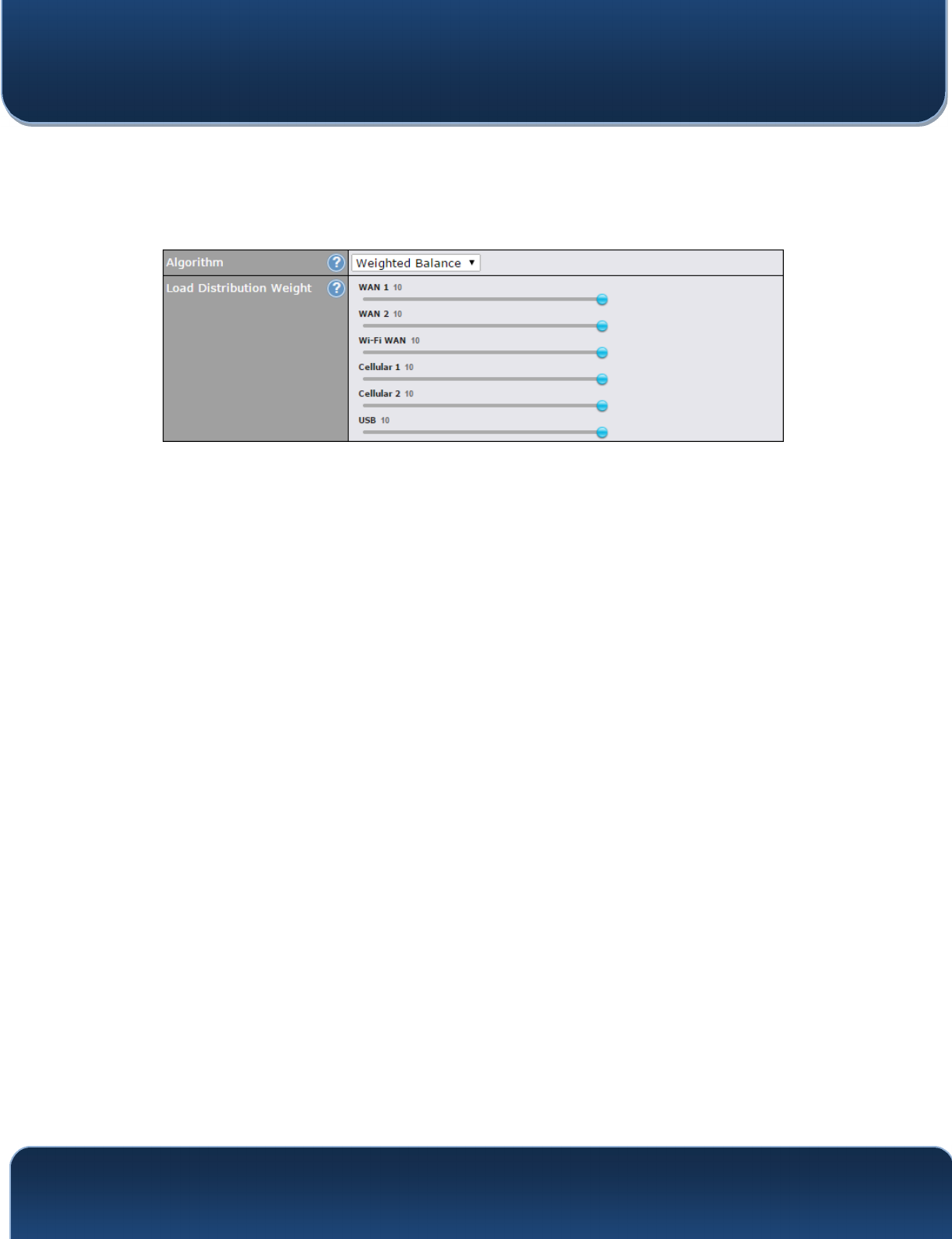
Pepwave MAX and Surf User Manual
http://www.pepwave.com 105 Copyright @ 2016 Pepwave
15.2.1 Algorithm: Weighted Balance
This setting specifies the ratio of WAN connection usage to be applied on the specified
IP protocol and port. This setting is applicable only when Algorithm is set to Weighted
Balance.
The amount of matching traffic that is distributed to a WAN connection is proportional to
the weight of the WAN connection relative to the total weight. Use the sliders to change
each WAN’s weight.
For example, with the following weight settings:
• Ethernet WAN1: 10
• Ethernet WAN2: 10
• Wi-Fi WAN: 10
• Cellular 1: 10
• Cellular 2: 10
• USB: 10
Total weight is 60 = (10 +10 + 10 + 10 + 10 + 10).
Matching traffic distributed to Ethernet WAN1 is 16.7% = (10 / 60 x 100%.
Matching traffic distributed to Ethernet WAN2 is 16.7% = (10 / 60) x 100%.
Matching traffic distributed to Wi-Fi WAN is 16.7% = (10 / 60) x 100%.
Matching traffic distributed to Cellular 1 is 16.7% = (10 / 60) x 100%.
Matching traffic distributed to Cellular 2 is 16.7% = (10 / 60) x 100%.
Matching traffic distributed to USB is 16.7% = (10 / 60) x 100%.
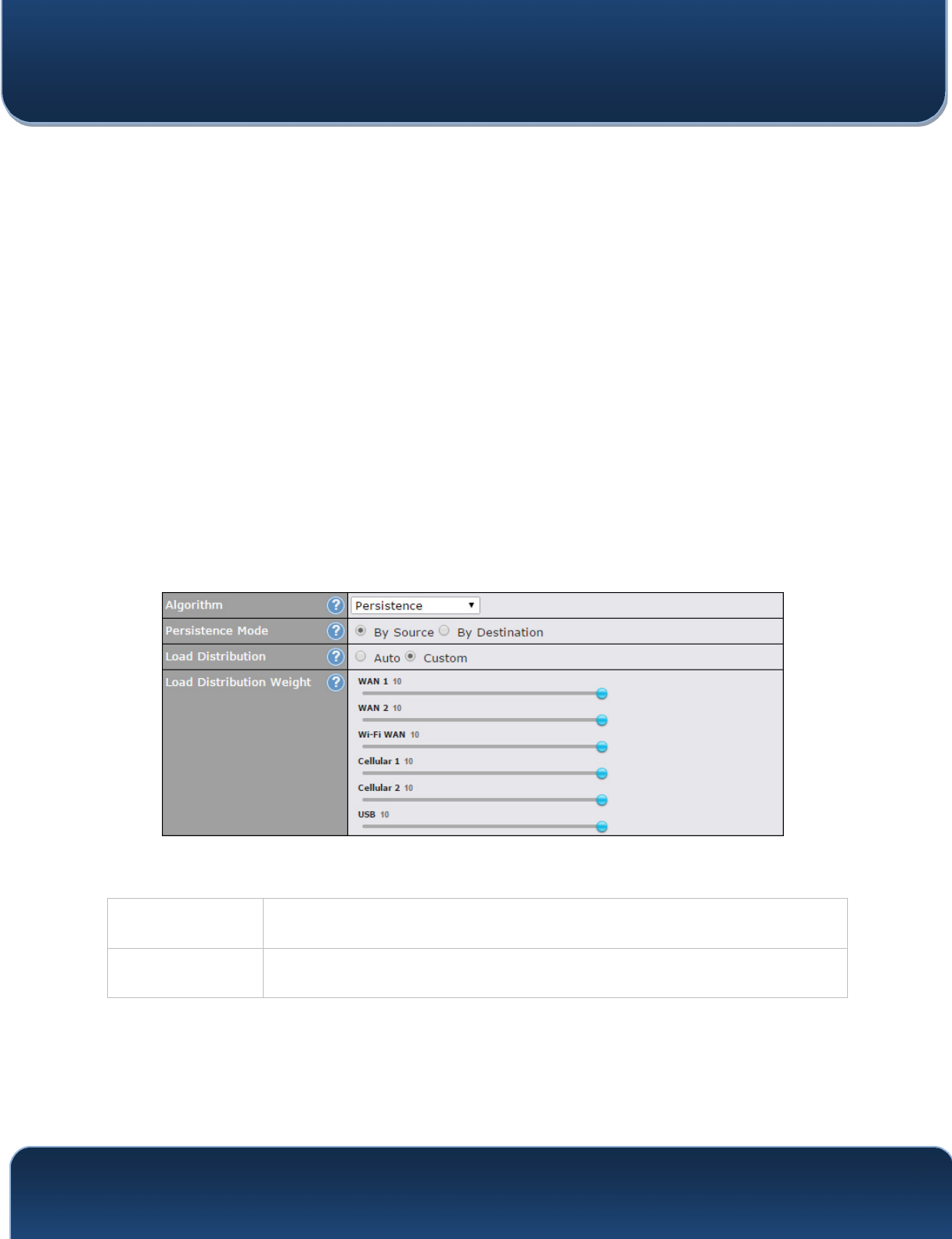
Pepwave MAX and Surf User Manual
http://www.pepwave.com 106 Copyright @ 2016 Pepwave
15.2.2 Algorithm: Persistence
The configuration of persistent services is the solution to the few situations where link
load distribution for Internet services is undesirable. For example, for security reasons,
many e-banking and other secure websites terminate the session when the client
computer’s Internet IP address changes mid-session.
In general, different Internet IP addresses represent different computers. The security
concern is that an IP address change during a session may be the result of an
unauthorized intrusion attempt. Therefore, to prevent damages from the potential
intrusion, the session is terminated upon the detection of an IP address change.
Pepwave routers can be configured to distribute data traffic across multiple WAN
connections. Also, the Internet IP depends on the WAN connections over which
communication actually takes place. As a result, a LAN client computer behind the
Pepwave router may communicate using multiple Internet IP addresses. For example, a
LAN client computer behind a Pepwave router with three WAN connections may
communicate on the Internet using three different IP addresses.
With the persistence feature, rules can be configured to enable client computers to
persistently utilize the same WAN connections for e-banking and other secure websites.
As a result, a client computer will communicate using one IP address, eliminating the
issues mentioned above.
There are two persistent modes: By Source and By Destination.
By Source: The same WAN connection will be used for traffic matching the rule and originating from
the same machine, regardless of its destination. This option will provide the highest level
of application compatibility.
By Destination: The same WAN connection will be used for traffic matching the rule, originating from the
same machine, and going to the same destination. This option can better distribute loads
to WAN connections when there are only a few client machines.
The default mode is By Source. When there are multiple client requests, they can be
distributed (persistently) to WAN connections with a weight. If you choose Auto in Load
Distribution, the weights will be automatically adjusted according to each WAN’s
Downstream Bandwidth which is specified in the WAN settings page). If you choose
Custom, you can customize the weight of each WAN manually by using the sliders.
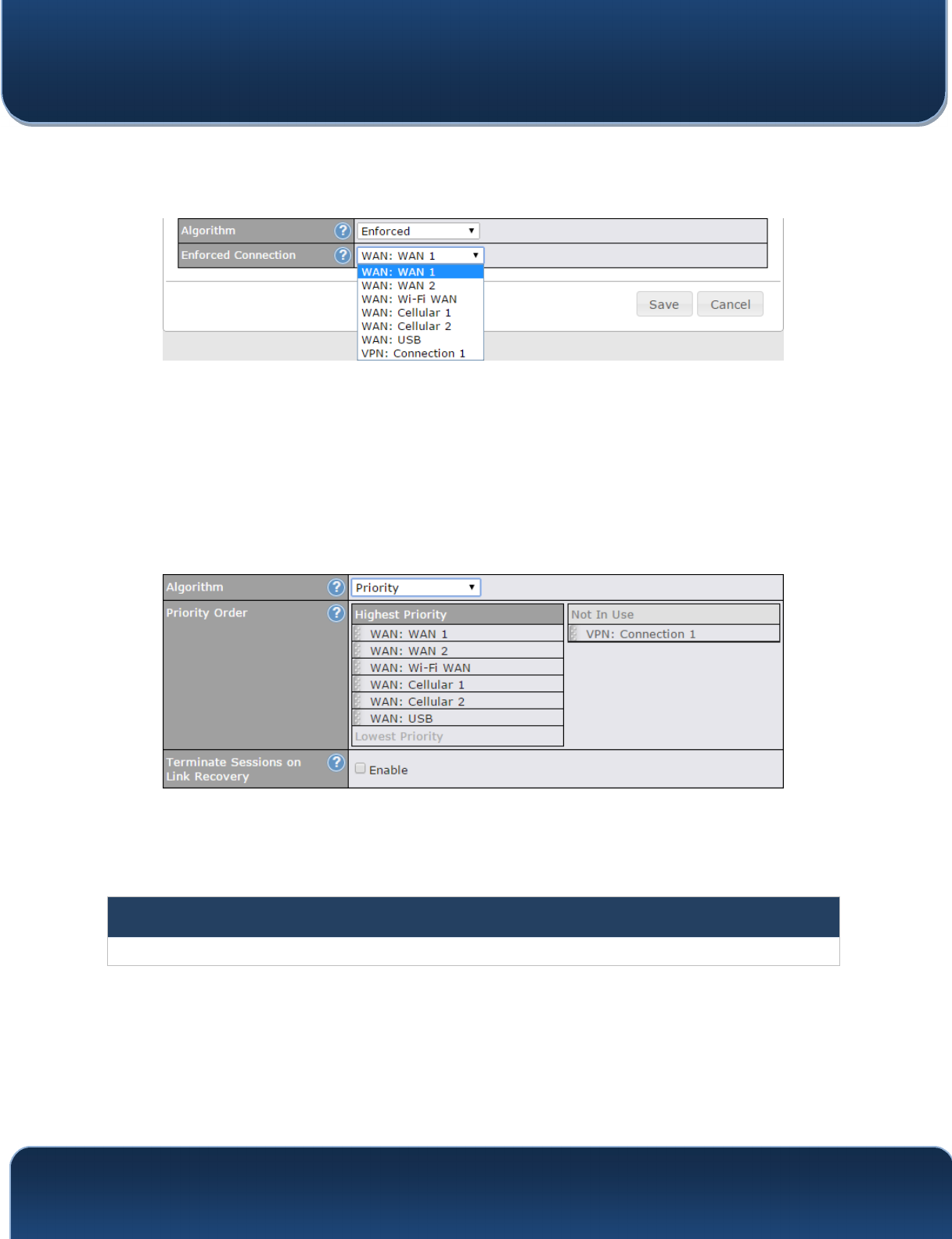
Pepwave MAX and Surf User Manual
http://www.pepwave.com 107 Copyright @ 2016 Pepwave
15.2.3 Algorithm: Enforced
This setting specifies the WAN connection usage to be applied on the specified IP
protocol and port. This setting is applicable only when Algorithm is set to Enforced.
Matching traffic will be routed through the specified WAN connection, regardless of the
health check status of the WAN connection. Starting from Firmware 5.2, outbound traffic
can be enforced to go through a specified SpeedFusion
TM
connection.
15.2.4 Algorithm: Priority
This setting specifies the priority of the WAN connections used to route the specified
network service. The highest priority WAN connection available will always be used for
routing the specified type of traffic. A lower priority WAN connection will be used only
when all higher priority connections have become unavailable.
Starting from Firmware 5.2, outbound traffic can be prioritized to go through
SpeedFusion
TM
connection(s). By default, VPN connections are not included in the
priority list.
Tip
Configure multiple distribution rules to accommodate different kinds of services.
15.2.5 Algorithm: Overflow
The traffic matching this rule will be routed through the healthy WAN connection that
has the highest priority and is not in full load. When this connection gets saturated, new
sessions will be routed to the next healthy WAN connection that is not in full load.
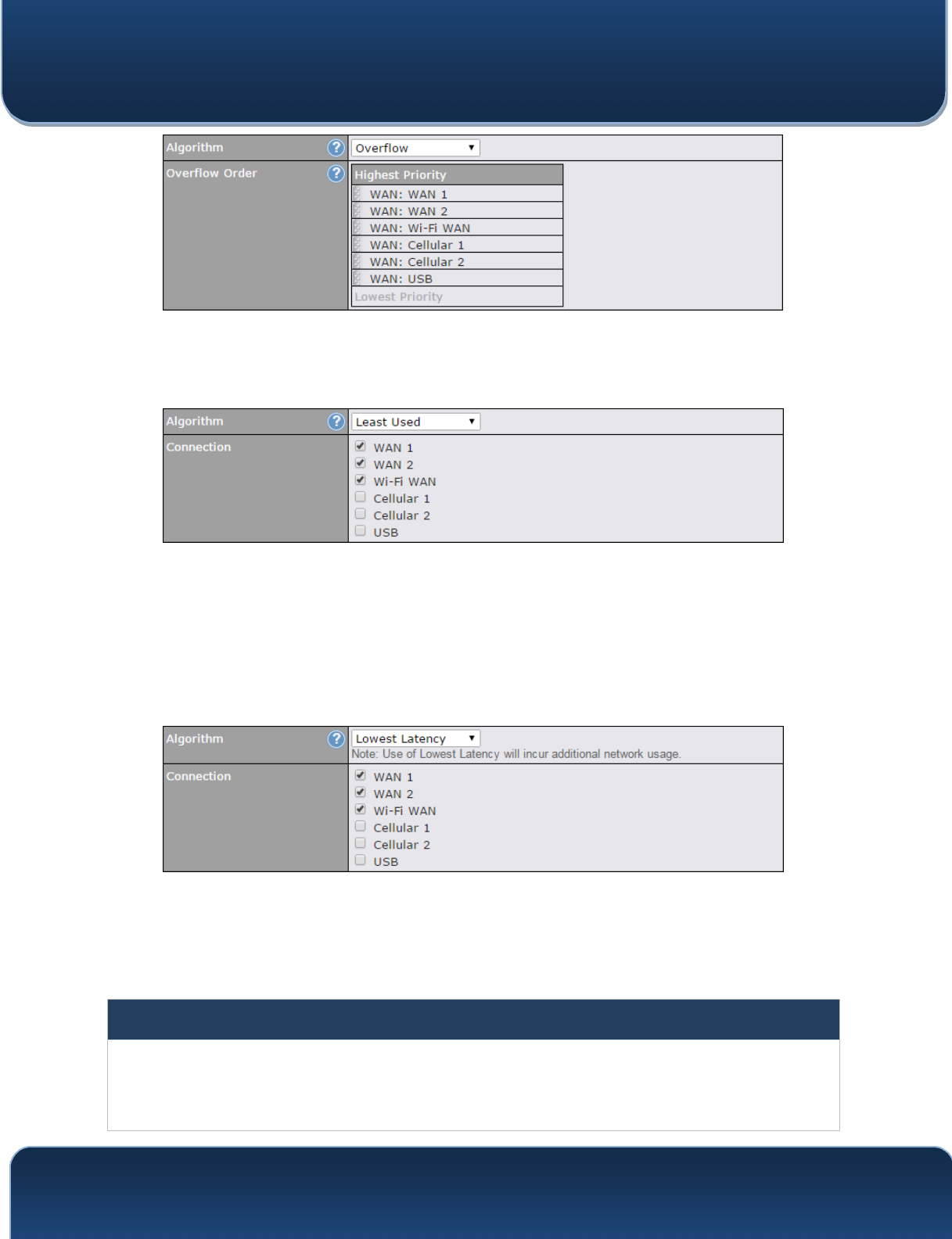
Pepwave MAX and Surf User Manual
http://www.pepwave.com 108 Copyright @ 2016 Pepwave
Drag and drop to specify the order of WAN connections to be used for routing traffic.
Only the highest priority healthy connection that is not in full load will be used.
15.2.6 Algorithm: Least Used
The traffic matching this rule will be routed through the healthy WAN connection that is
selected in Connection and has the most available download bandwidth. The available
download bandwidth of a WAN connection is calculated from the total download
bandwidth specified on the WAN settings page and the current download usage. The
available bandwidth and WAN selection is determined every time an IP session is
made.
15.2.7 Algorithm: Lowest Latency
The traffic matching this rule will be routed through the healthy WAN connection that is
selected in Connection and has the lowest latency. Latency checking packets are
issued periodically to a nearby router of each WAN connection to determine its latency
value. The latency of a WAN is the packet round trip time of the WAN connection.
Additional network usage may be incurred as a result.
Tip
The roundtrip time of a 6M down/640k uplink can be higher than that of a 2M down/2M up link because the overall
round trip time is lengthened by its slower upload bandwidth, despite its higher downlink speed. Therefore, this
algorithm is good for two scenarios:
• All WAN connections are symmetric; or
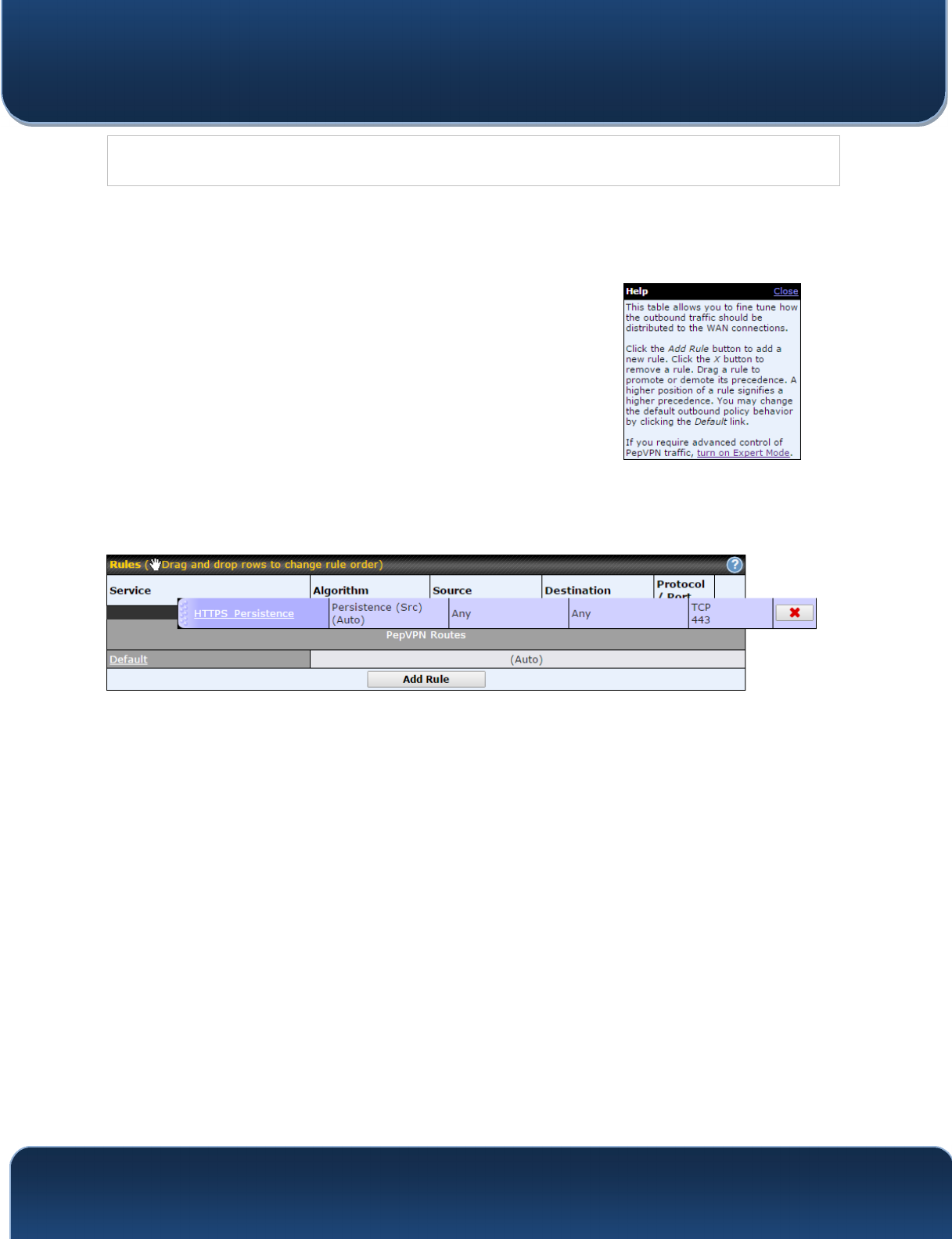
Pepwave MAX and Surf User Manual
http://www.pepwave.com 109 Copyright @ 2016 Pepwave
• A latency sensitive application must be routed through the lowest latency WAN, regardless of the WAN’s
available bandwidth.
15.2.8 Expert Mode
Expert Mode is available on some Pepwave routers for use
by advanced users. To enable the feature, click on the help
icon and click turn on Expert Mode.
In Expert Mode, a new special rule, SpeedFusion
TM
Routes, is displayed in the Custom Rules table. This rule
represents all SpeedFusion
TM
routes learned from remote
VPN peers. By default, this bar is on the top of all custom
rules. This position means that traffic for remote VPN
subnets will be routed to the corresponding VPN peer. You
can create custom Priority or Enforced rules and move them
above the bar to override the SpeedFusion
TM
routes.
Upon disabling Expert Mode, all rules above the bar will be removed.